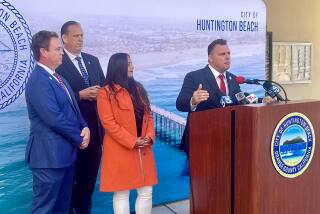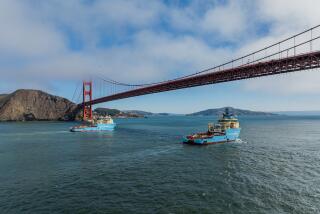Refugio oil spill may have been costlier, bigger than projected
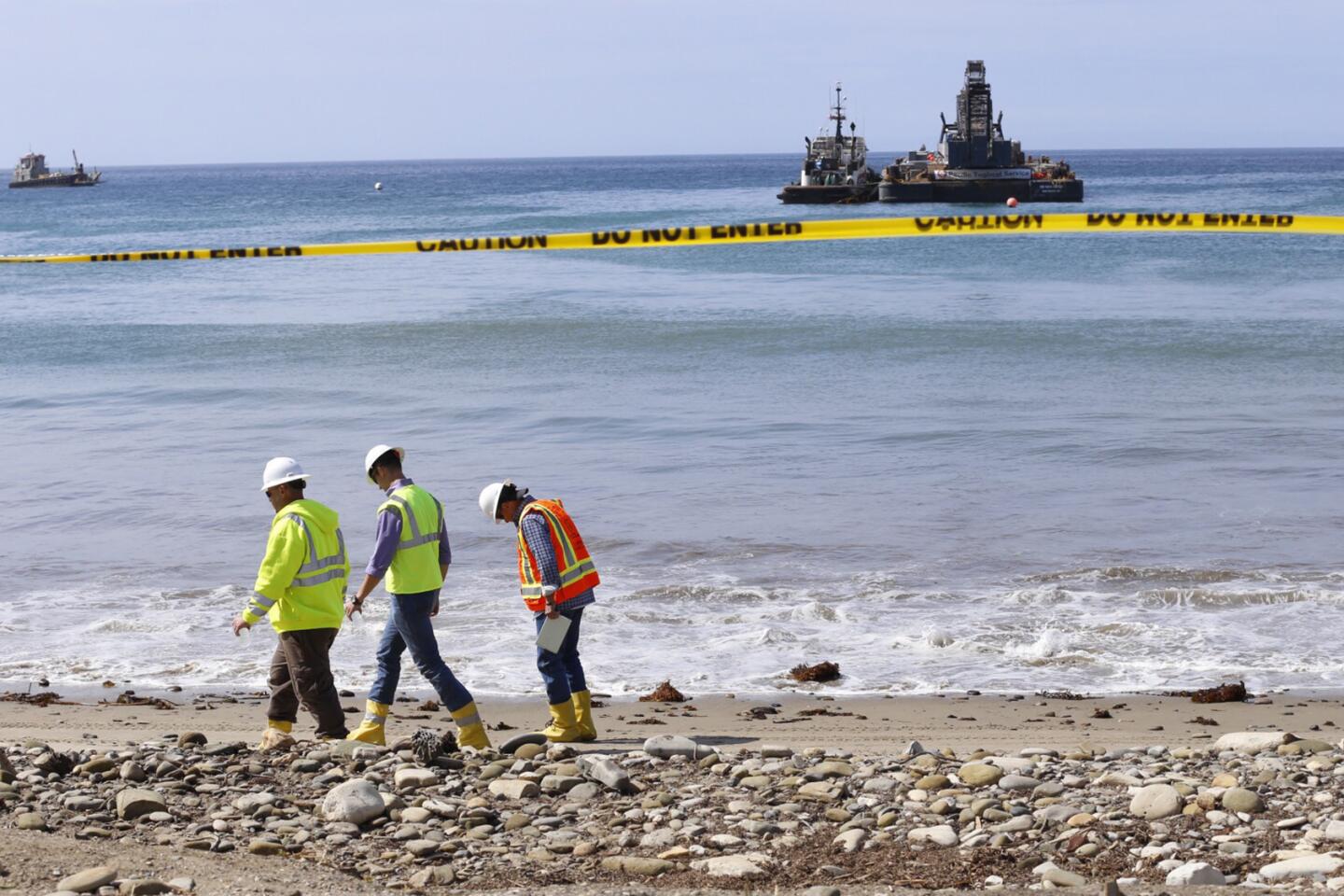
With boats offshore, cleanup efforts continue at Refugio State Beach on Thursday morning June 4, 2015.
(Al Seib / Los Angeles Times)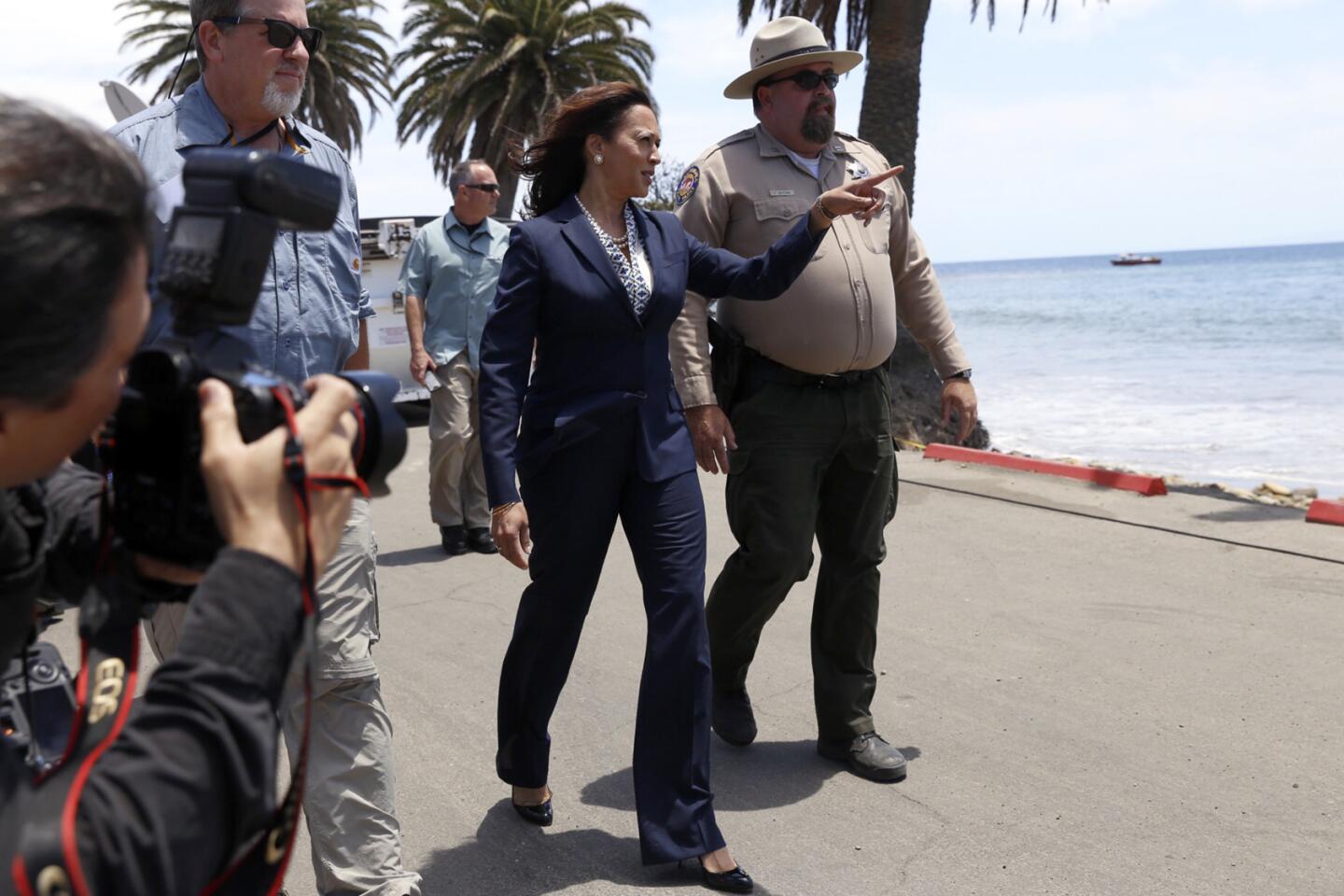
State Atty. Gen. and U.S. Senate candidate Kamala Harris, center, is briefed by Tyson Butzke, right, a superintendent with California State Parks, and Tom Cullen, left, of the Department of Fish and Wildlife, at Refugio State Beach on Thursday.
(Al Seib / Los Angeles Times)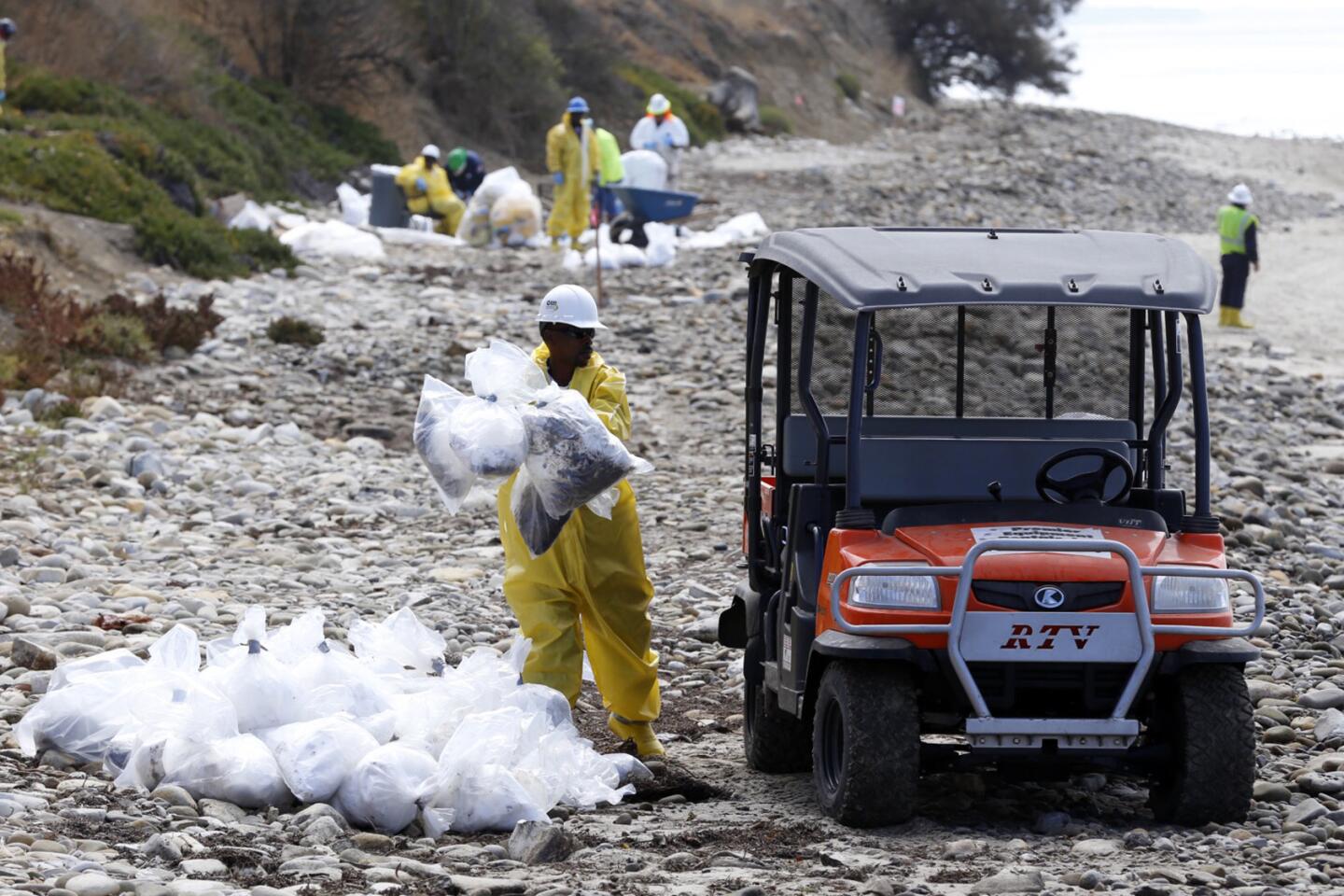
Workers load debris from cleanup efforts at Refugio State Beach on Thursday, June 4, 2015.
(Al Seib / Los Angeles Times)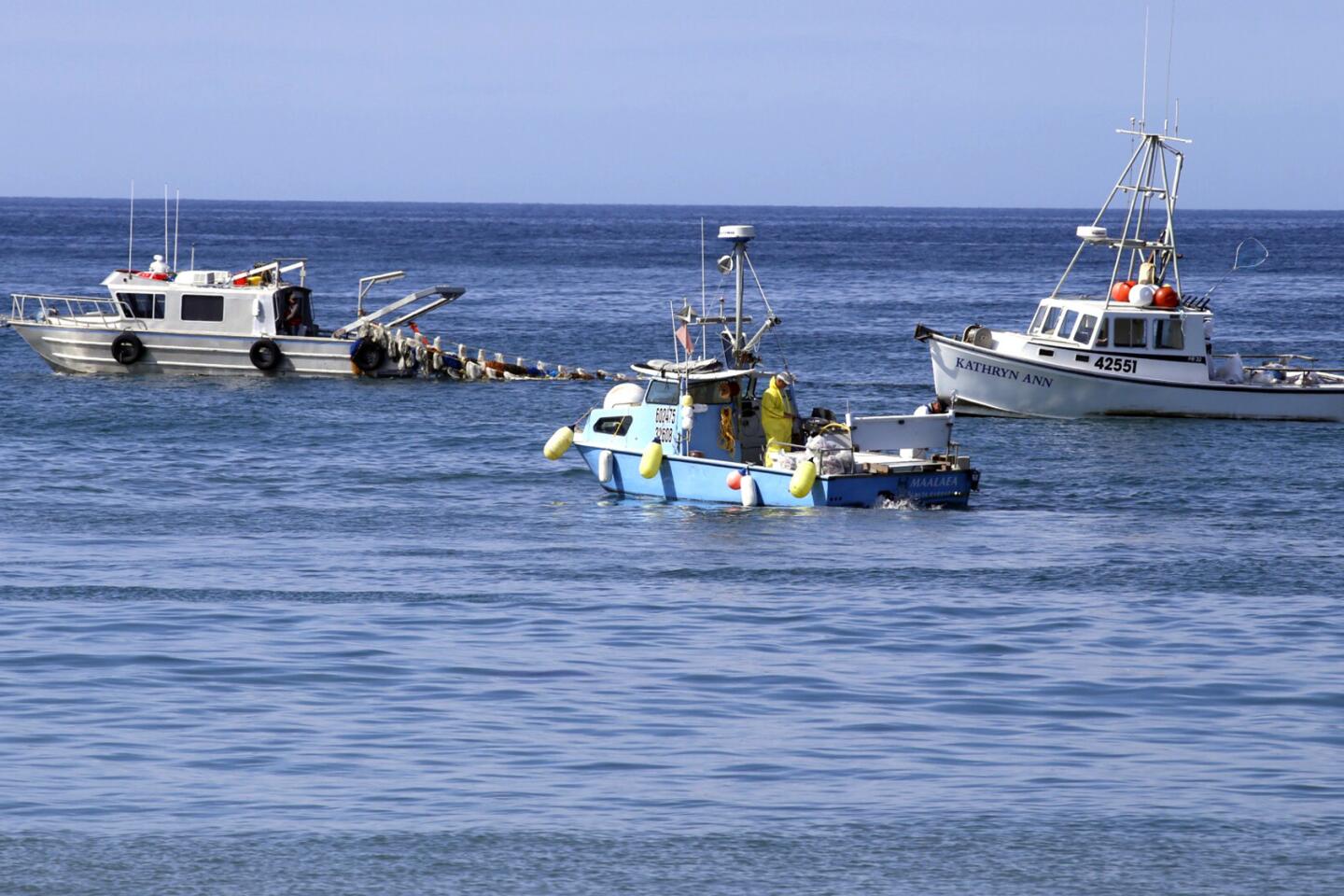
Boats offshore continue cleanup efforts along the beach at Refugio State Beach on Thursday, June 4, 2015.
(Al Seib / Los Angeles Times)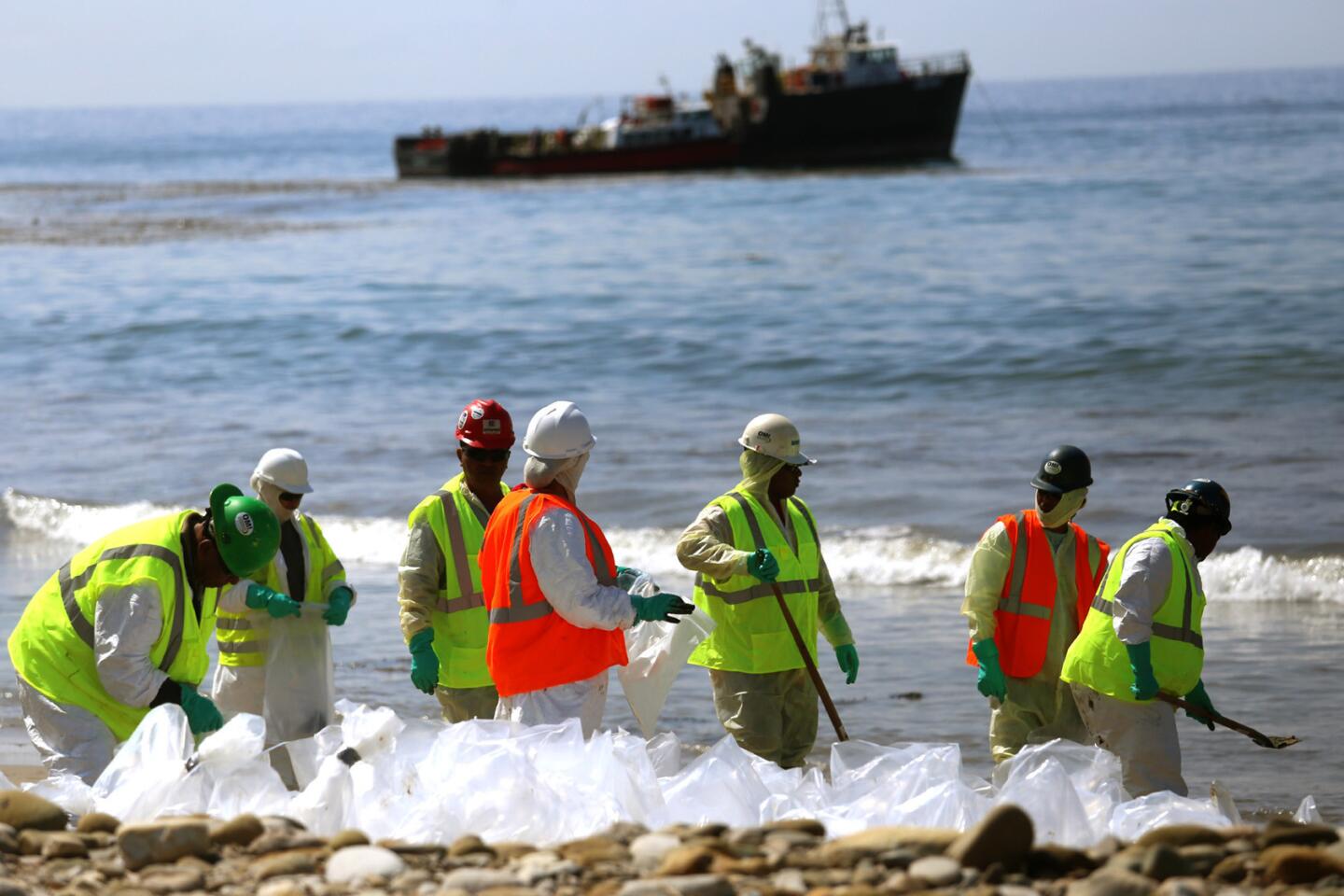
Patriot Environmental Services workers continue May 27 to clean the shoreline at Refugio State Beach in Goleta. On May 19, a privately owned crude oil pipeline ruptured, causing an oil spill within and around Refugio State Beach. Santa Barbara County beaches affected by the spill are expected to remain closed until June 4.
(Genaro Molina / Los Angeles Times)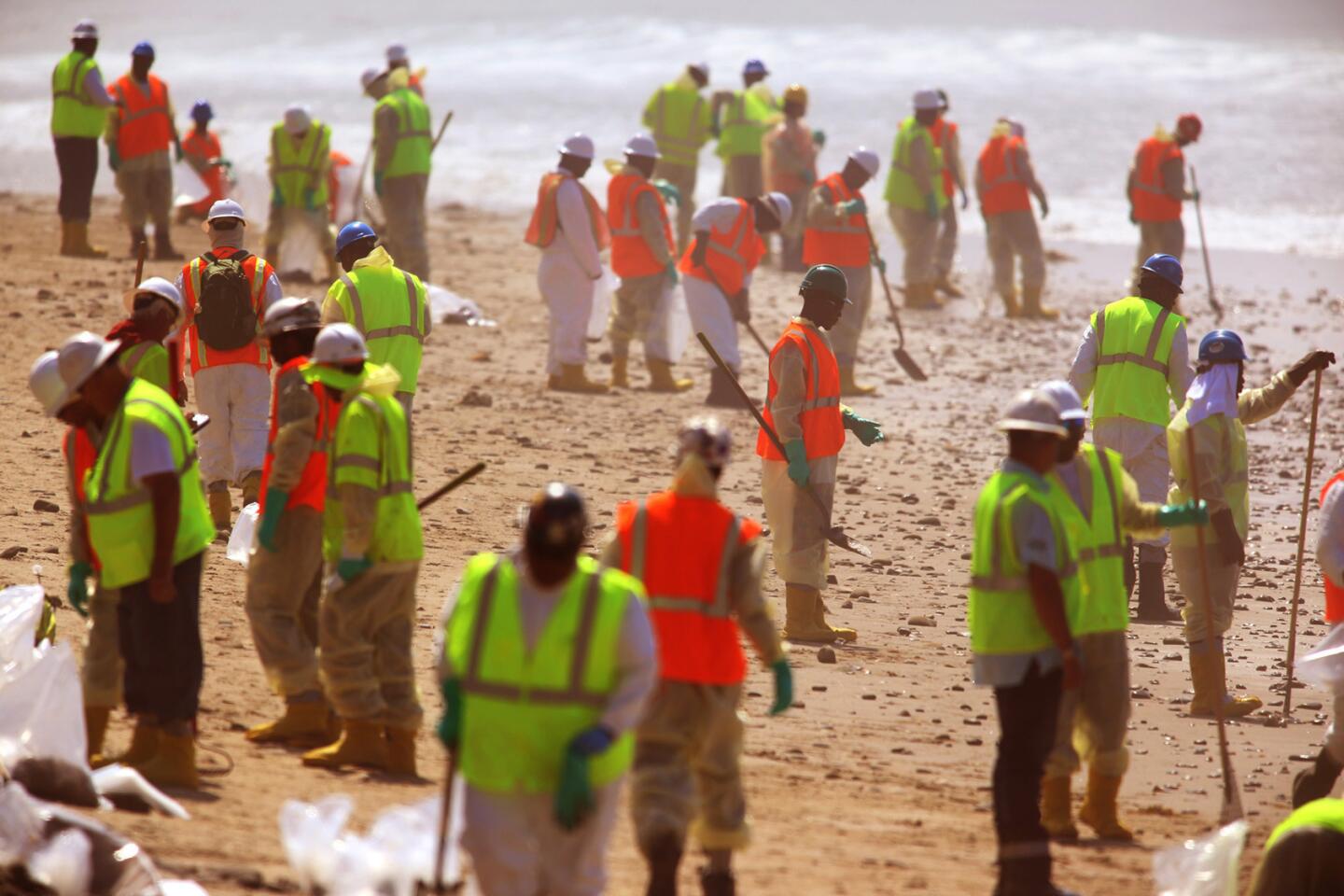
Patriot Environmental Services workers work May 27 to clean Refugio State Beach.
(Genaro Molina / Los Angeles Times)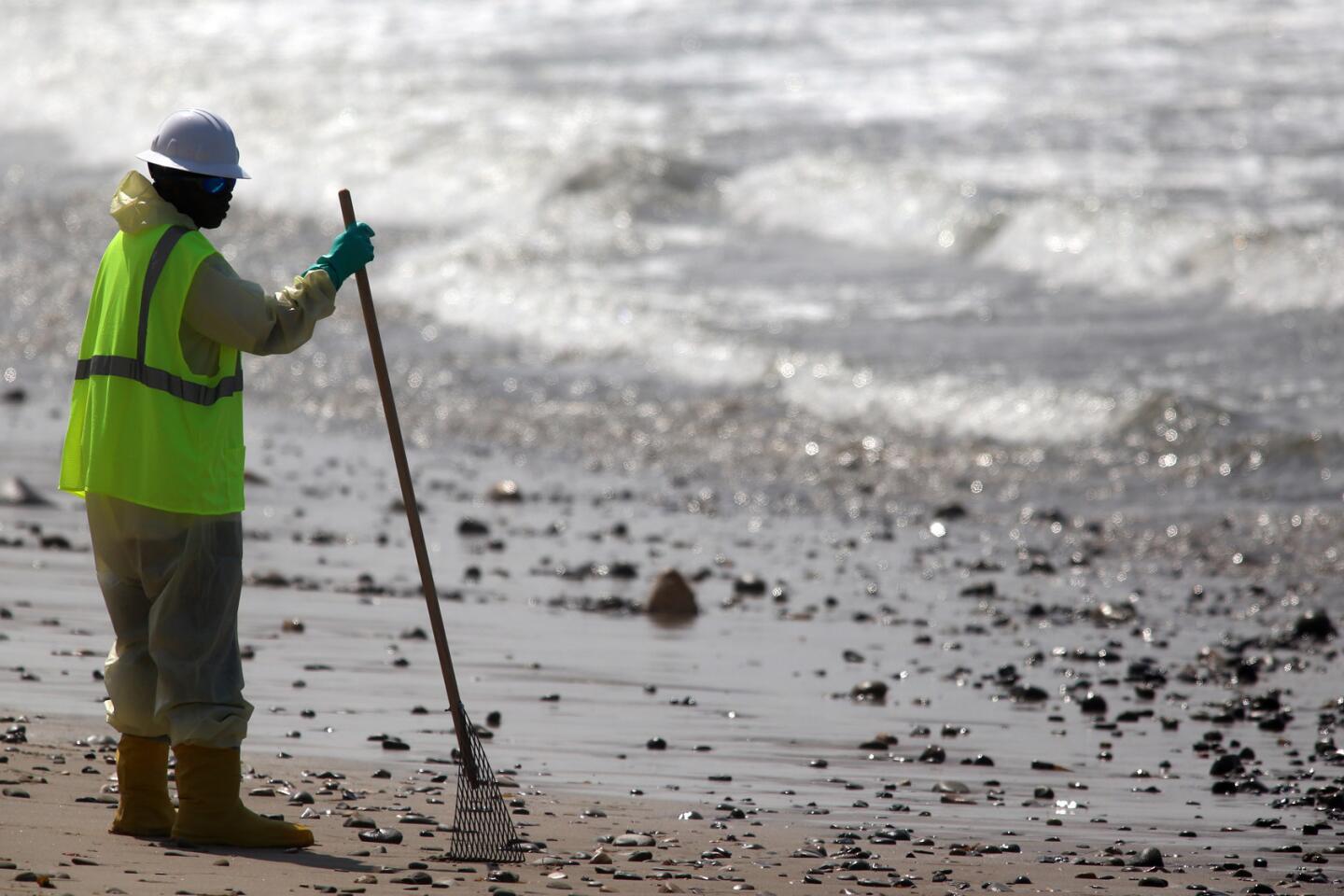
A Patriot Environmental Services worker looks out May 27 over the Pacific Ocean during cleanup at Refugio State Beach.
(Genaro Molina / Los Angeles Times)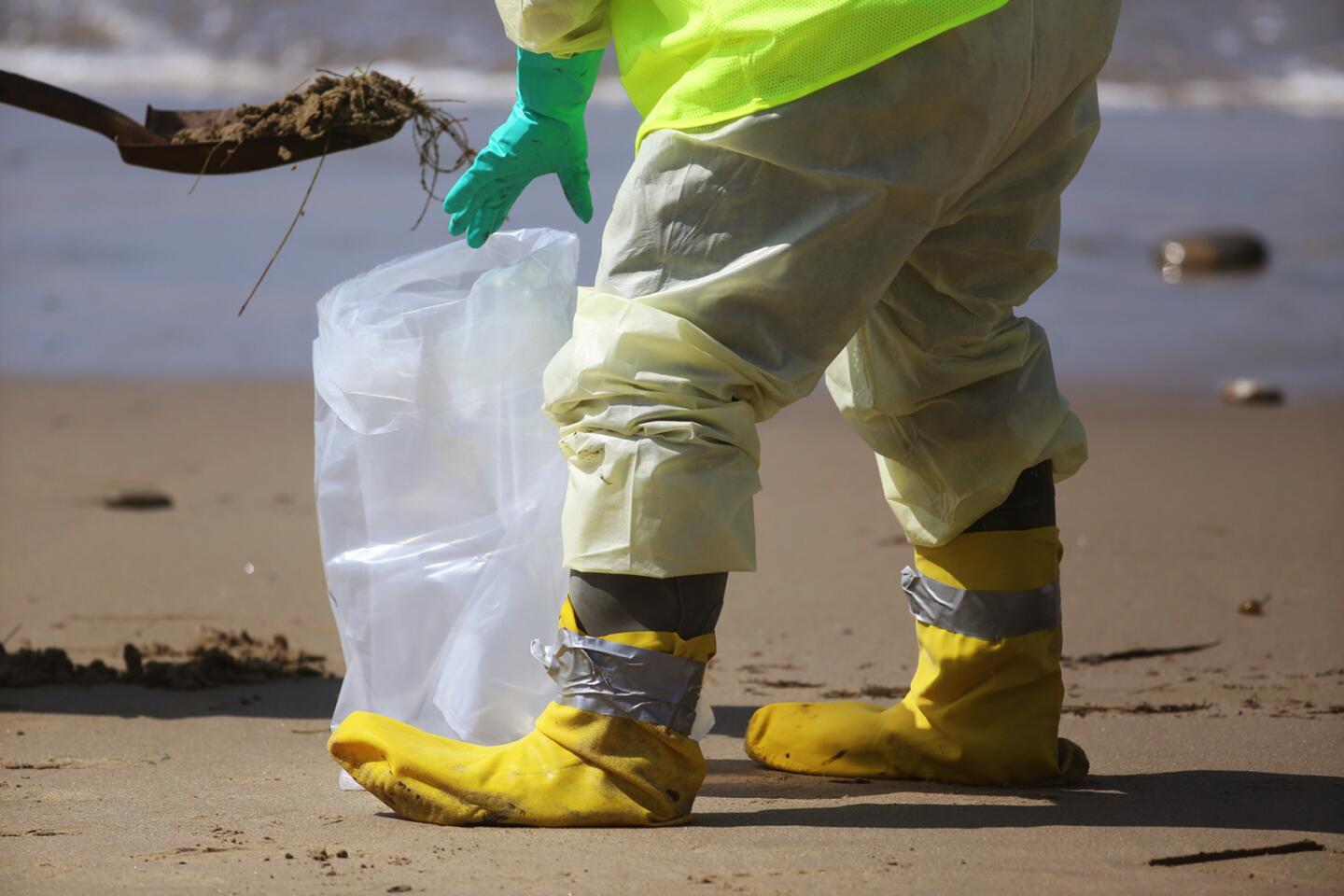
Patriot Environmental Services workers clean the shoreline May 27 at Refugio State Beach.
(Genaro Molina / Los Angeles Times)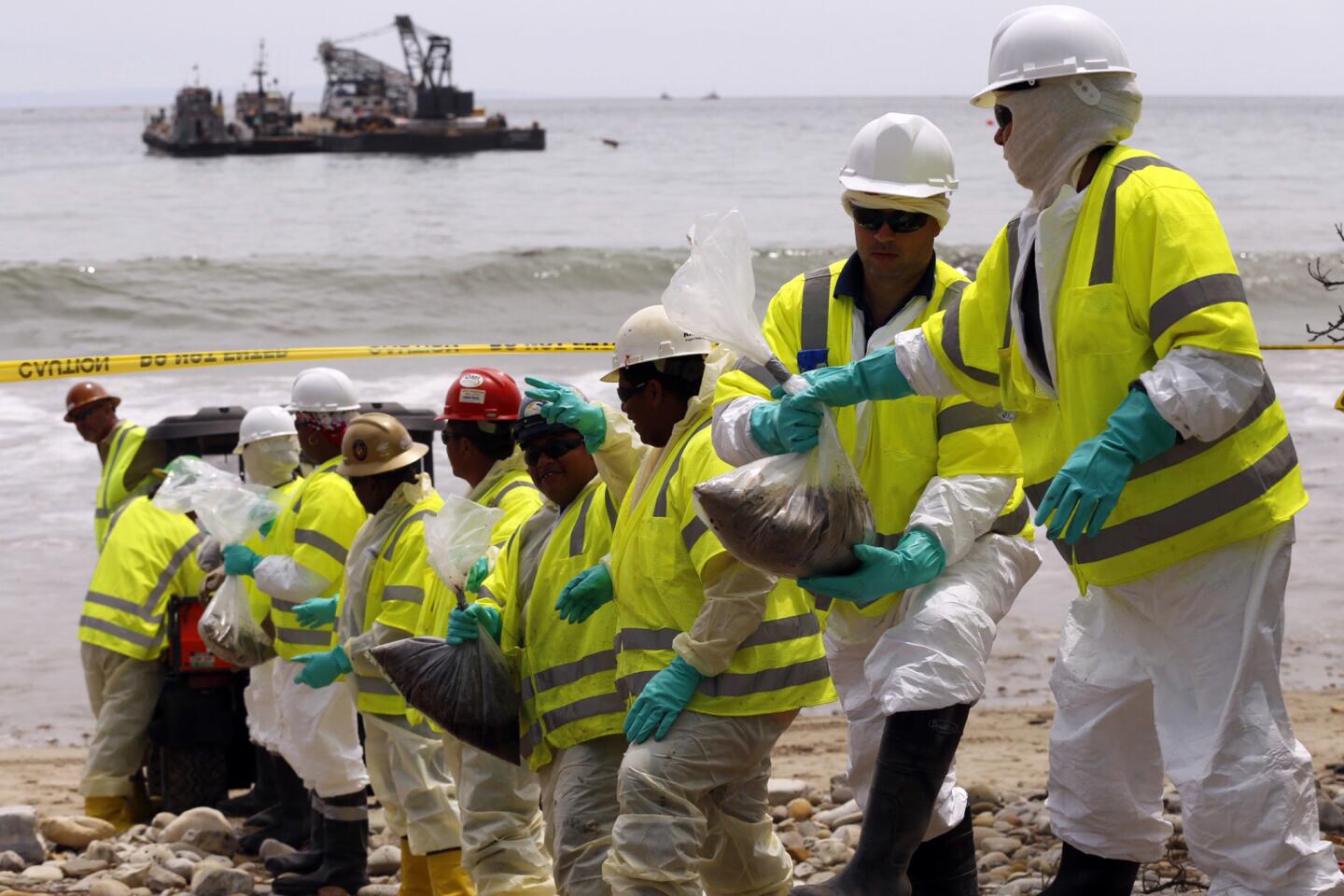
Crews in protective gear form a line to move bags if oiled sand into collection bins ad they work to clean sand at Refugio State Beach on the Gaviota Coast west of Goleta, one week after crude oil spilled into the ocean.
(Al Seib / Los Angeles Times)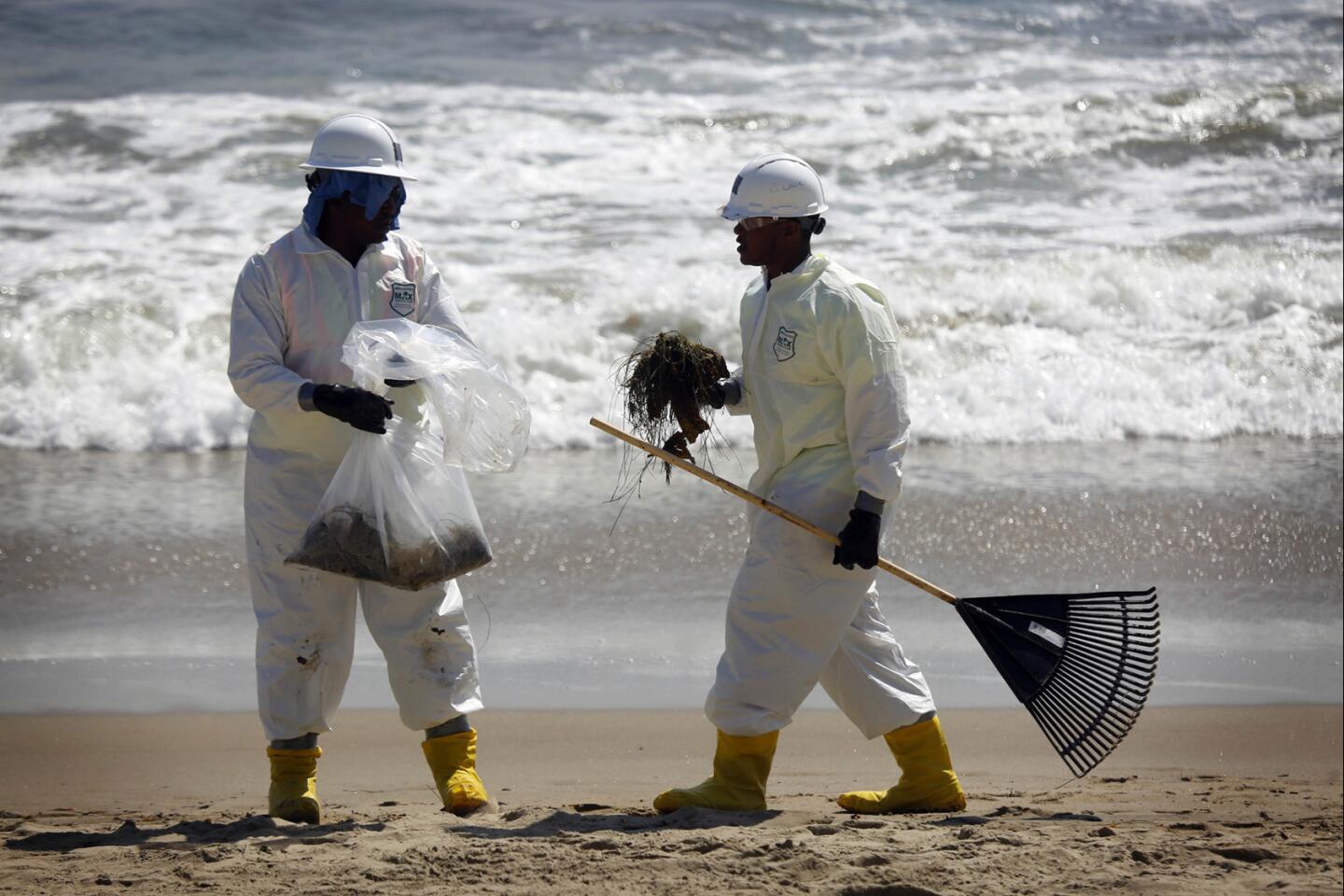
Crews work to clean the crude-stained coastline at El Capitan State Beach. Authorities have intensified their response to the Santa Barbara oil spill by announcing remedies and additional investigations.
(Barbara Davidson / Los Angeles Times)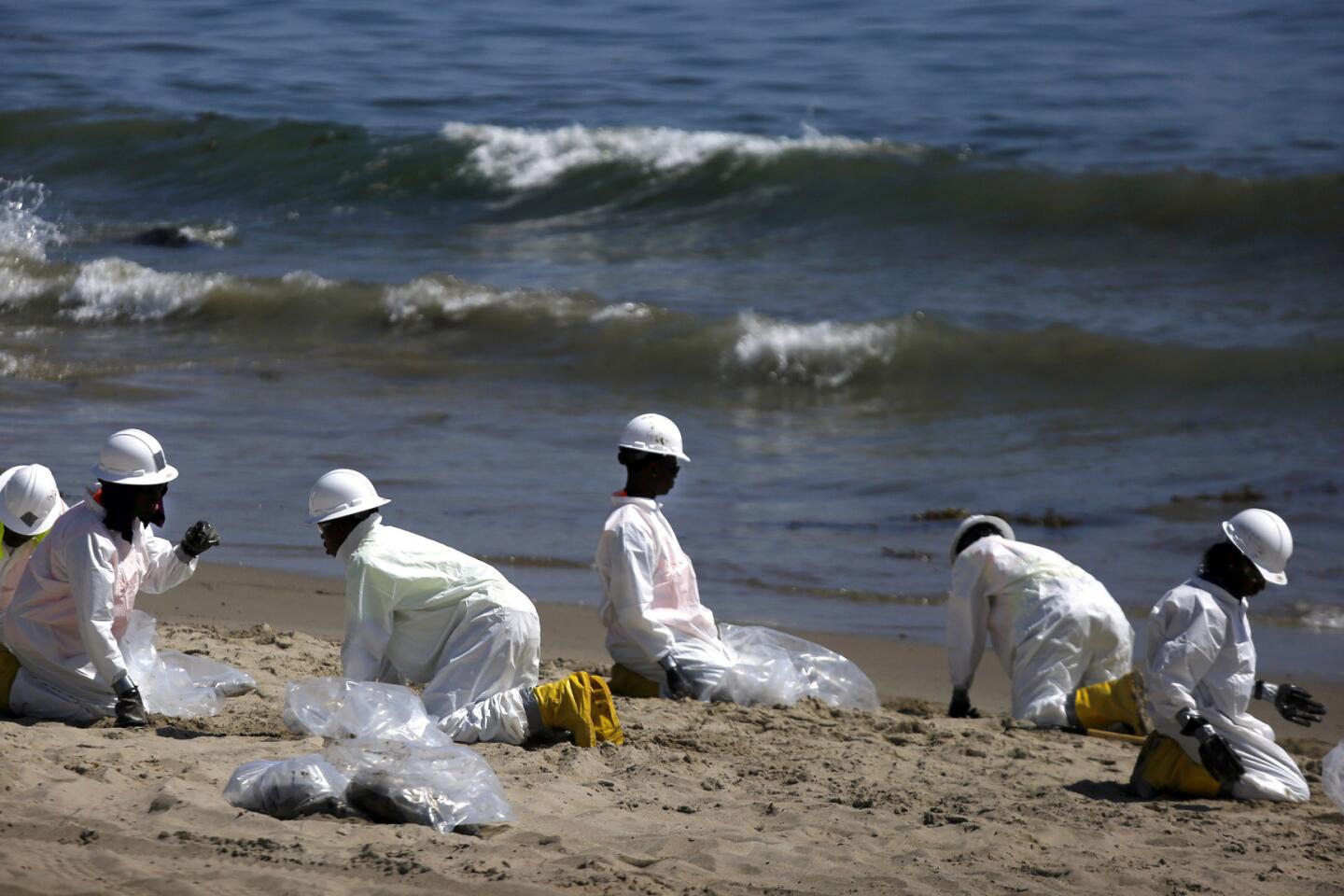
Cleanup crews scour the sand at El Capitan State Beach.
(Barbara Davidson / Los Angeles Times)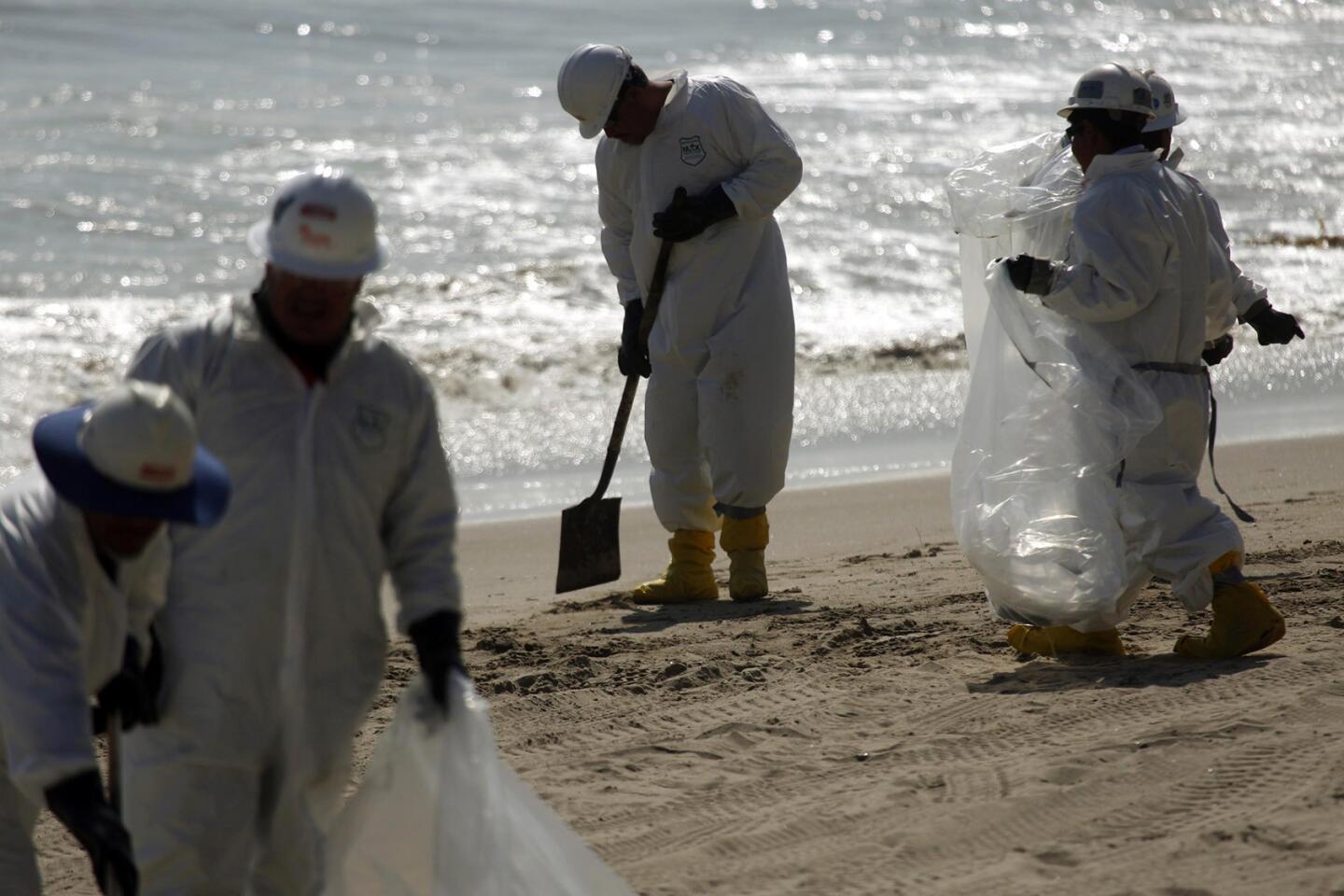
Shovels, bags and protective clothing are part of the cleanup gear.
(Marta Iwanek / For The Times)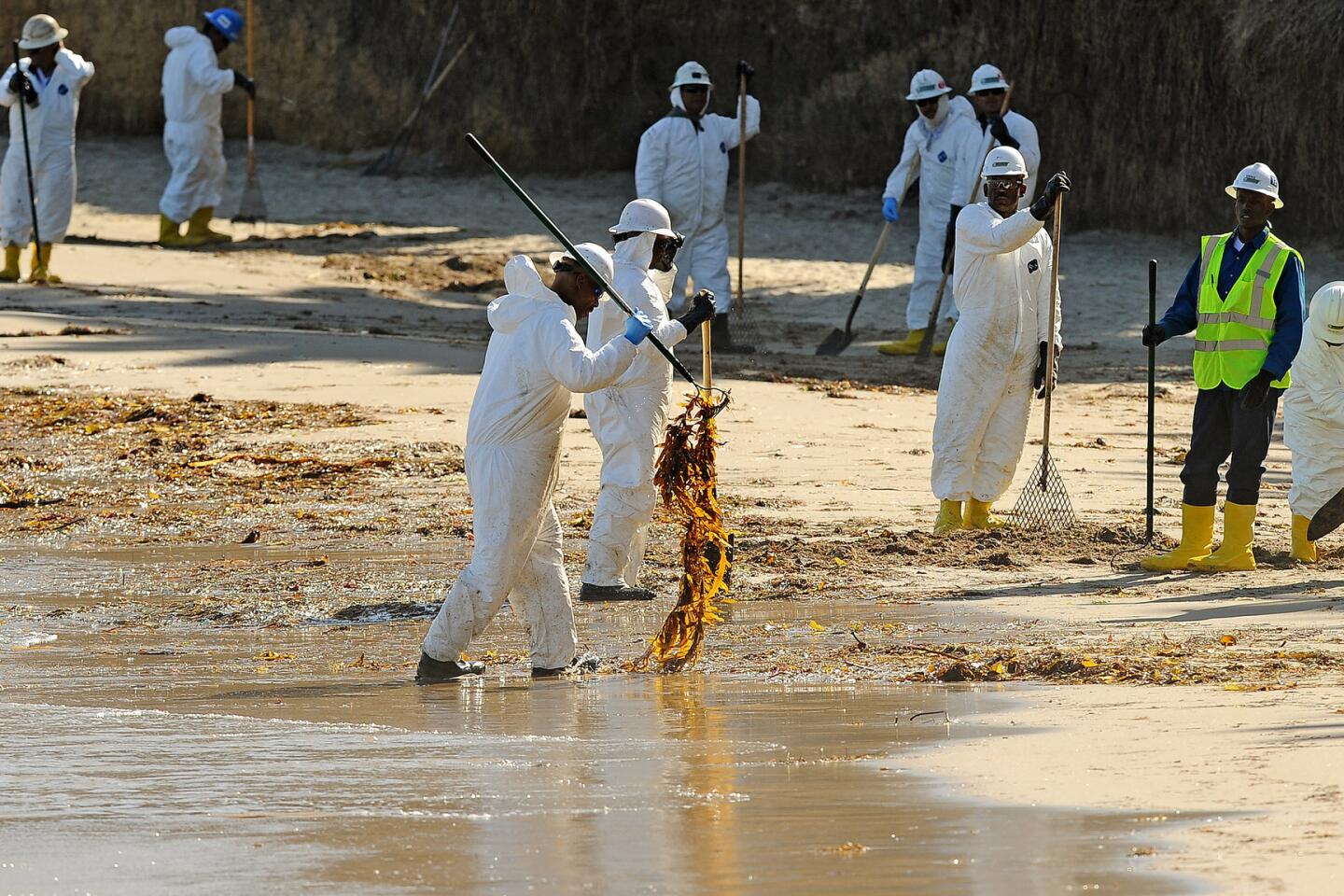
Oil spill cleanup at Refugio State Beach.
(Christina House / For The Times)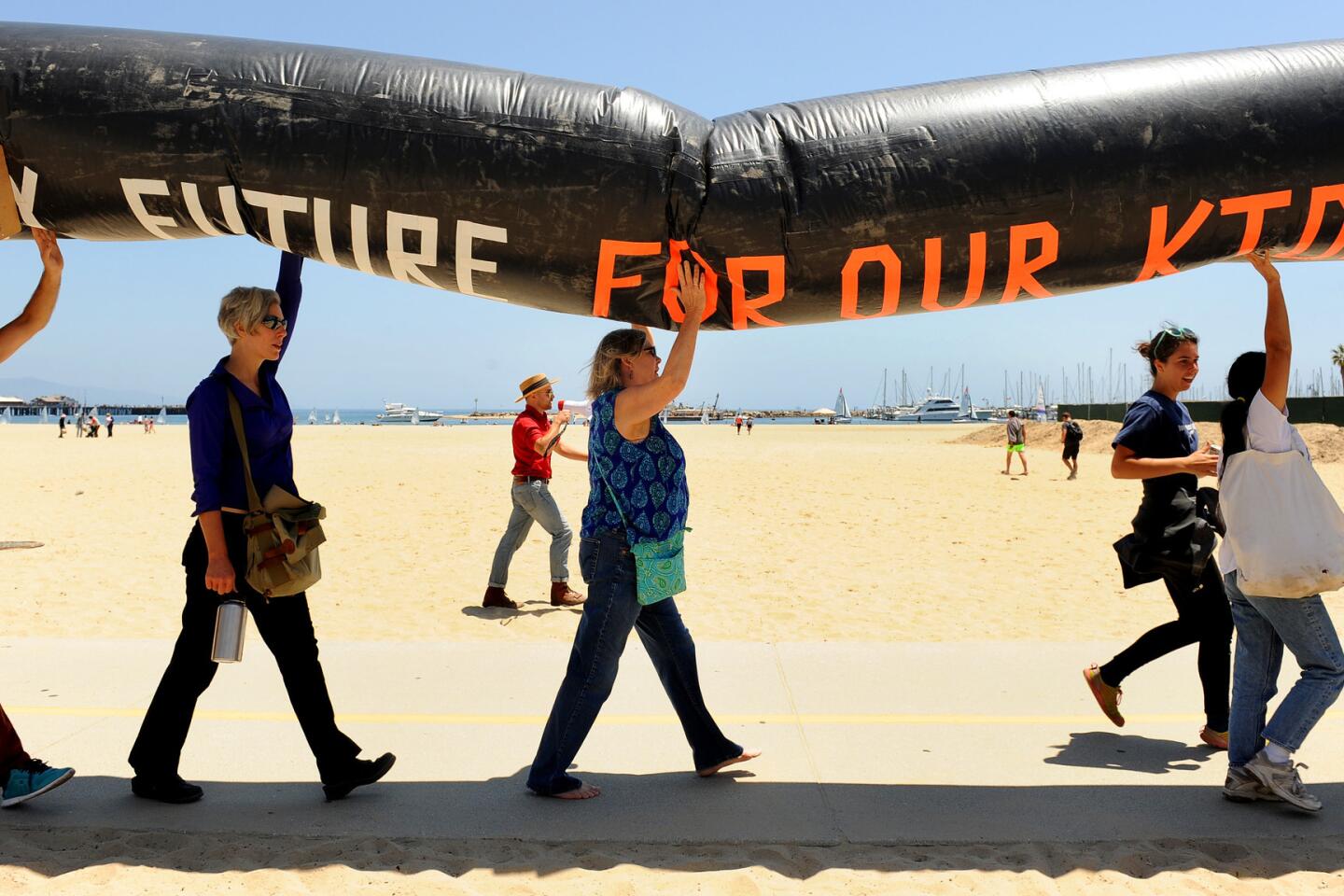
Concerned residents rally at the beach south of the Santa Barbara to call for a stop to fracking and push for alternative energy.
(Christina House / For The Times)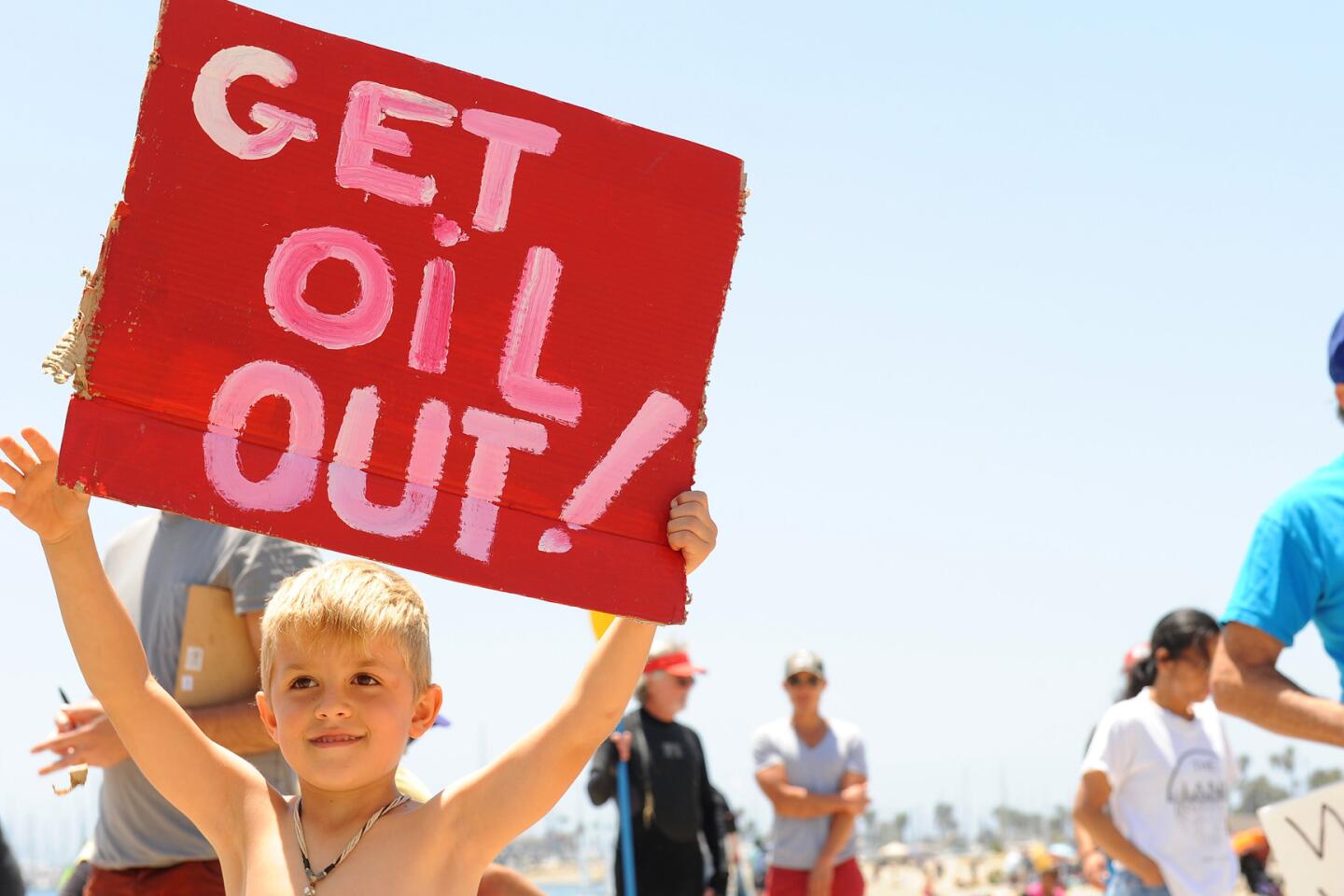
Sebastian has a message for oil companies.
(Christina House / For The Times)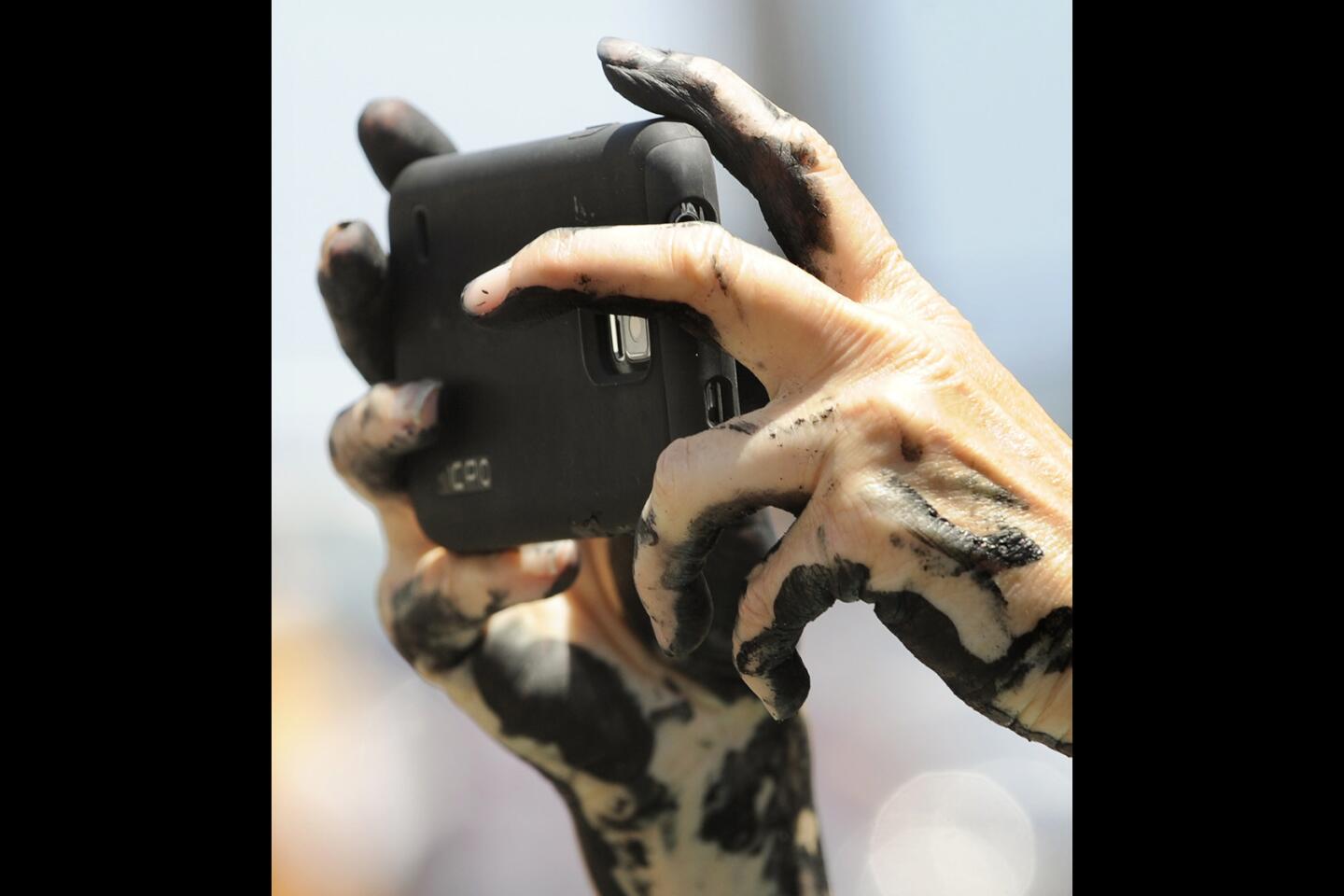
Amy Turnbull of Sherman Oaks takes a photograph while participating in a rally at the beach south of the Santa Barbara oil spill site on Sunday.
(Christina House / For The Times)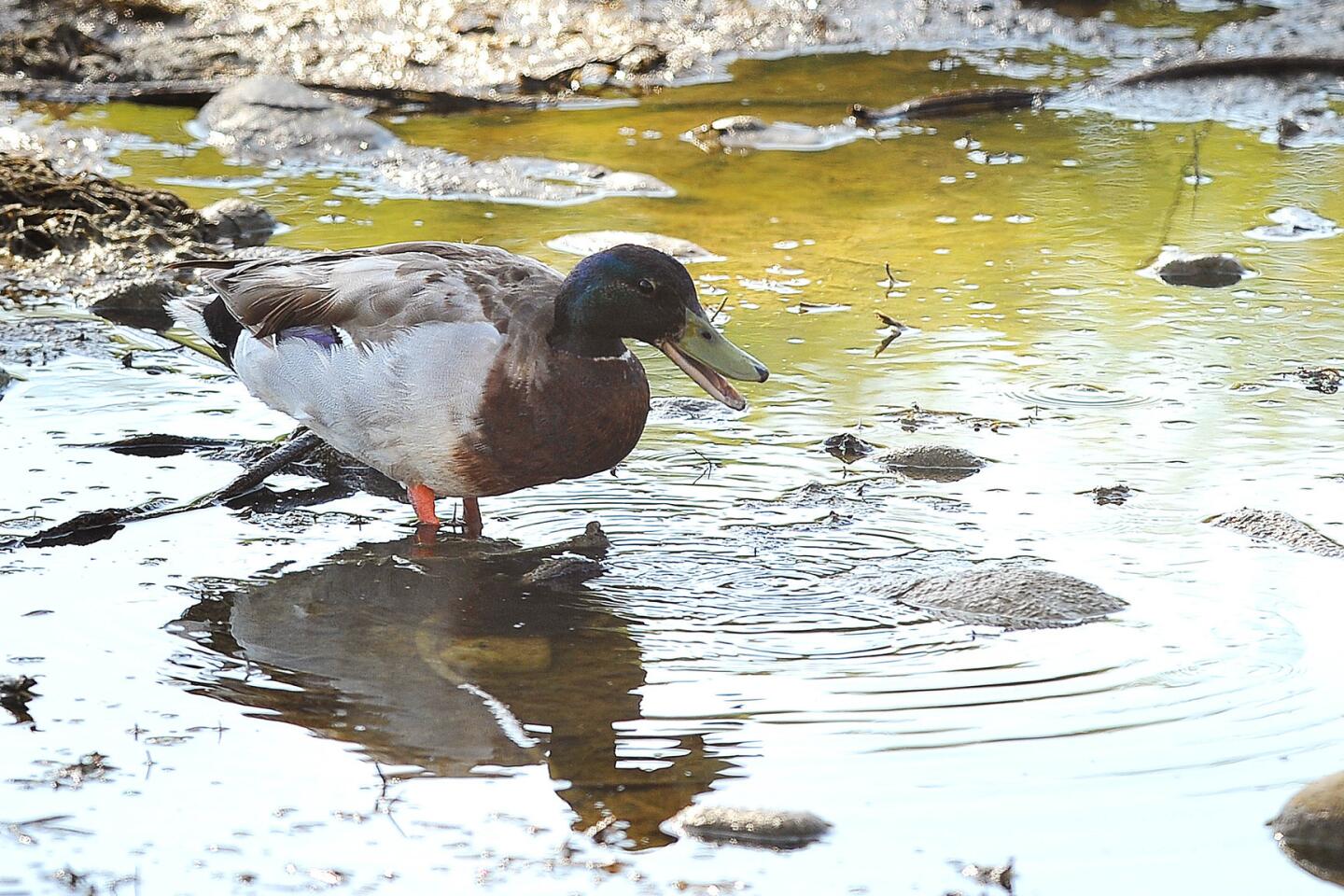
A duck wades in water at Refugio State Beach during an oil spill cleanup on Sunday.
(Christina House / For The Times)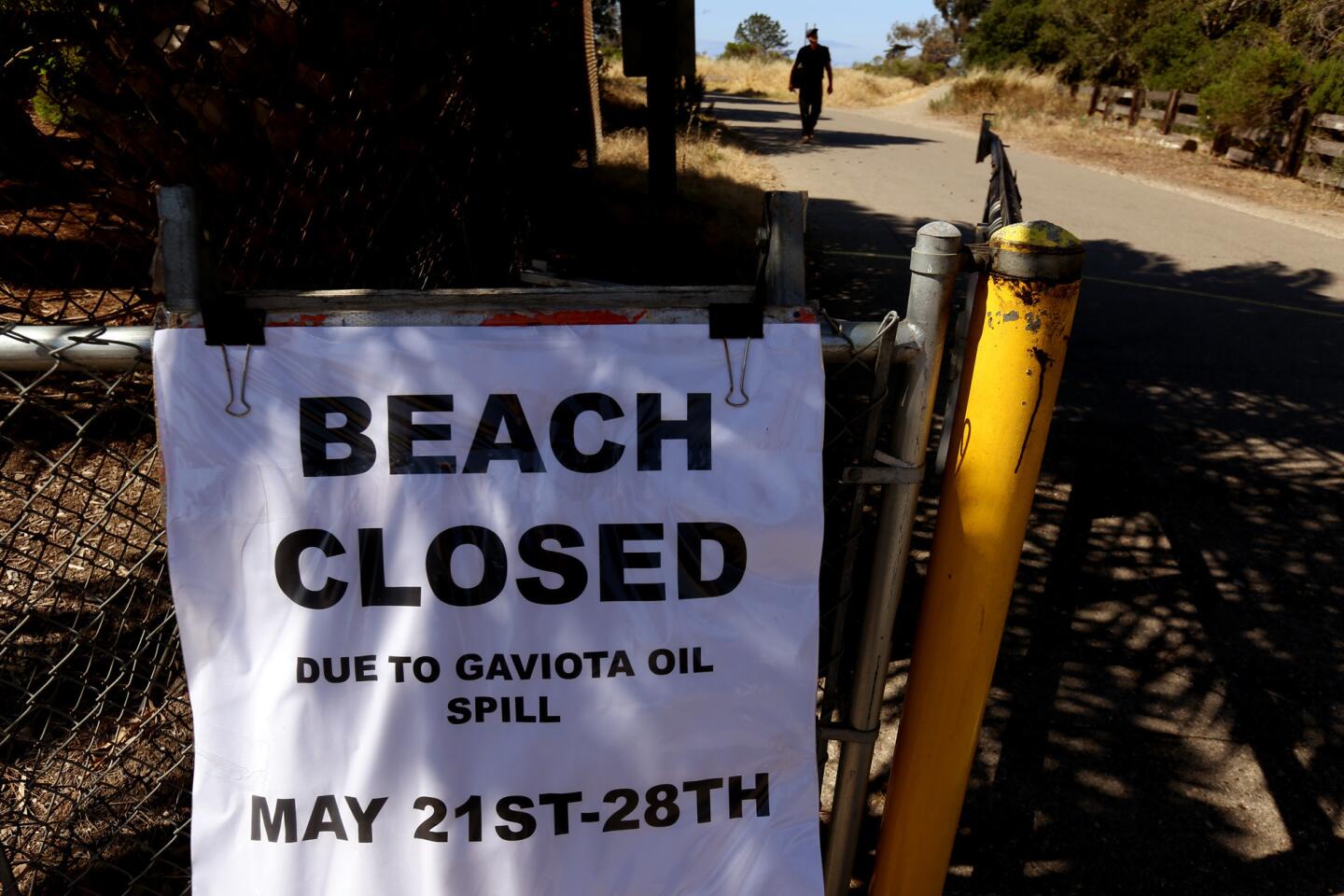
A “Beach Closed” sign is posted at Coal Oil Point in Isla Vista. Many state beaches have been closed in the area, but some people still made their way to the shore.
(Genaro Molina / Los Angeles Times)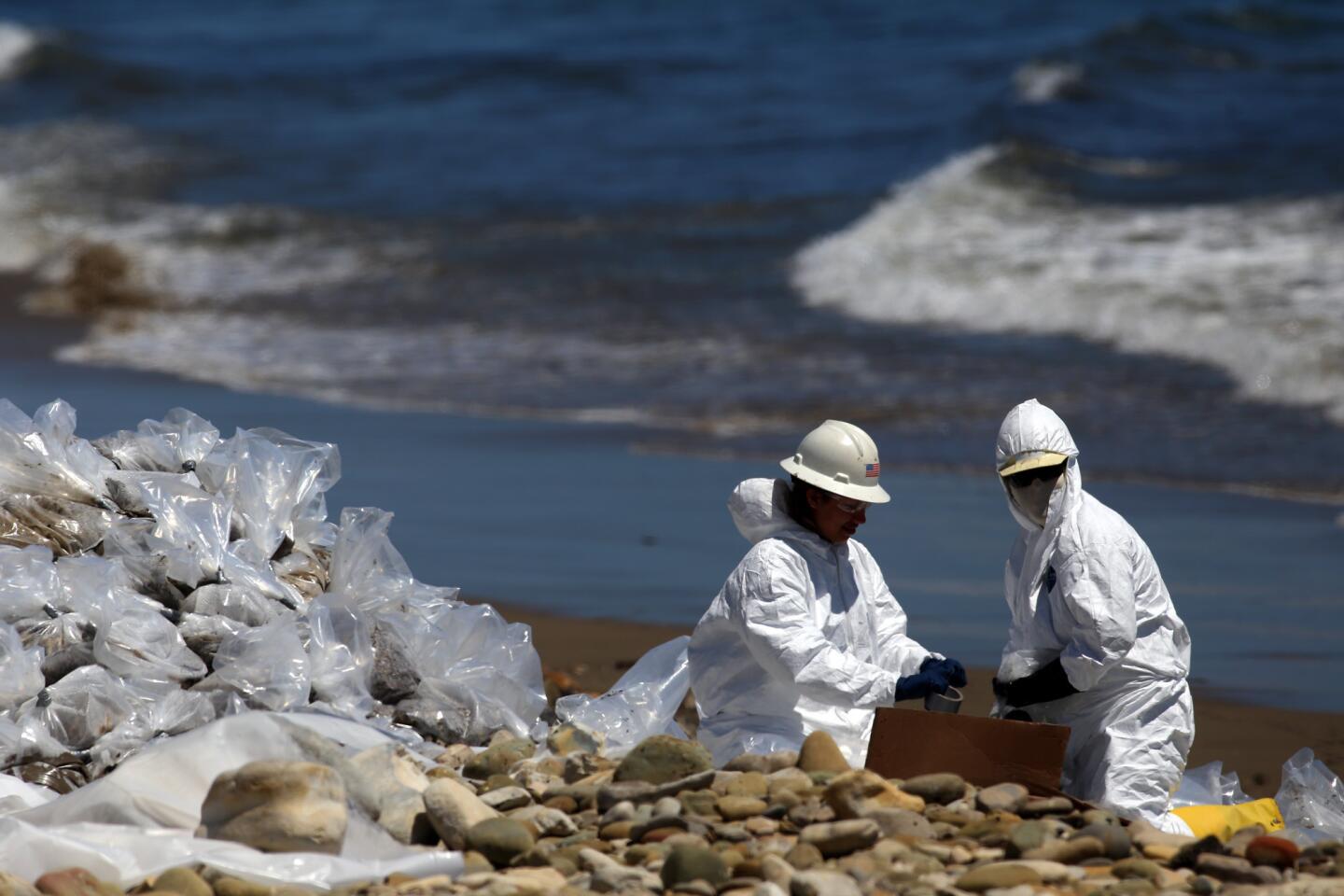
Suited cleanup workers bag oiled sand and rocks on the shoreline at Refugio State Beach near Santa Barbara.
(Genaro Molina / Los Angeles Times)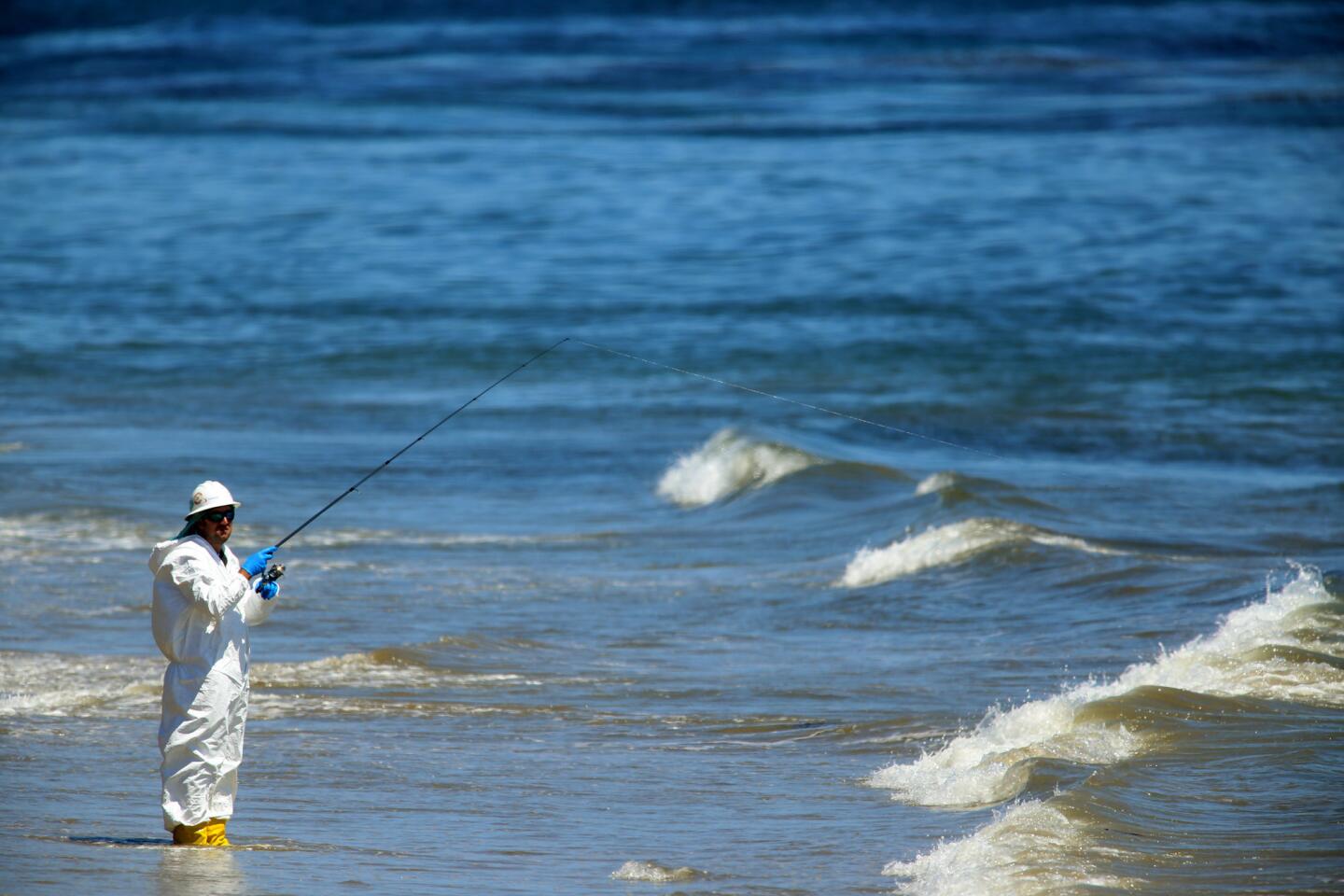
An official with the National Oceanic Atmospheric Administration tries to catch fish as part of damage assessment to the marine creatures in the area of the oil spill.
(Genaro Molina / Los Angeles Times)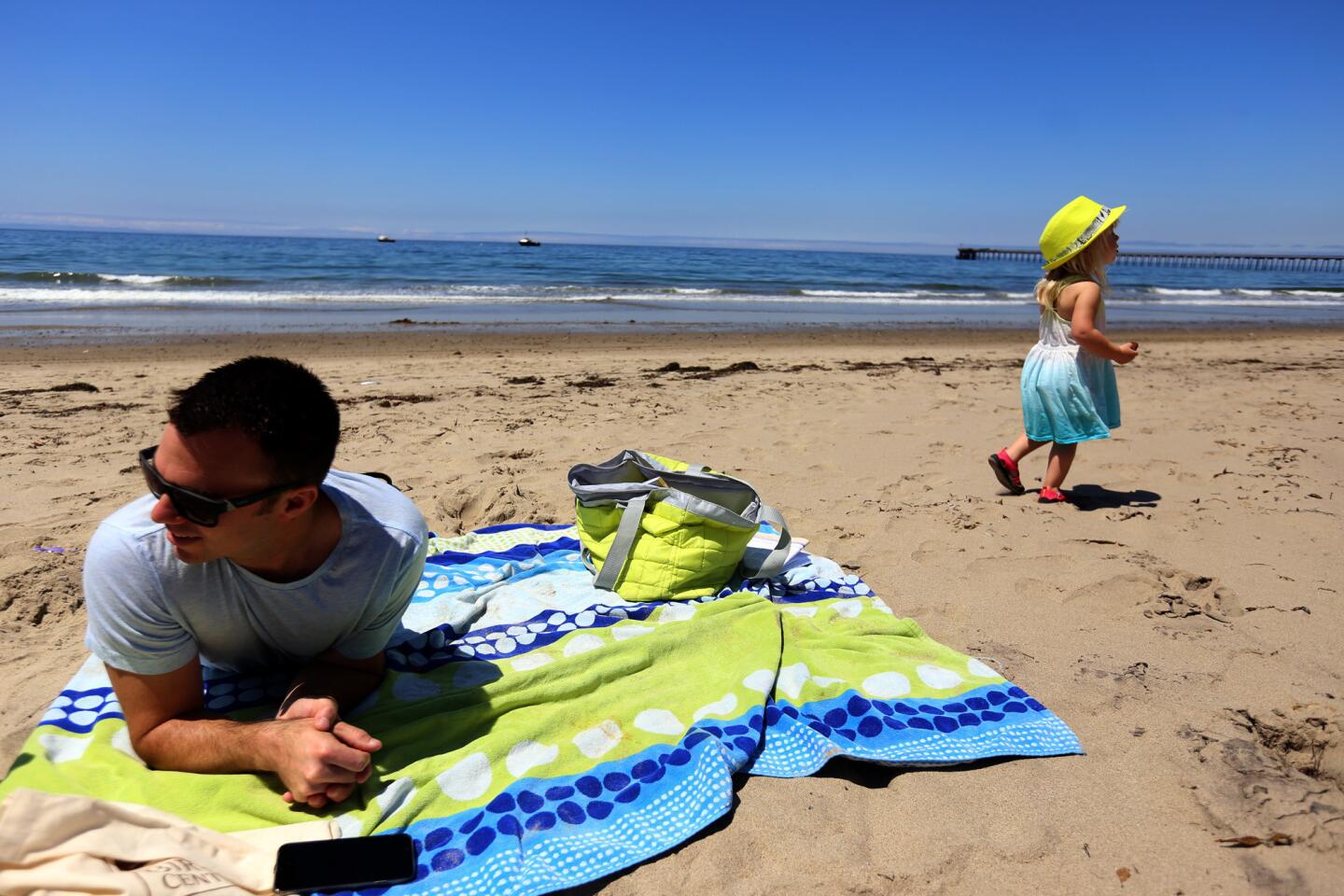
James Daly spends time with his daughter Camryn, 2, at Haskell Beach just south of the area of the oil spill. He noted that there’s usually more people on the beach for Memorial Day weekend.
(Genaro Molina / Los Angeles Times)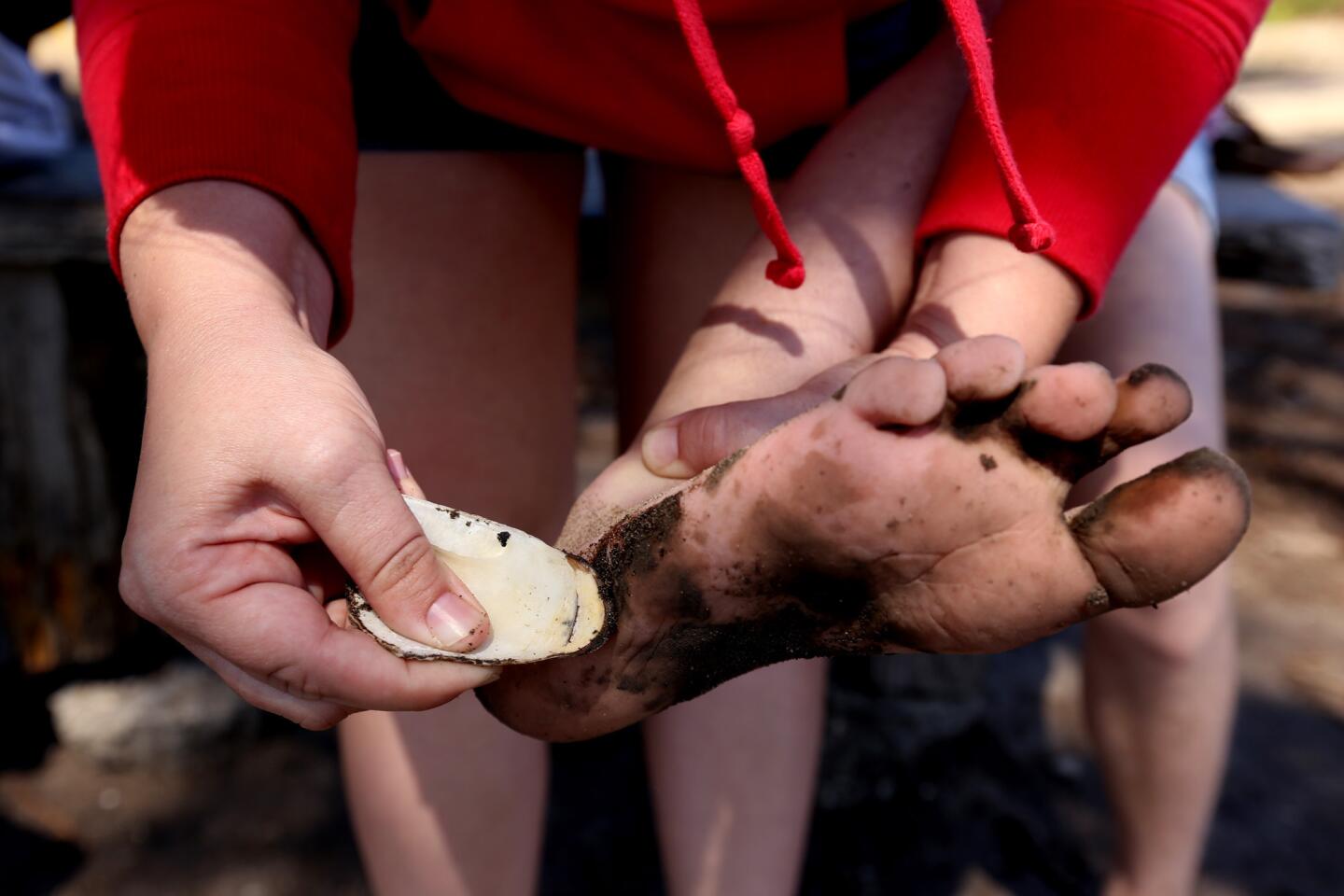
Loree Haralson, from Riverside, uses a shell to clean tar off her daughter Tristan’s foot after a walk on the beach at Coal Oil Point in Isla Vista. Signs had been posted that the beach was closed because of the oil spill.
(Genaro Molina / Los Angeles Times)
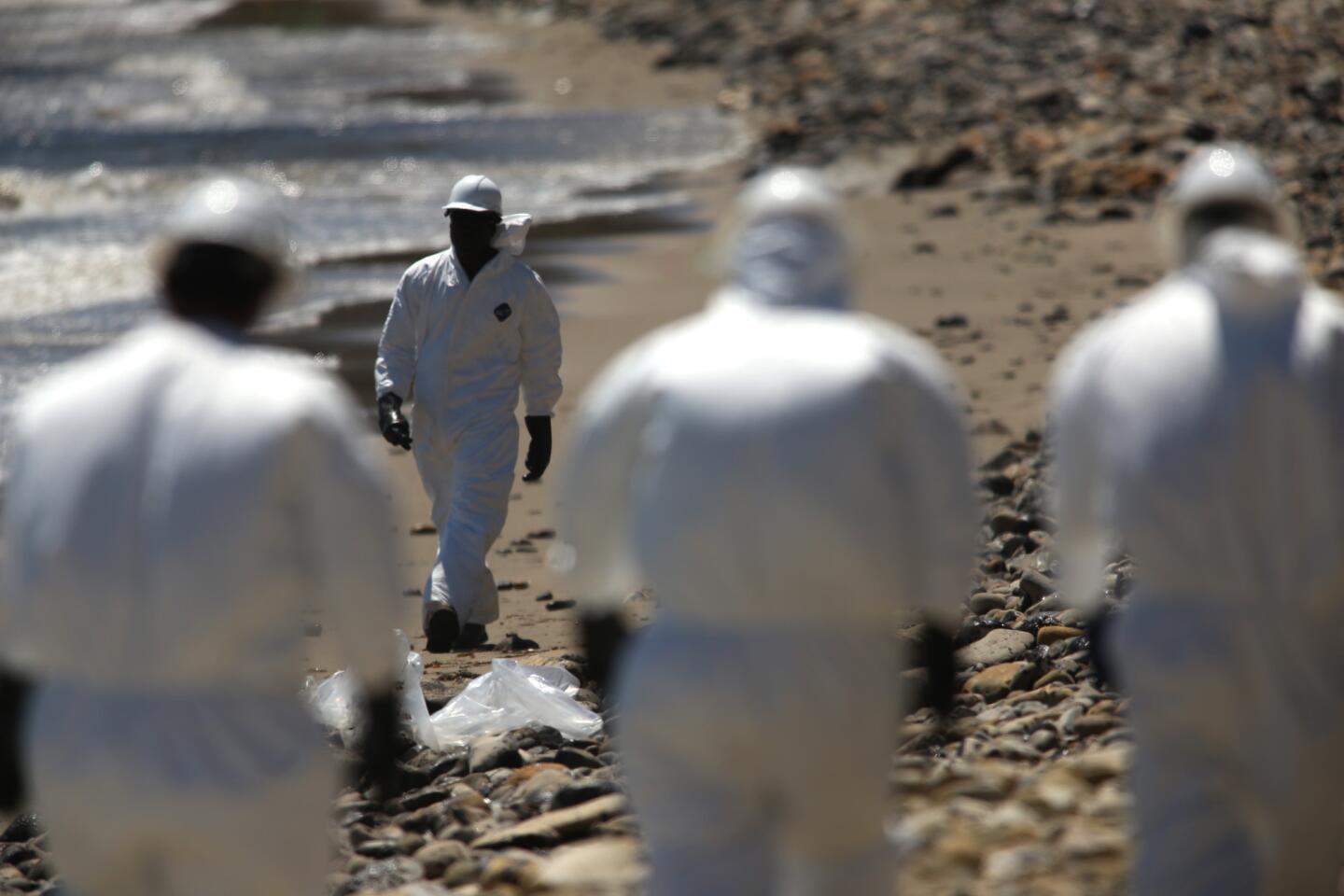
Suited workers continue to clean the shoreline at Refugio State Beach near Santa Barbara.
(Genaro Molina / Los Angeles Times)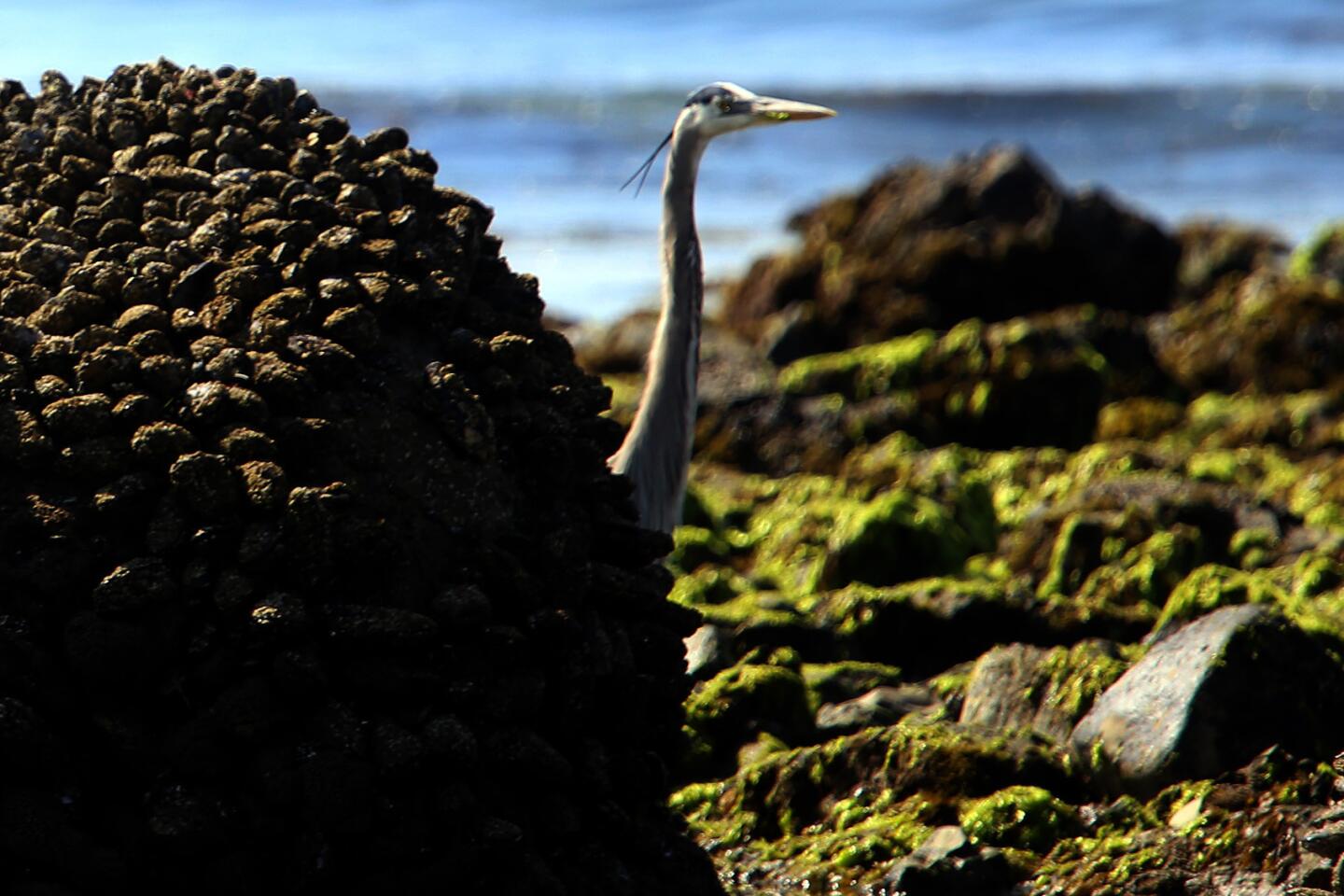
A great blue heron hides behind a rock on the beach at Coal Oil Point in Isla Vista. The beach was closed because of the oil spill.
(Genaro Molina / Los Angeles Times)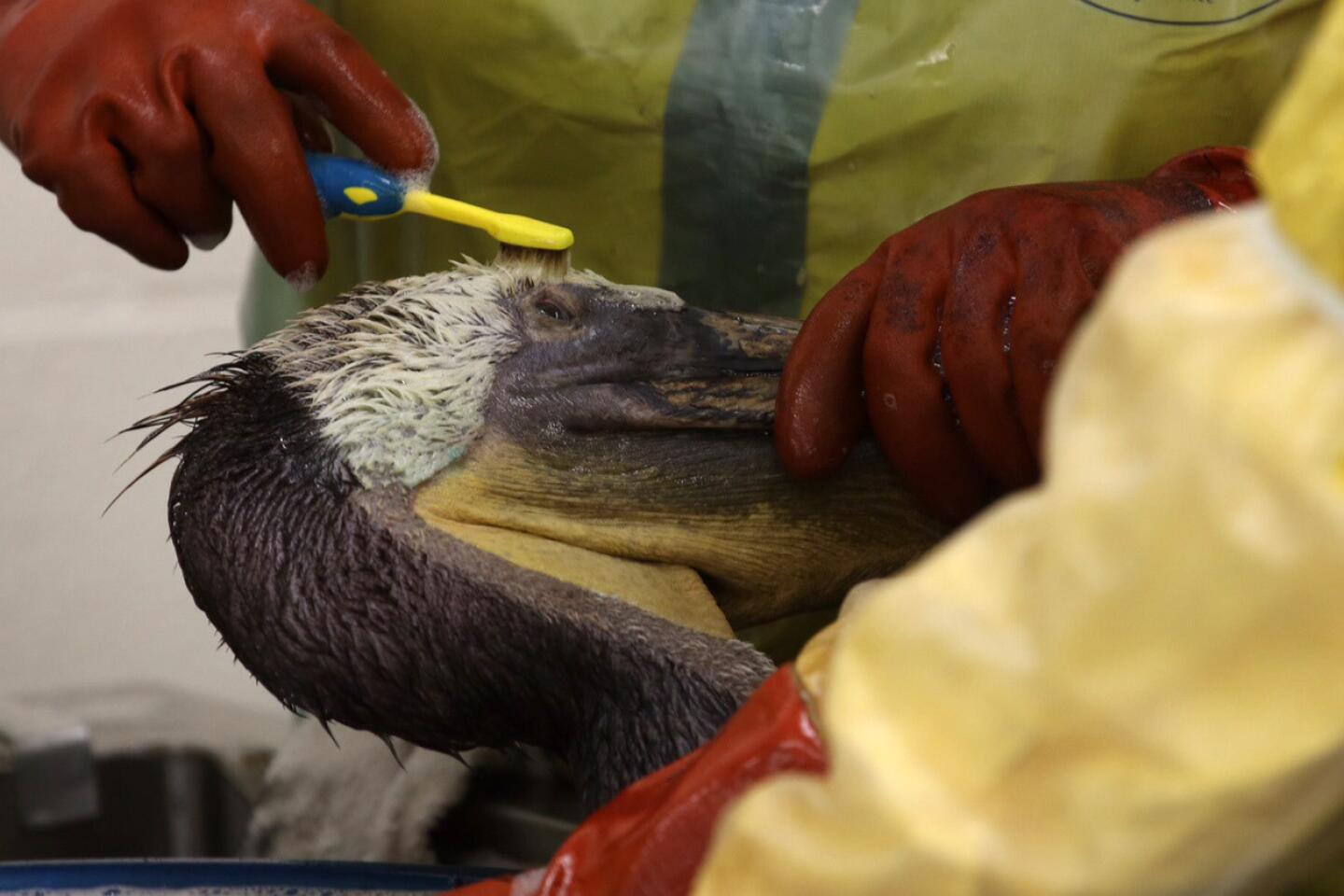
Workers at the Los Angeles Oiled Bird Care and Education Center work to clean an oil-covered pelican rescued from the spill at Refugio State Beach.
(Irfan Khan / Los Angeles Times)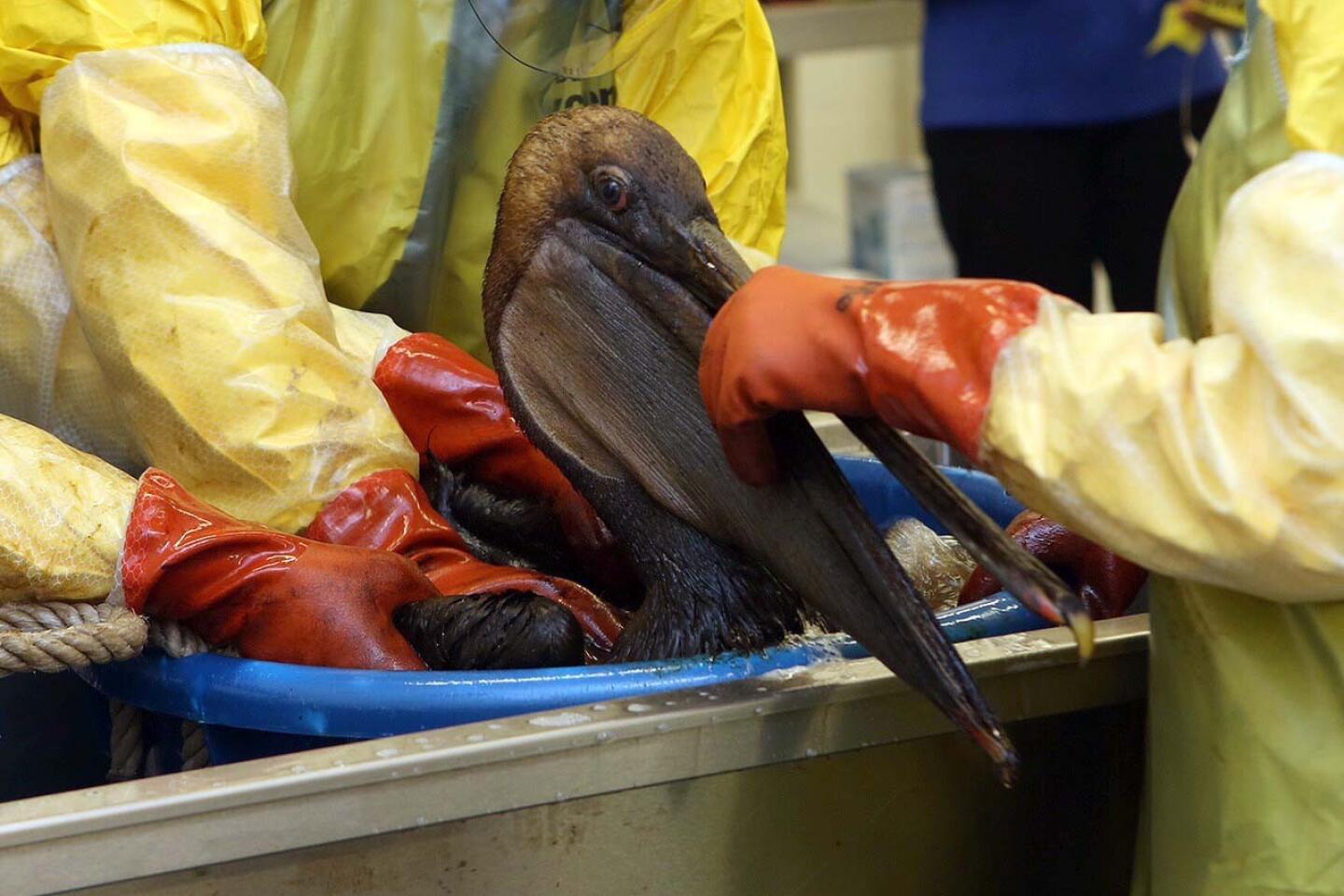
Workers at the Los Angeles Oiled Bird Care and Education Center work to clean an oil-covered pelican rescued from the spill at Refugio State Beach.
(Irfan Khan / Los Angeles Times)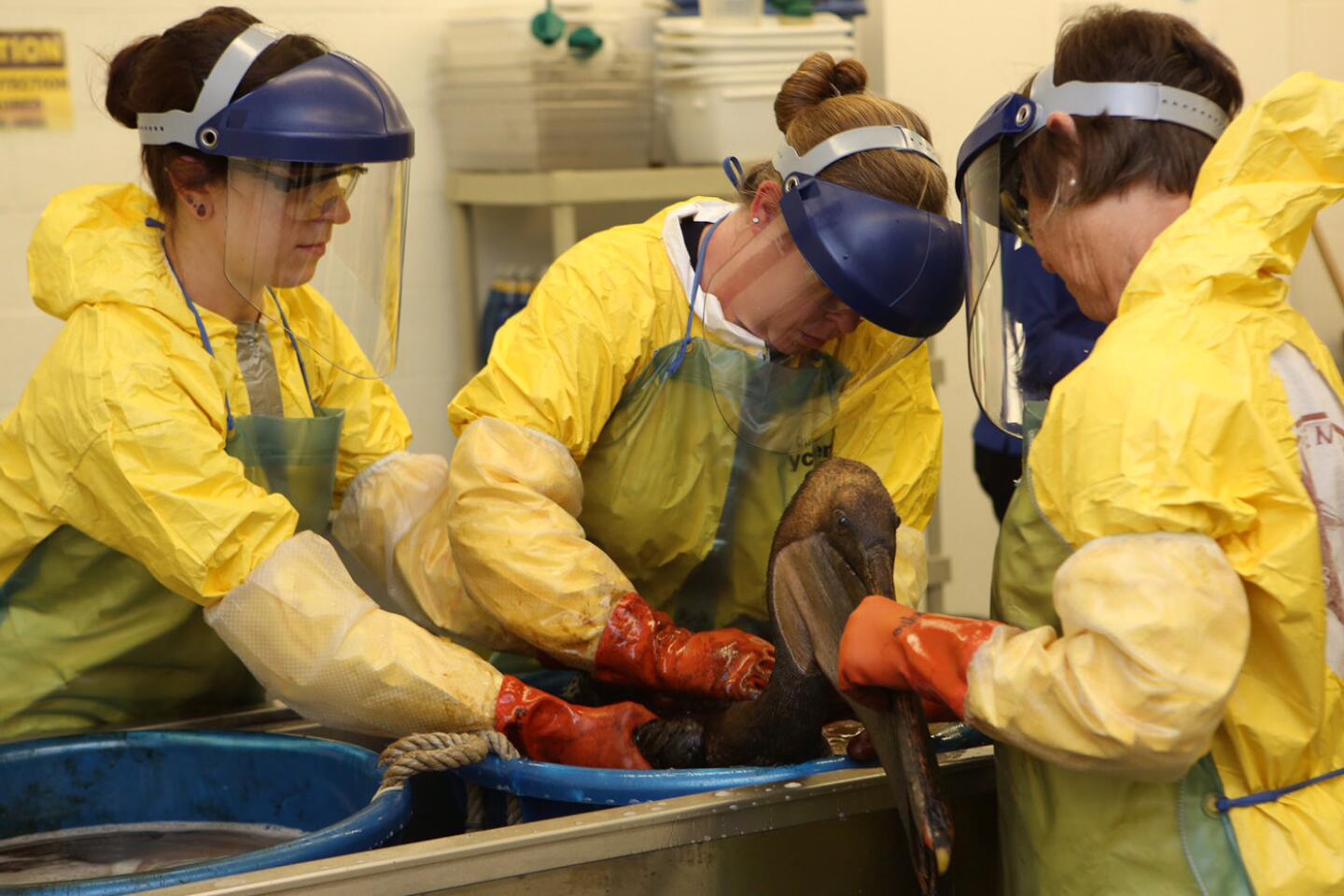
Workers at the Los Angeles Oiled Bird Care and Education Center work to clean an oil-covered pelican rescued from the spill at Refugio State Beach.
(Irfan Khan / Los Angeles Times)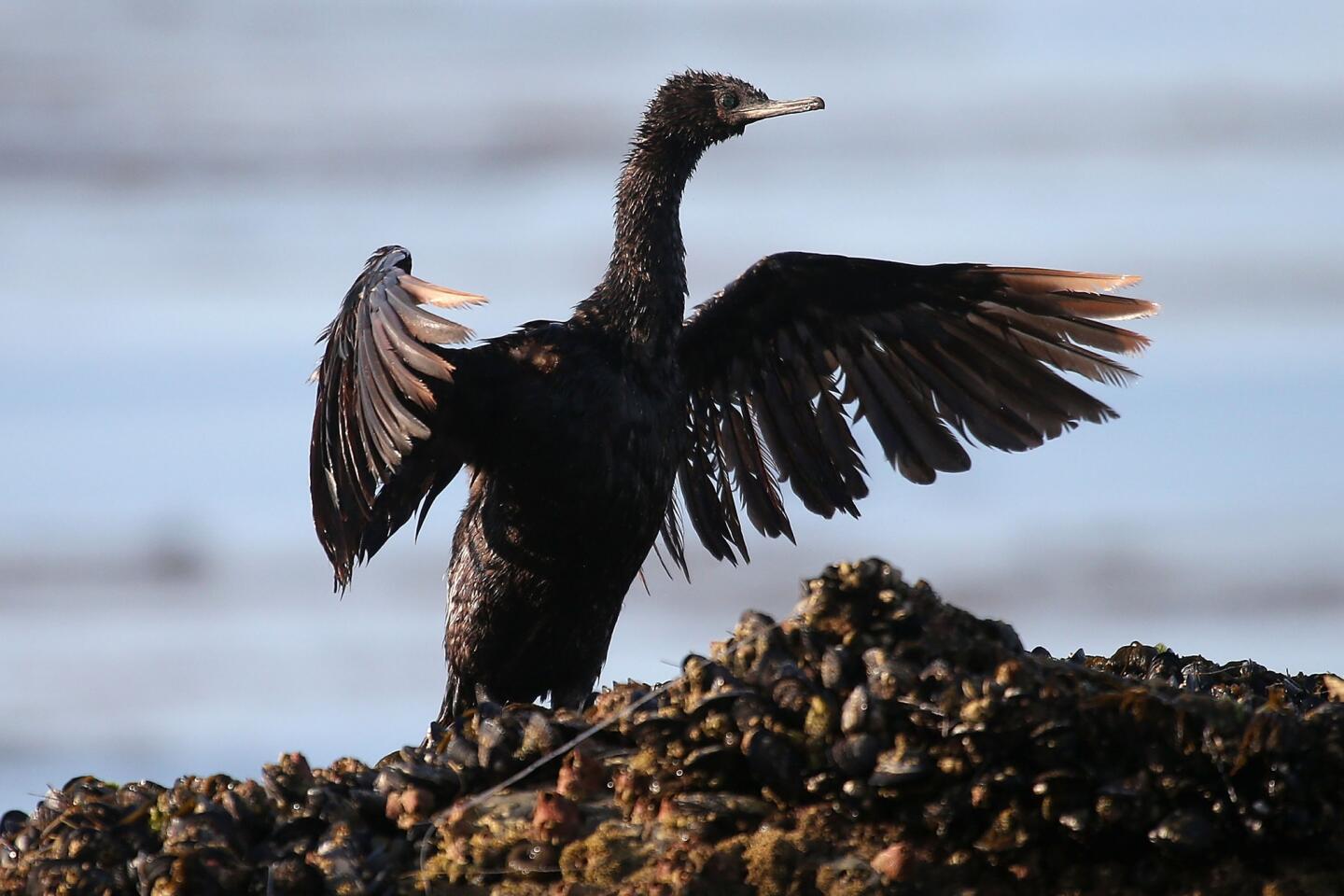
A bird covered in oil spreads its wings as it sits on a rock near Refugio State Beach in Goleta.
(Justin Sullivan / Getty Images)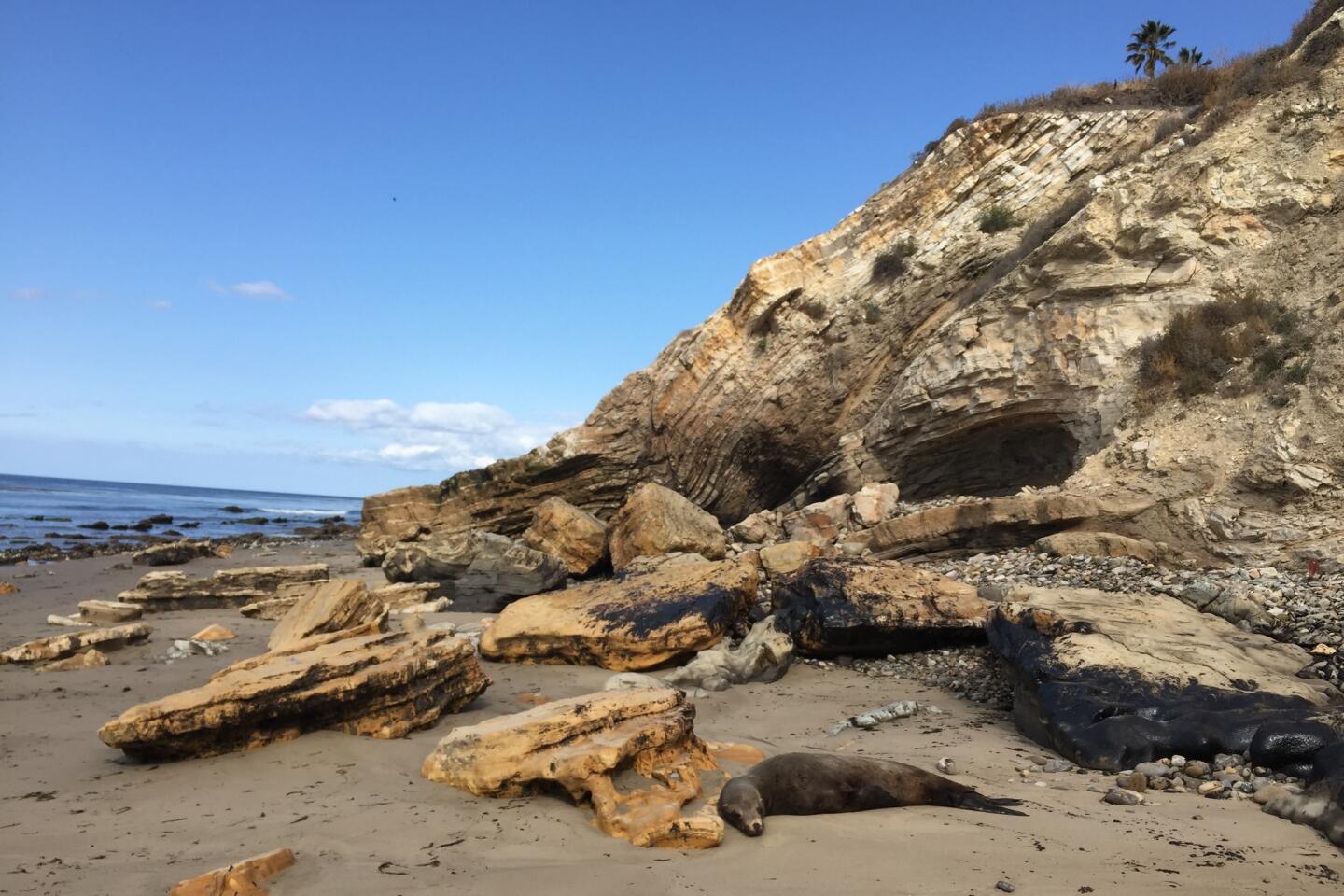
A sea lion covered in oil lies on the beach near Refugio State Beach, about 100 feet from where the oil spill flowed into the ocean off the Santa Barbara County coast.
(Bethany Mollenkof / Los Angeles Times)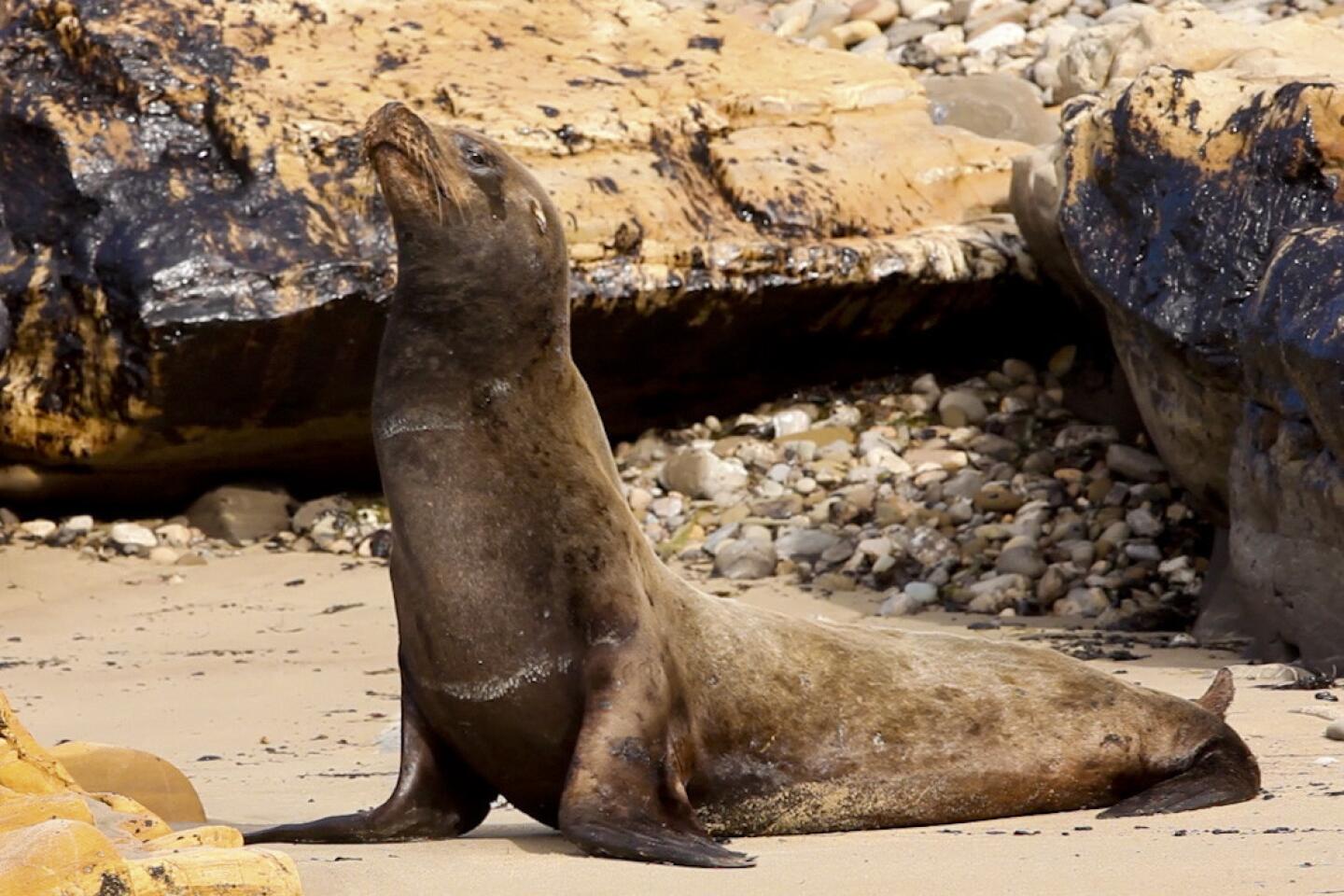
A sea lion covered in oil struggles on the beach just west of Refugio State Beach, about 100 feet from where the oil spill flowed into the ocean.
(Bethany Mollenkof / Los Angeles Times)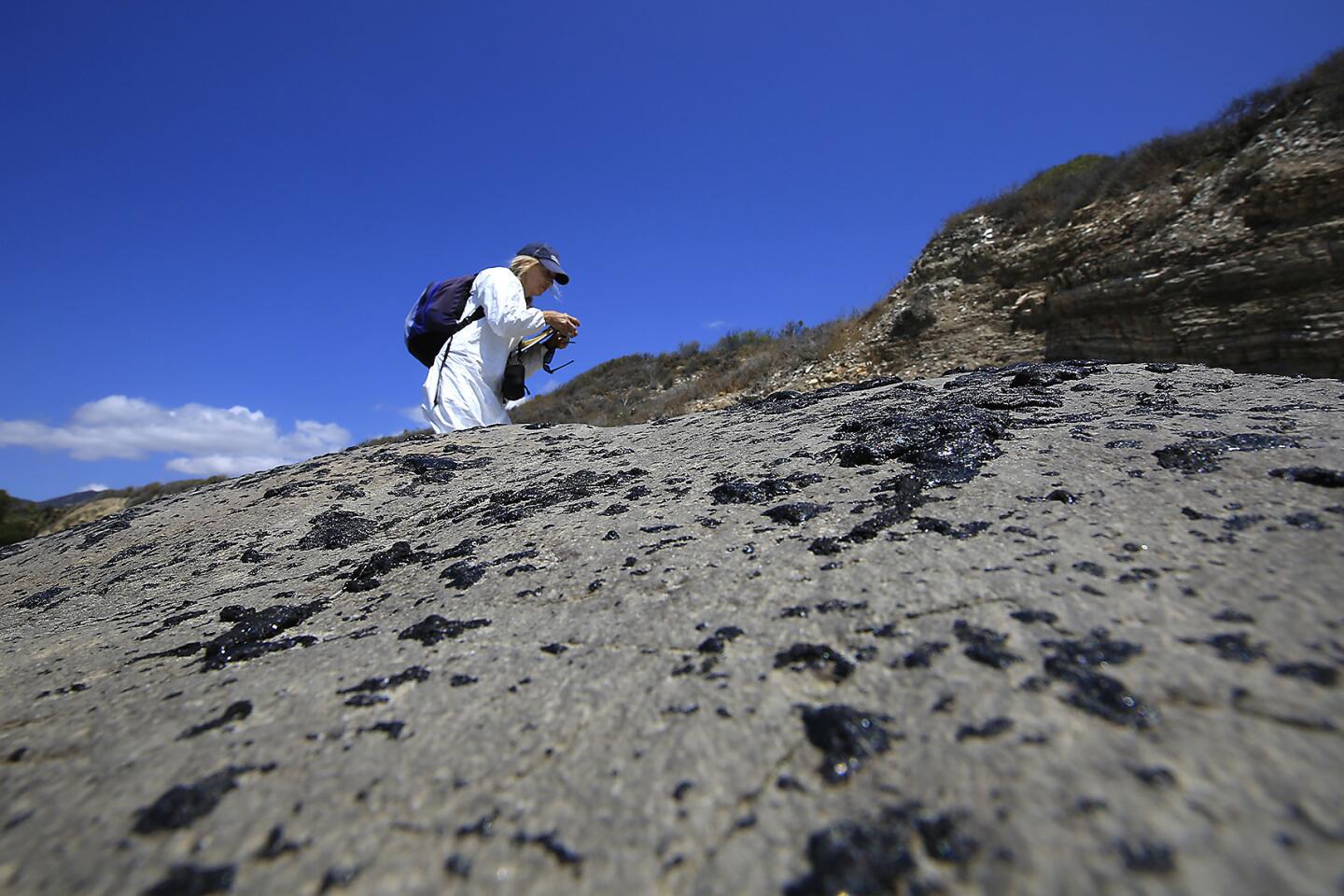
Jenny Dugan, UCSB Marine Science Institute marine ecologist, takes a photograph of oil-fouled kelp as she and other scientists do natural resource damage assessments in the aftermath of the oil spill on the Gaviota coast in Santa Barbara County.
(Brian van der Brug / Los Angeles Times)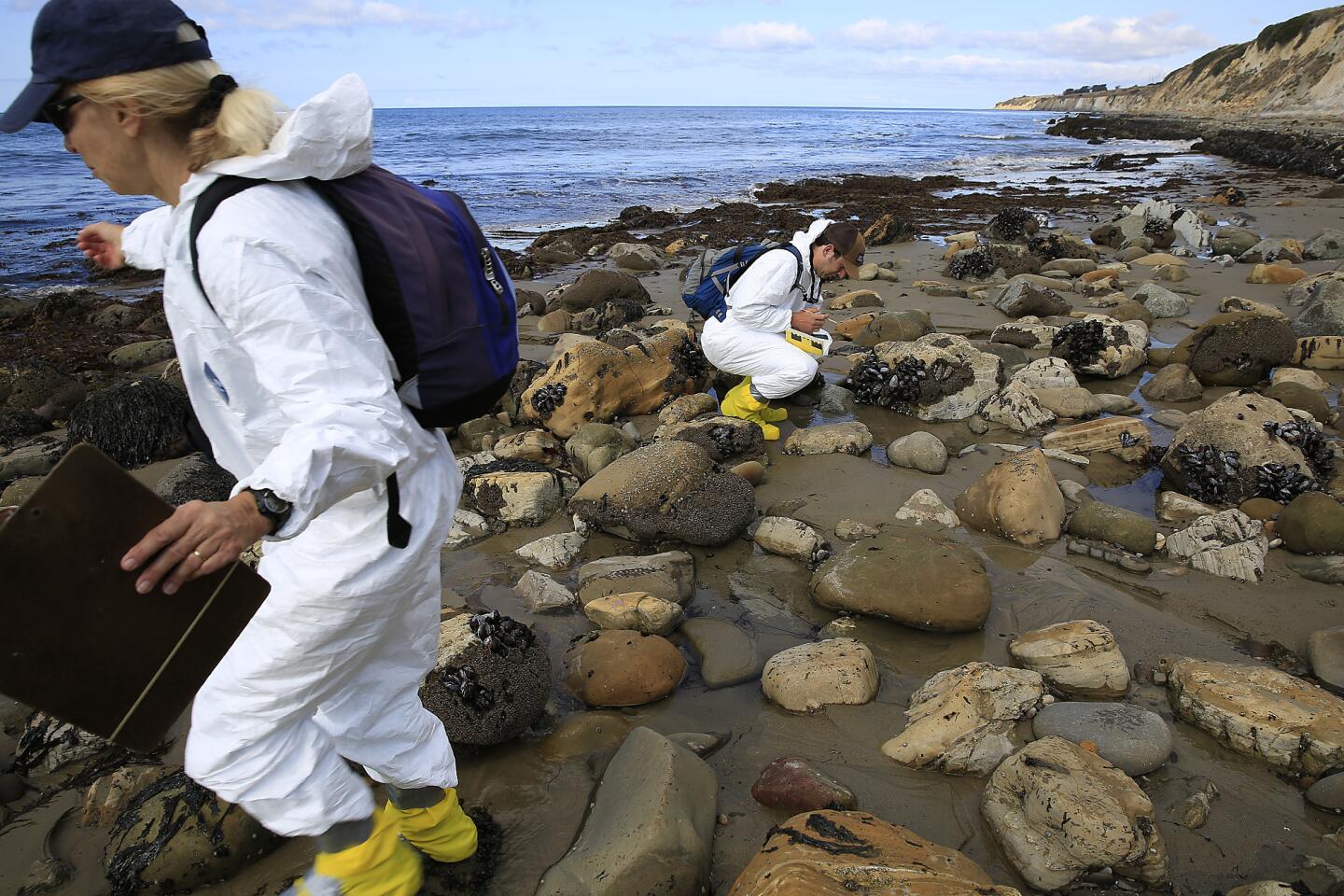
Jenny Dugan, UCSB Marine Science Institute marine ecologist, left, and Nicholas Schooler, graduate student Nicholas Schooler, document a dead octopus as she and other scientists do natural resource damage assessments in the aftermath of the oil spill on the Gaviota coast.
(Brian van der Brug / Los Angeles Times)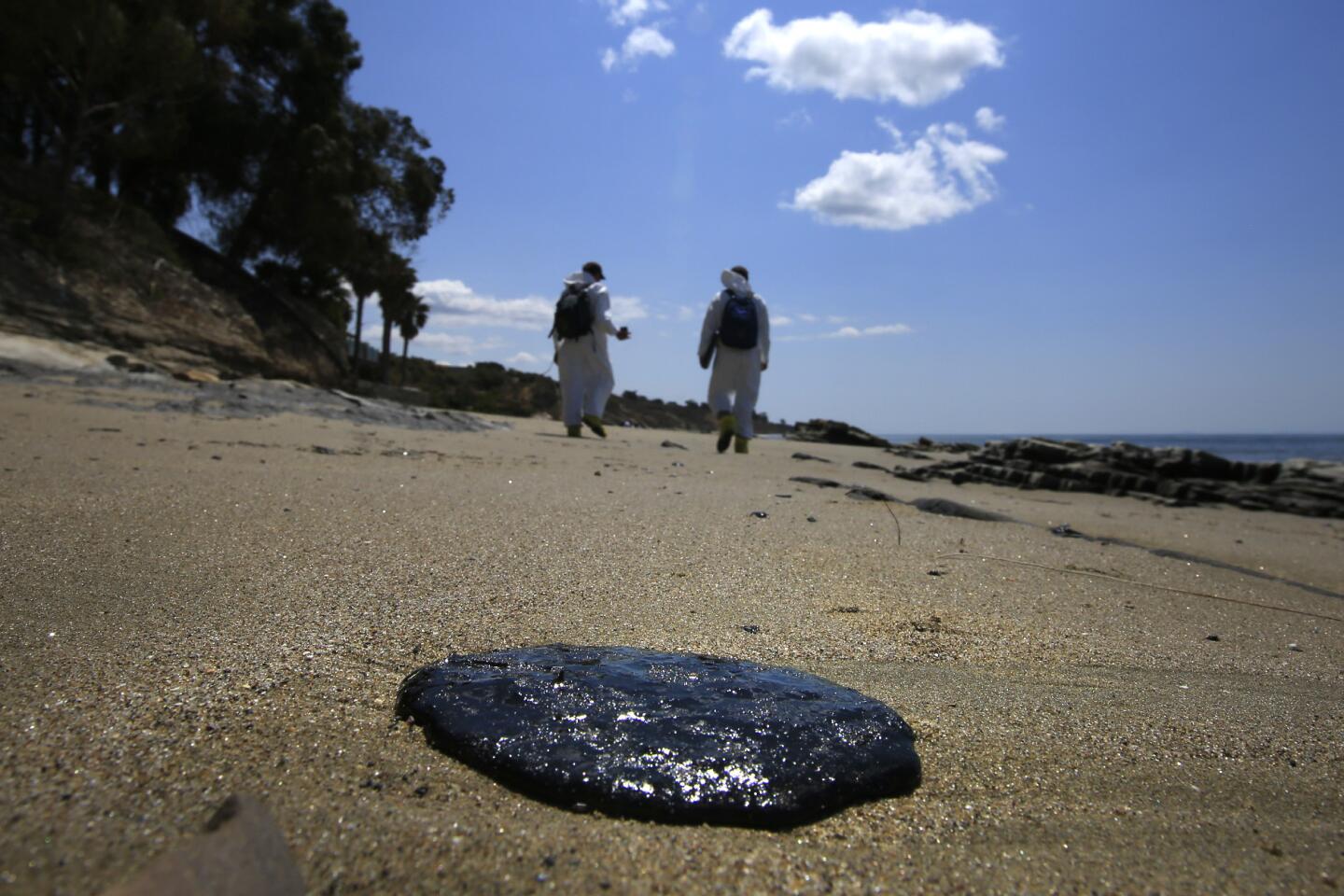
A large glob of oil on the beach at Arroyo Quemado in the aftermath of the oil spill on the Gaviota coast.
(Brian van der Brug / Los Angeles Times)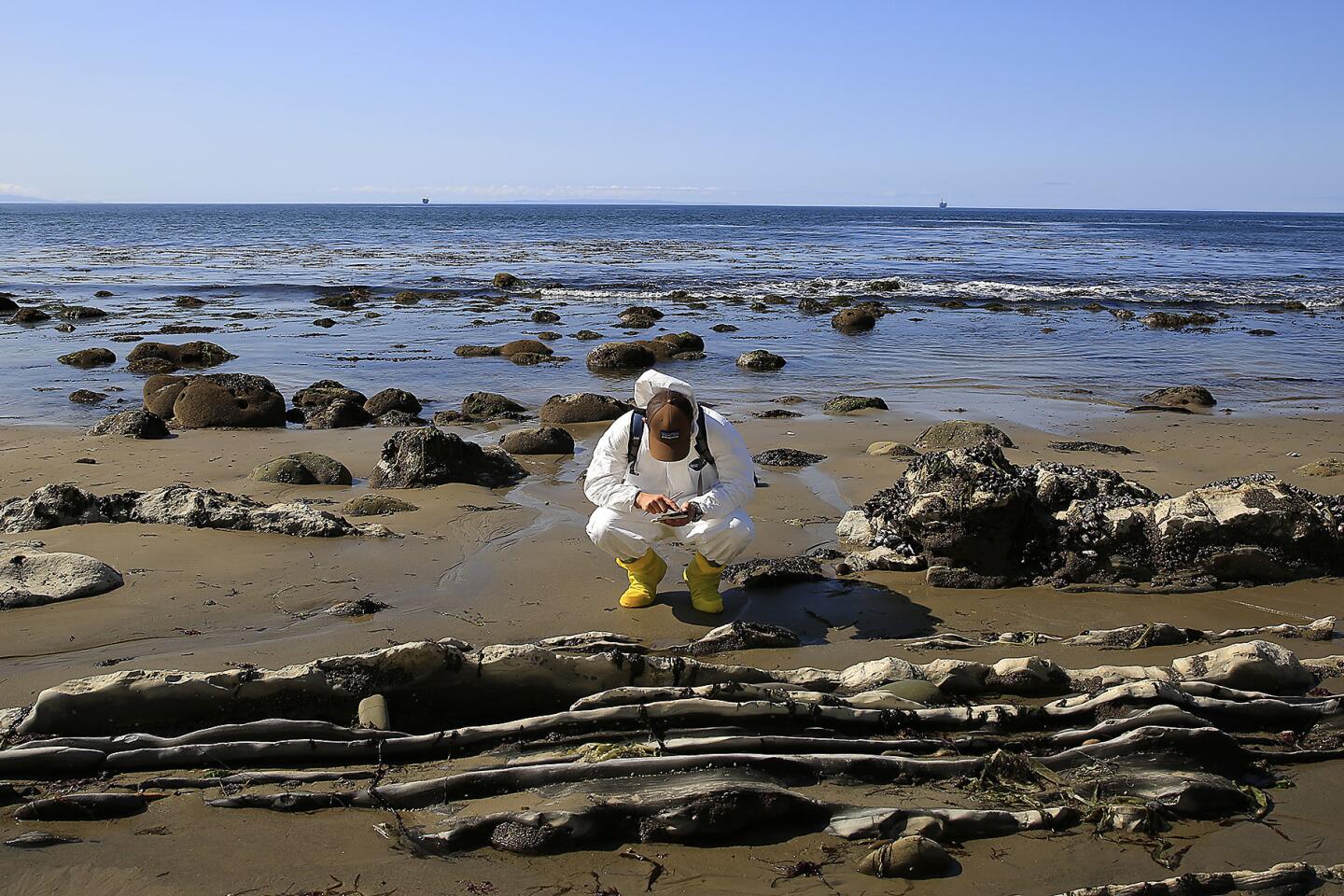
Nicholas Schooler, UCSB Marine Science Institute graduate student conducts natural resource damage assessments in the aftermath of the oil spill on the Gaviota coast.
(Brian van der Brug / Los Angeles Times)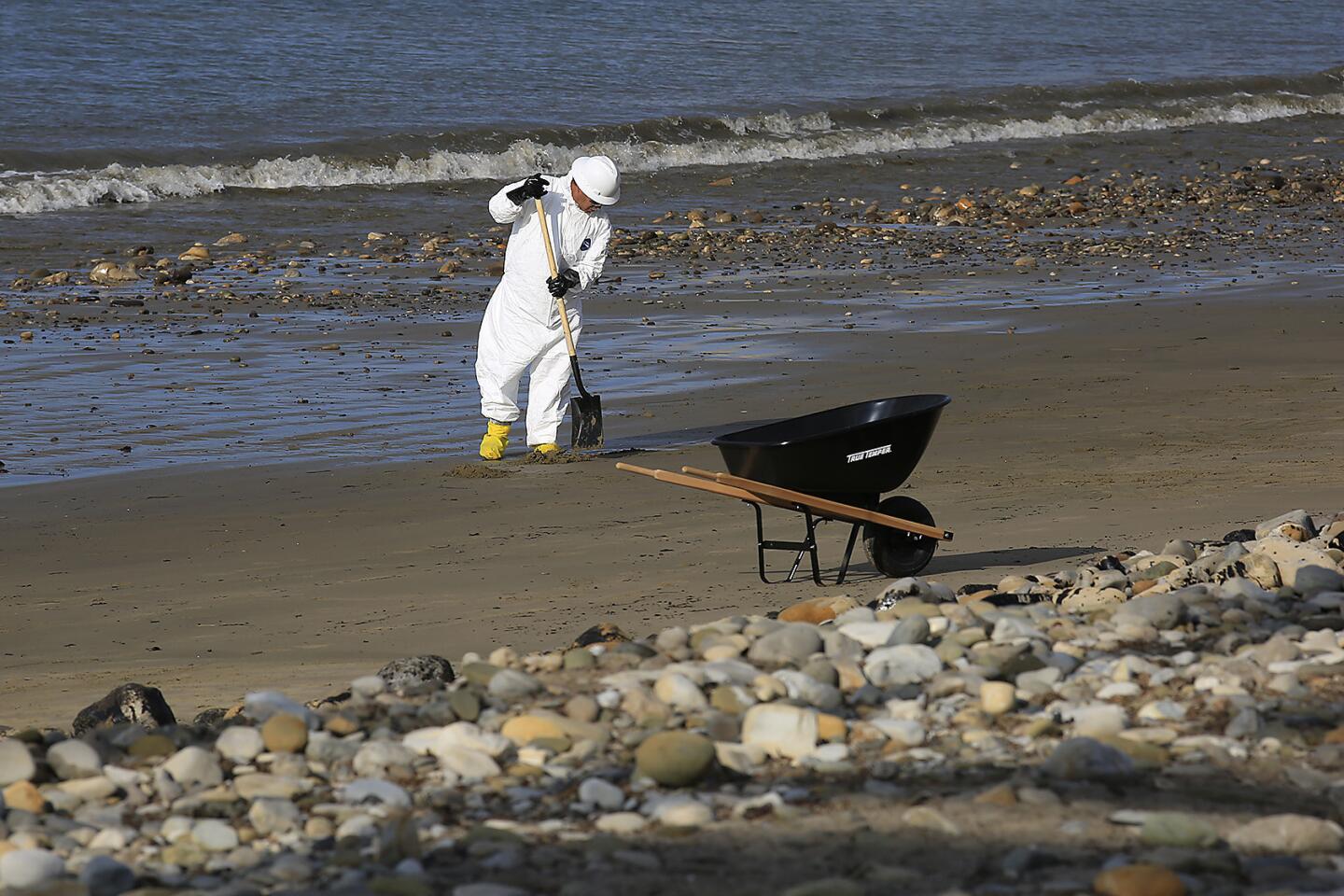
Crew members from Patriot Environmental Services continue the removal of oil-fouled sand at Refugio State Beach in the aftermath of the oil spill on the Gaviota coast.
(Brian van der Brug / Los Angeles Times)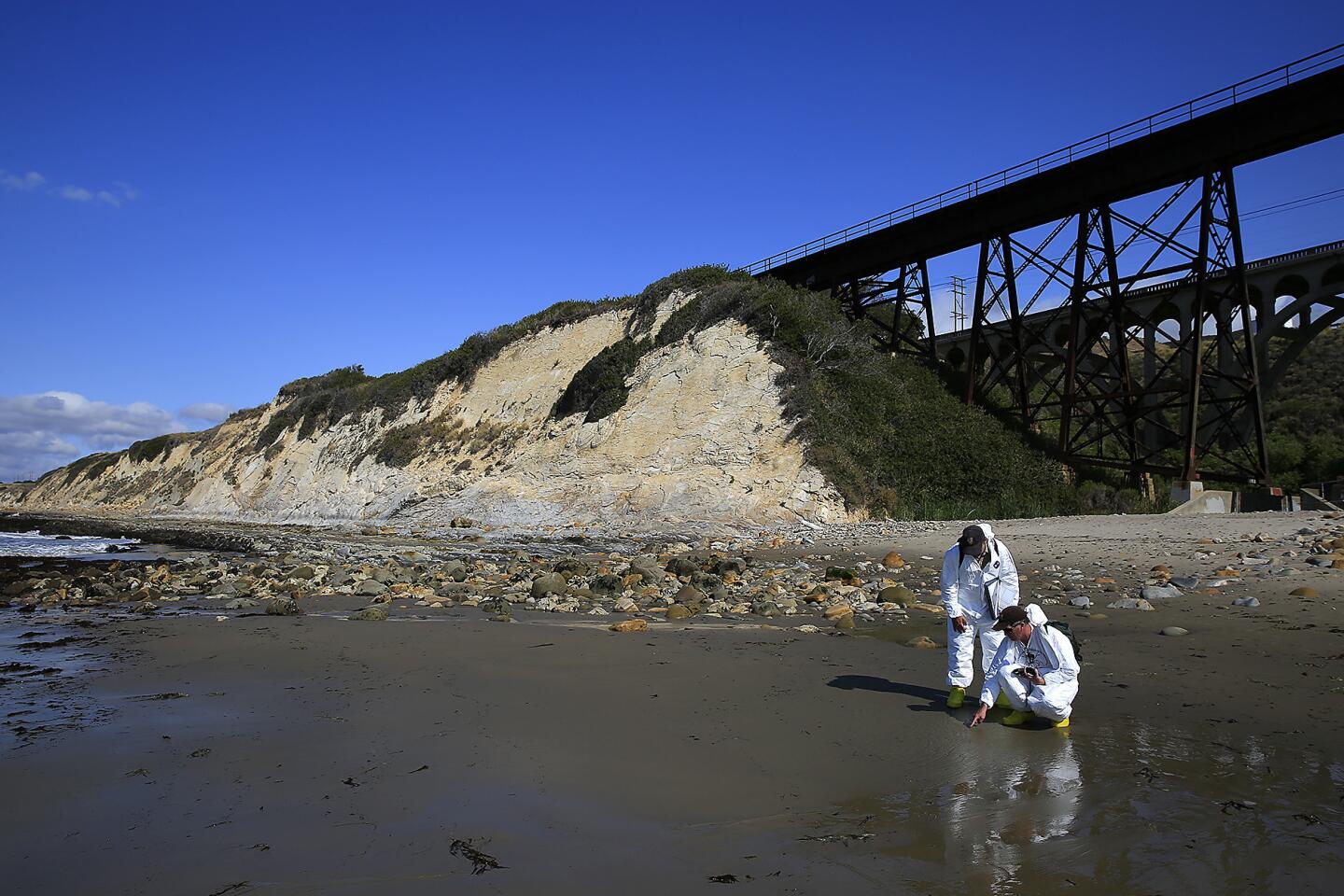
Scientists from the California Department of Fish and Wildlife and the UCSB Marine Science Institute conduct natural resource damage assessments at the Arroyo Hondo in the aftermath of the oil spill on the Gaviota coast.
(Brian van der Brug / Los Angeles Times)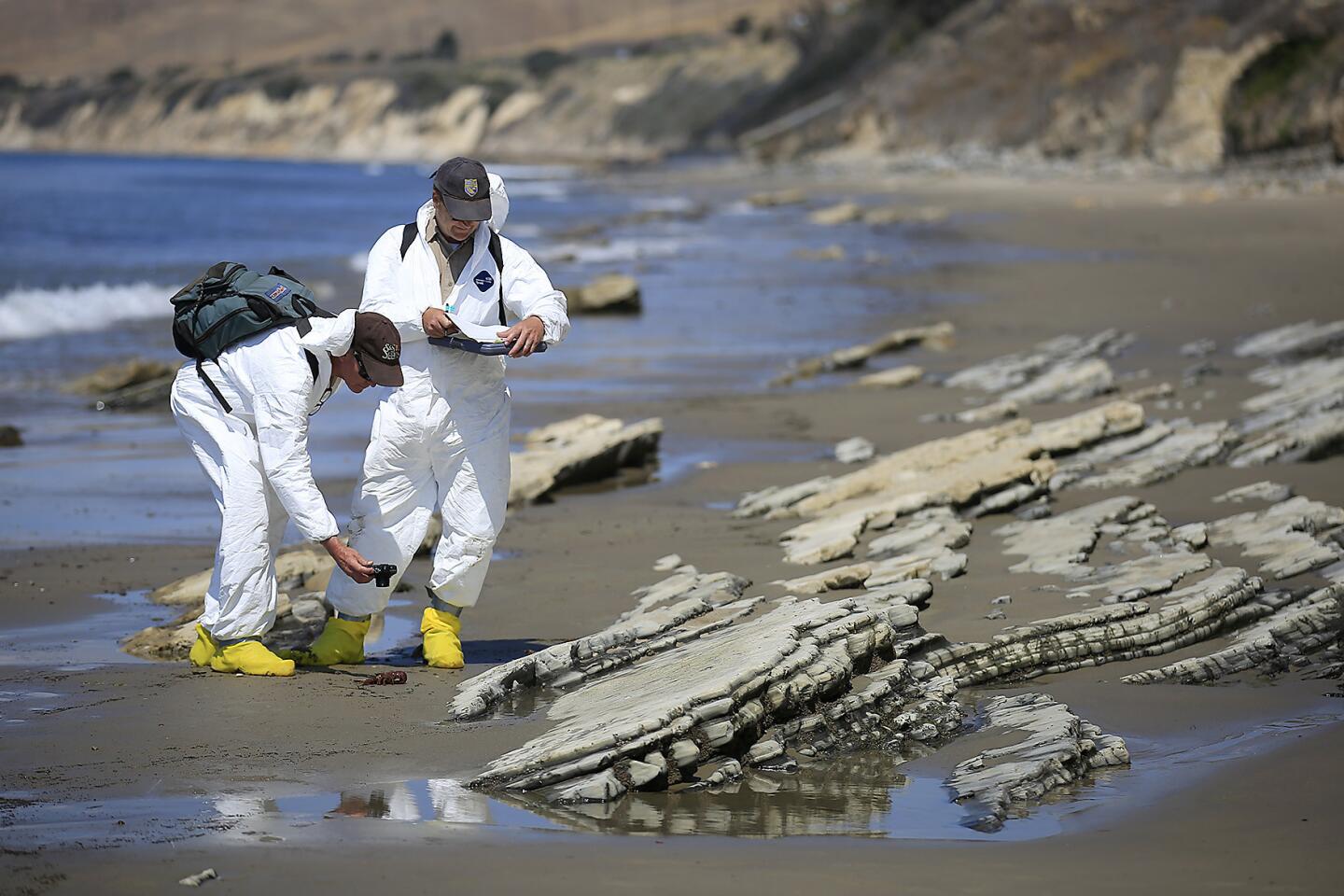
Scientists from the California Department of Fish and Wildlife and the UCSB Marine Science Institute conduct natural resource damage assessments in the aftermath of the oil spill on the Gaviota coast.
(Brian van der Brug / Los Angeles Times)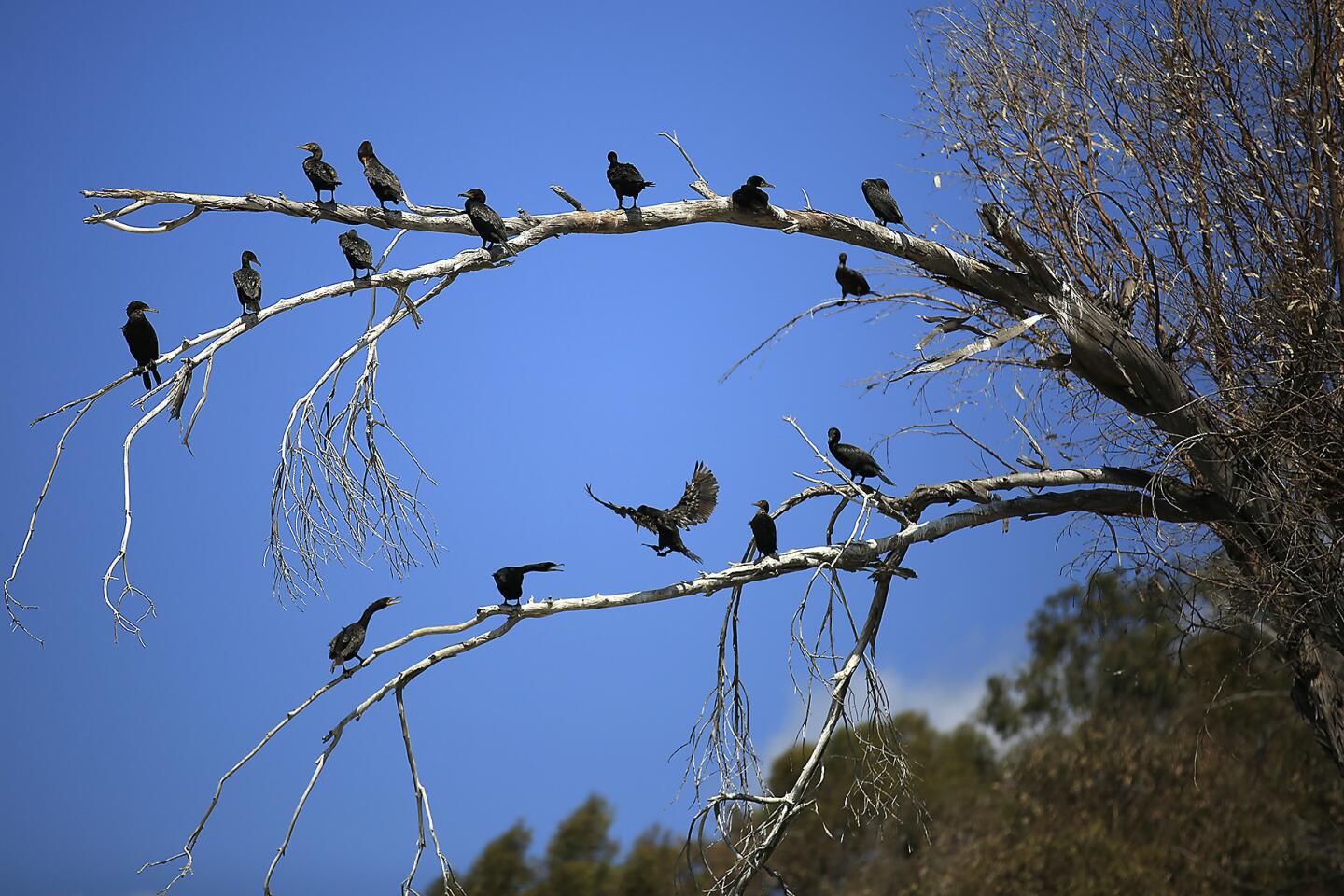
Cormorants roost in a tree on Arroyo Quemado Beach on the Gaviota coast. Scientists are keeping an eye on the birds for signs of oil contamination.
(Brian van der Brug / Los Angeles Times)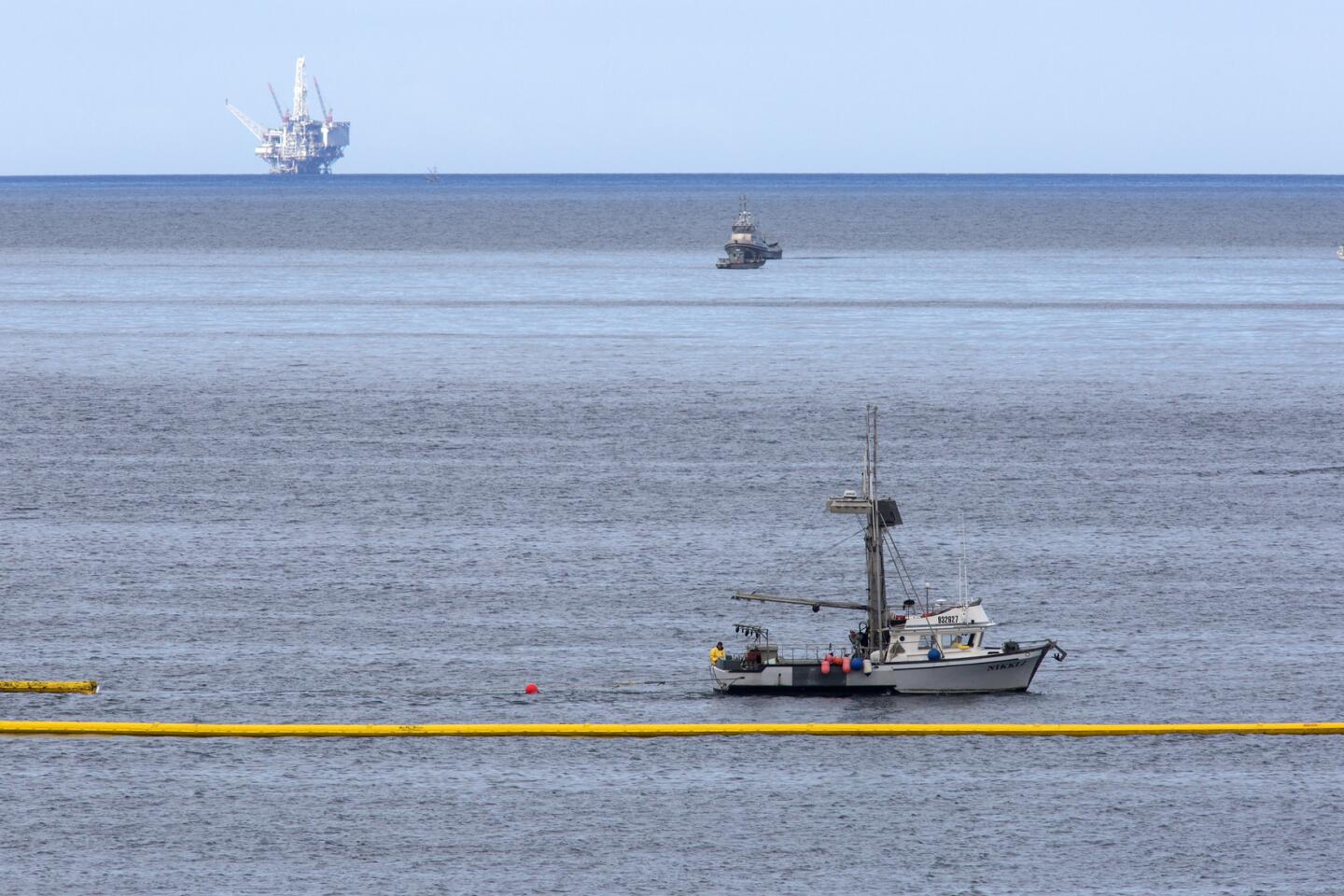
Oil recovery and cleanup vessels ply the waters off El Capitan State Beach near Santa Barbara.
(Brian van der Brug / Los Angeles Times)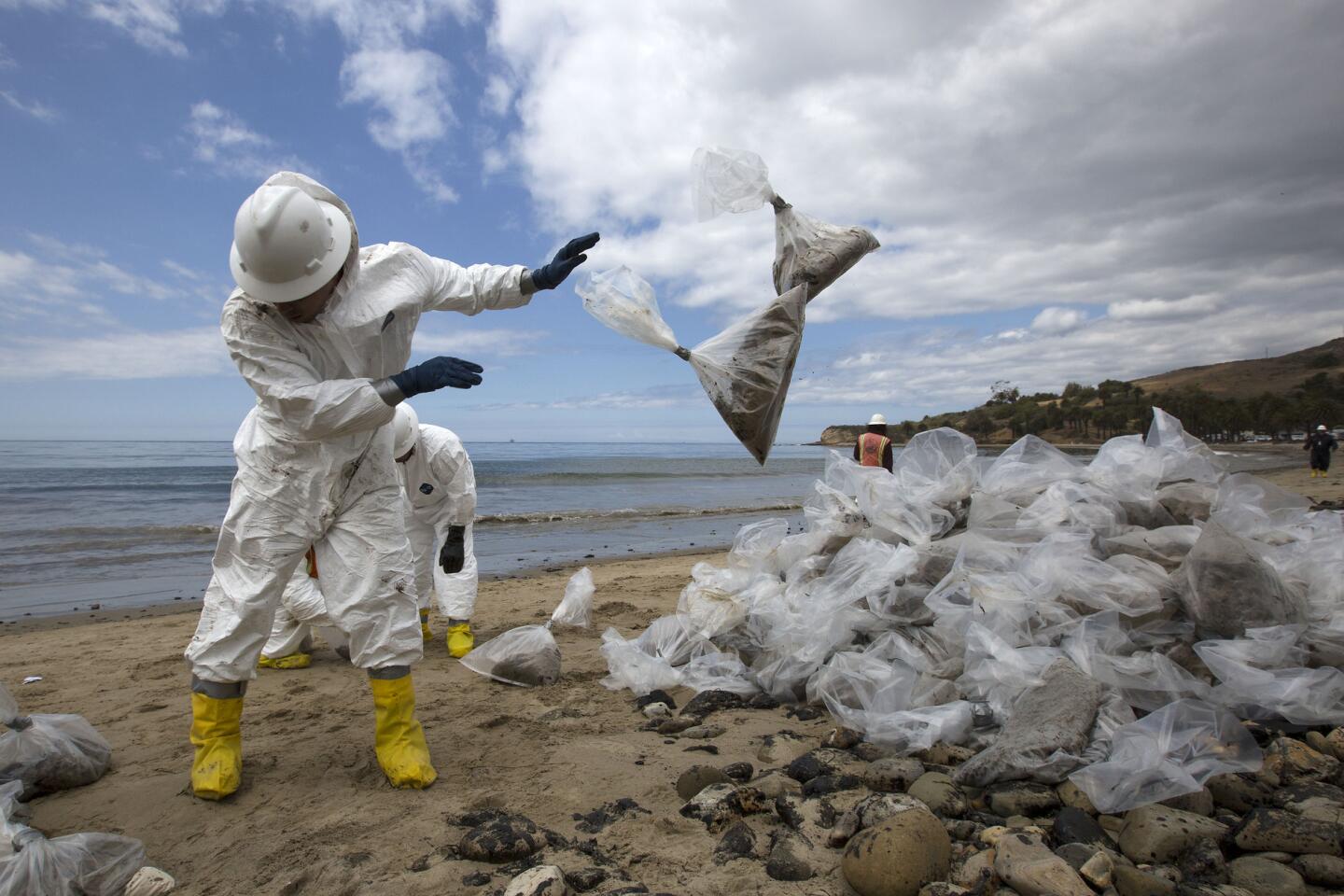
Patriot Environmental Services employees pile bags of oil-contaminated sand on the shoreline at Refugio State Beach near Santa Barbara.
(Brian van der Brug / Los Angeles Times)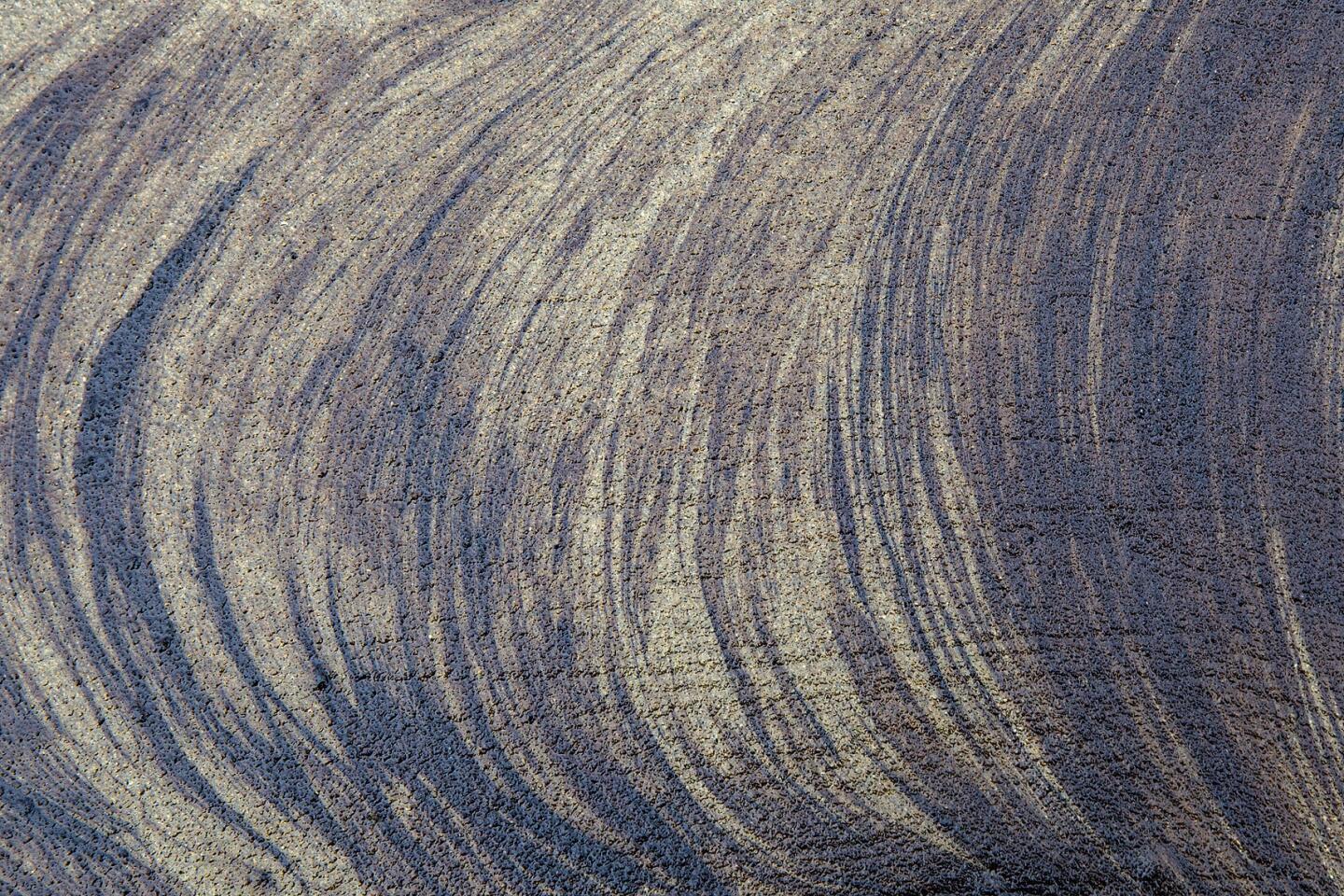
Oil-contaminated sand makes an interesting pattern on the shoreline at Refugio State Beach near Santa Barbara.
(Brian van der Brug / Los Angeles Times)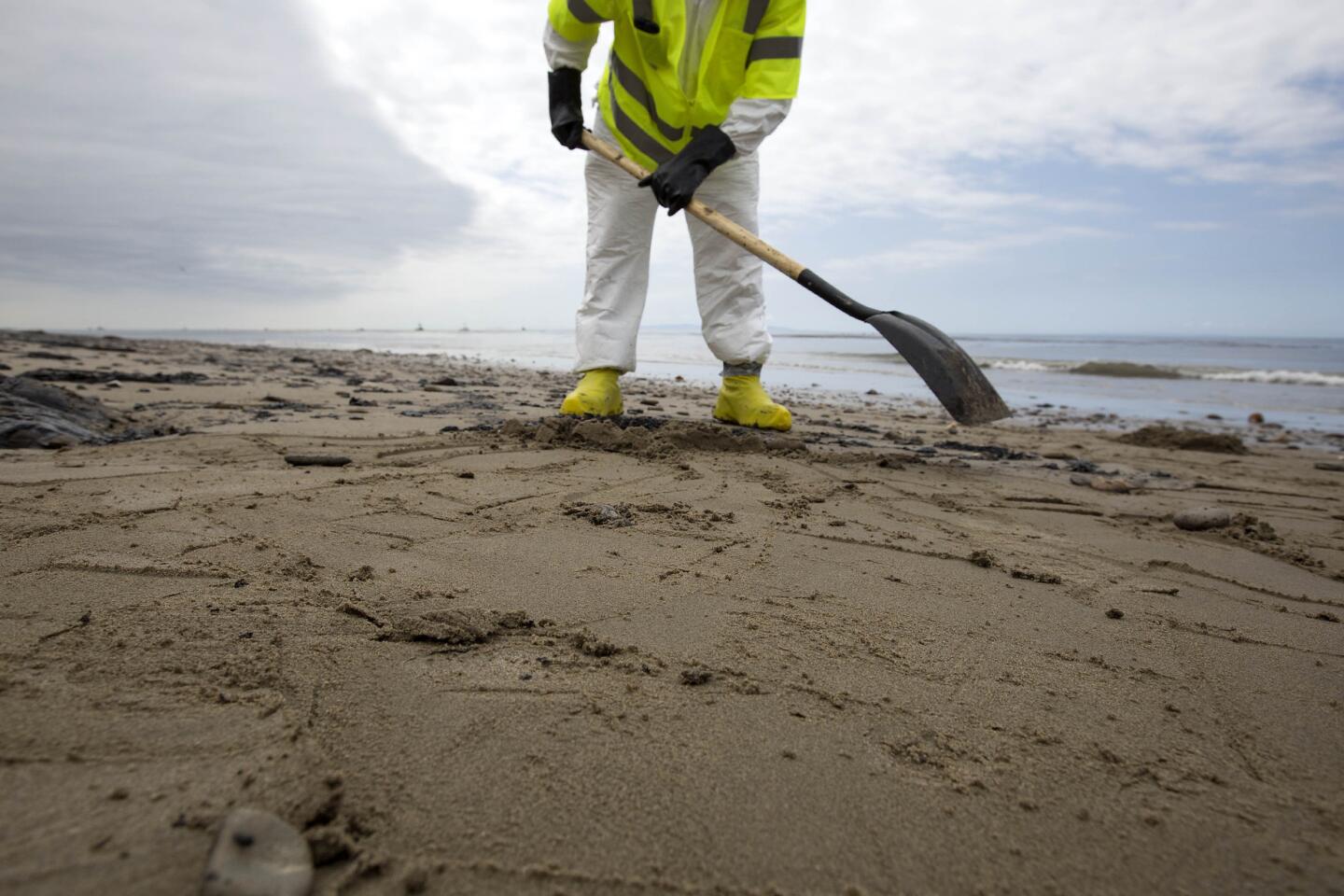
Patriot Environmental Services employee scrapes up oil-contaminated sand into small piles for removal on the shoreline at Refugio State Beach.
(Brian van der Brug / Los Angeles Times)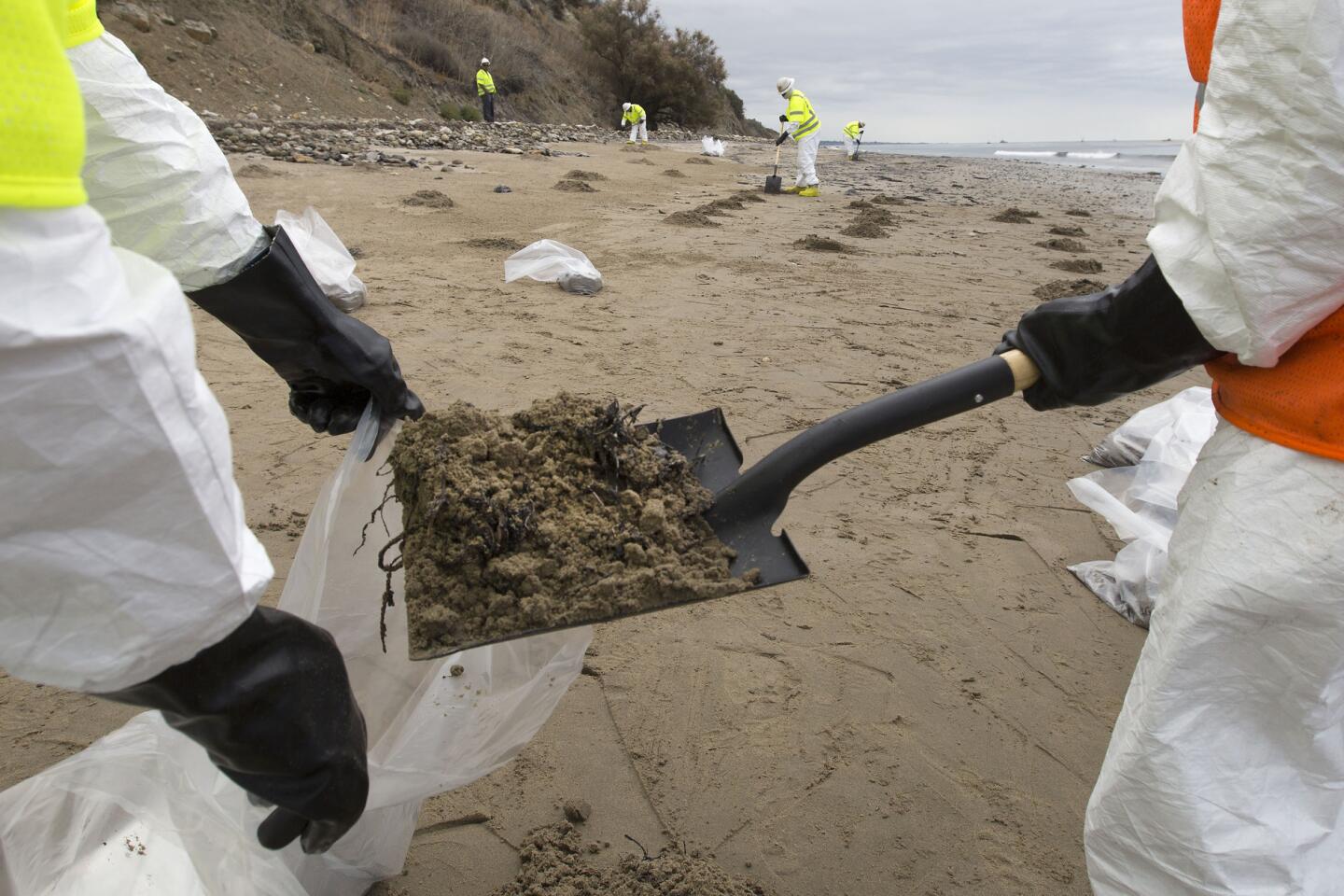
Patriot Environmental Services employees bag oil-contaminated sand on the shoreline at Refugio State Beach.
(Brian van der Brug / Los Angeles Times)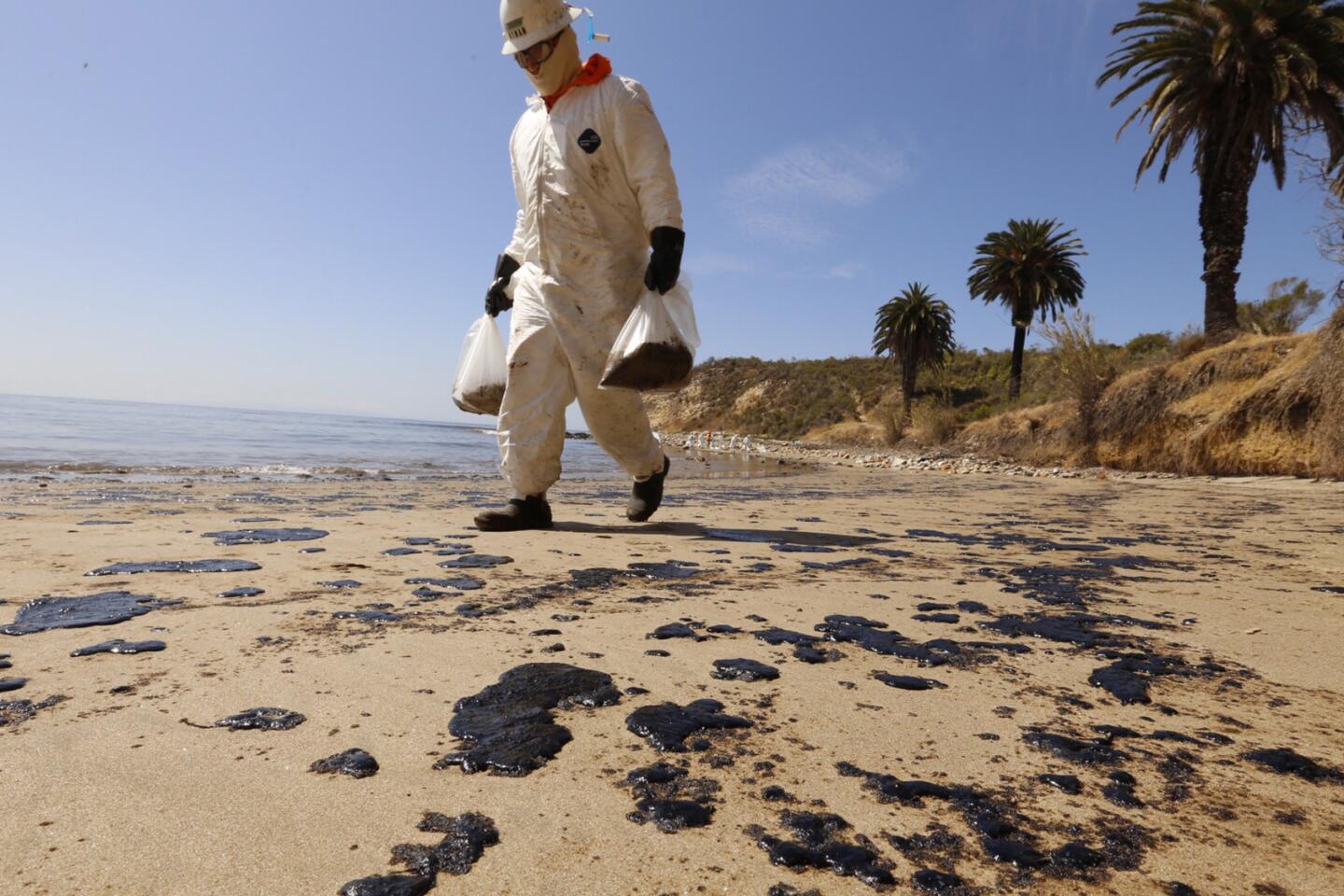
Crews from West Coast Environmental bag oiled sand on the beach as a cleanup operation began at Refugio State Beach on Wednesday morning.
(Al Seib / Los Angeles Times)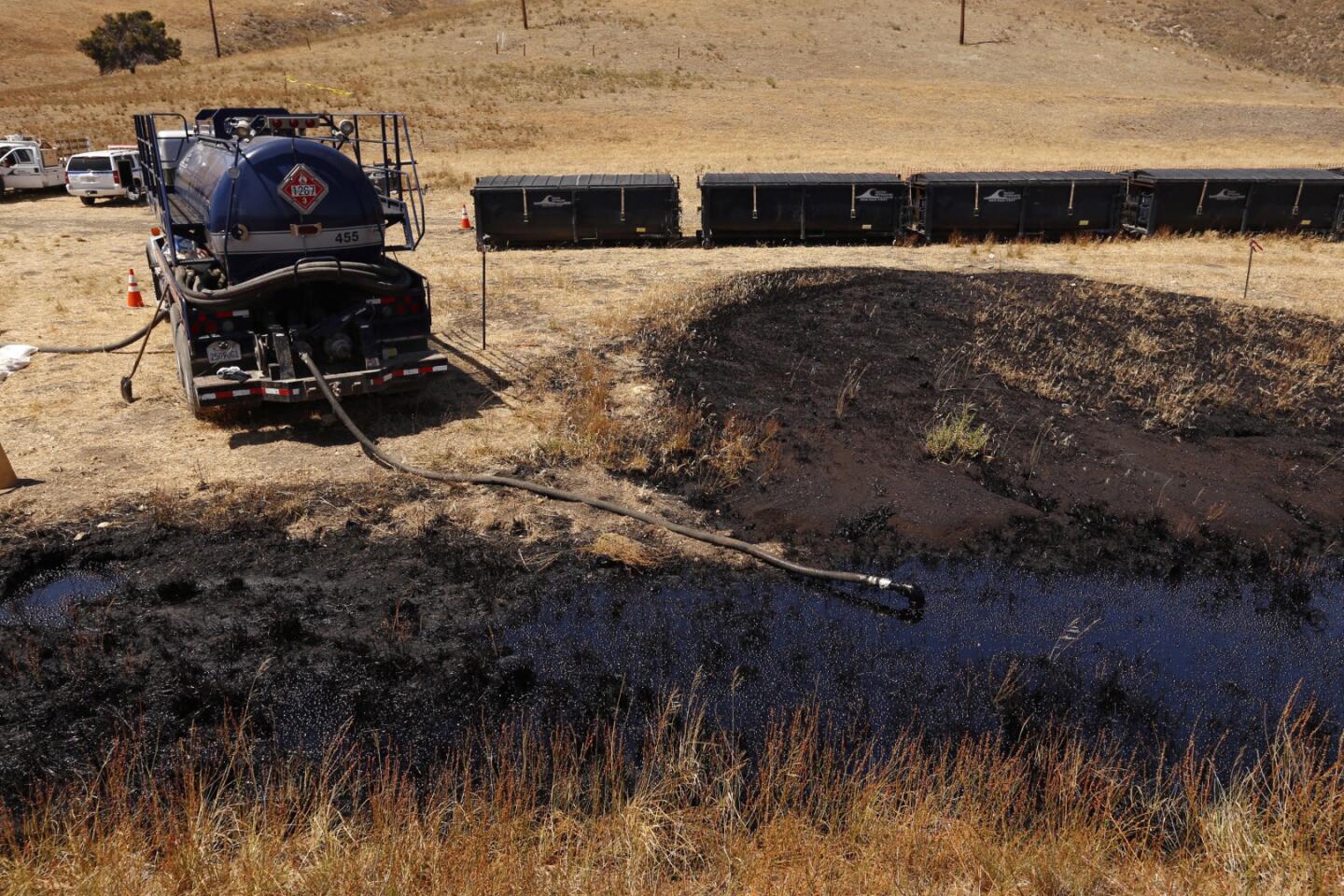
Point of origin where the oil pipeline ruptured.
(Al Seib / Los Angeles Times)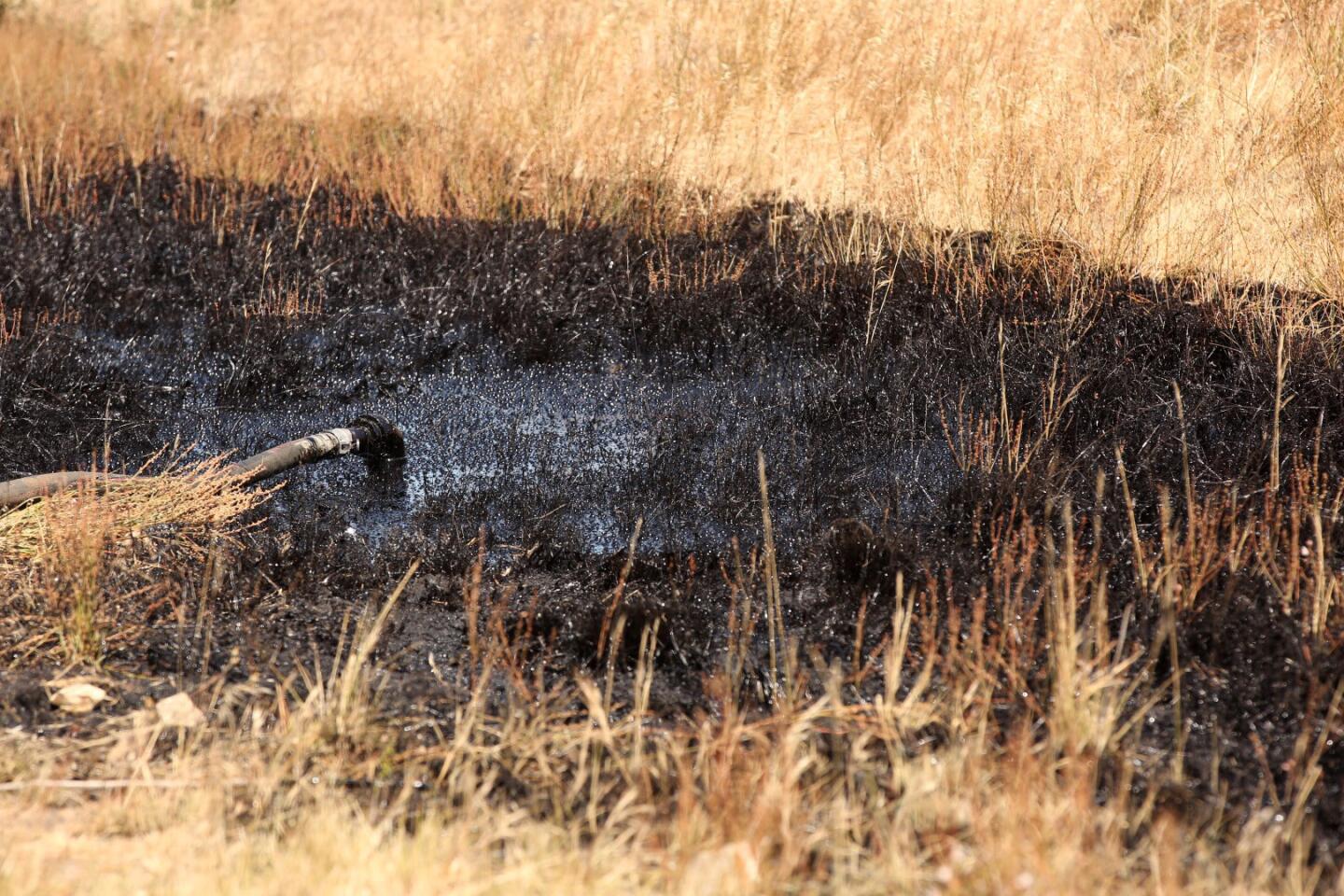
Point of origin where the oil pipeline ruptured.
(Al Seib / Los Angeles Times)
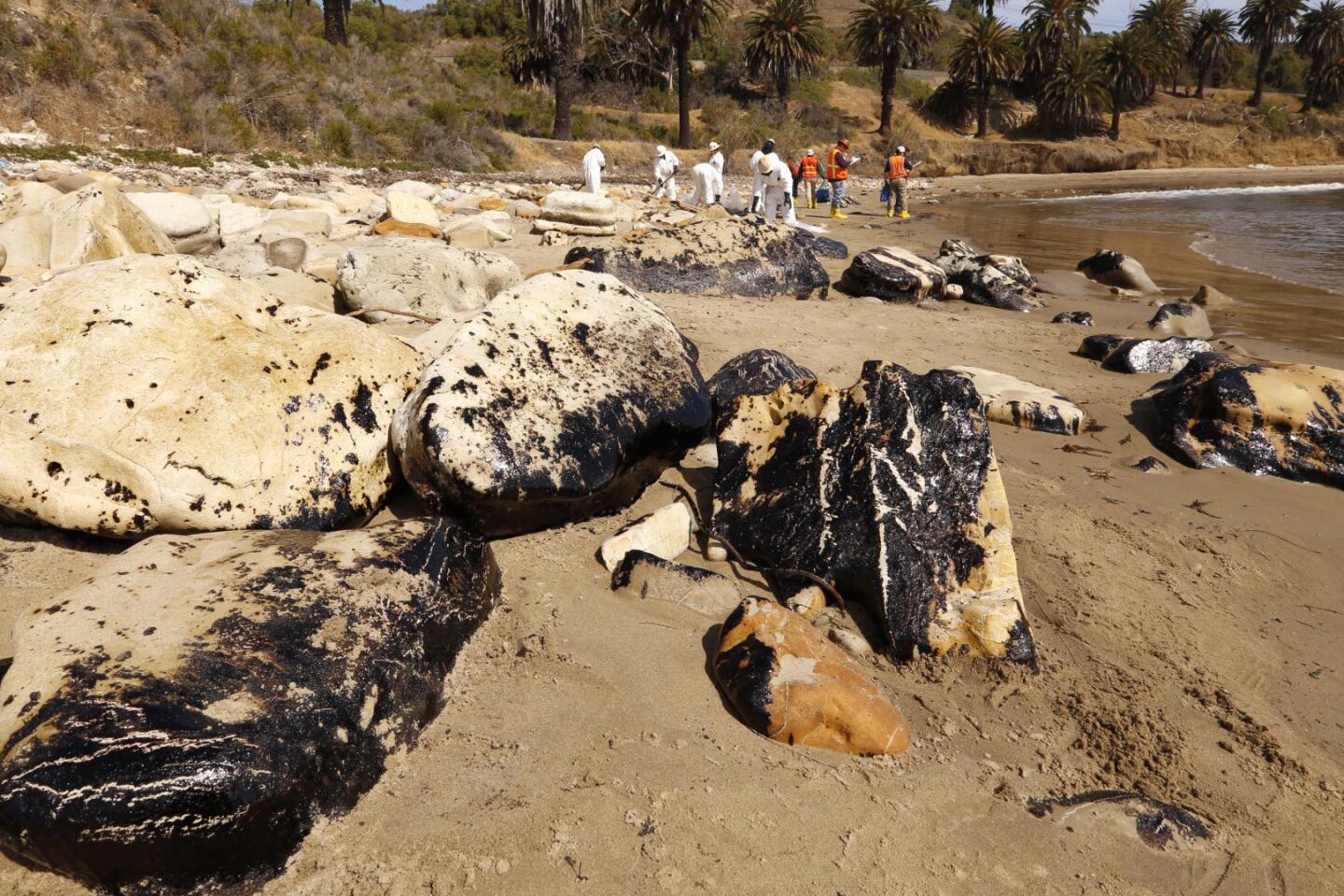
Crews bag oiled sand on the beach as cleanup begins.
(Al Seib / Los Angeles Times)
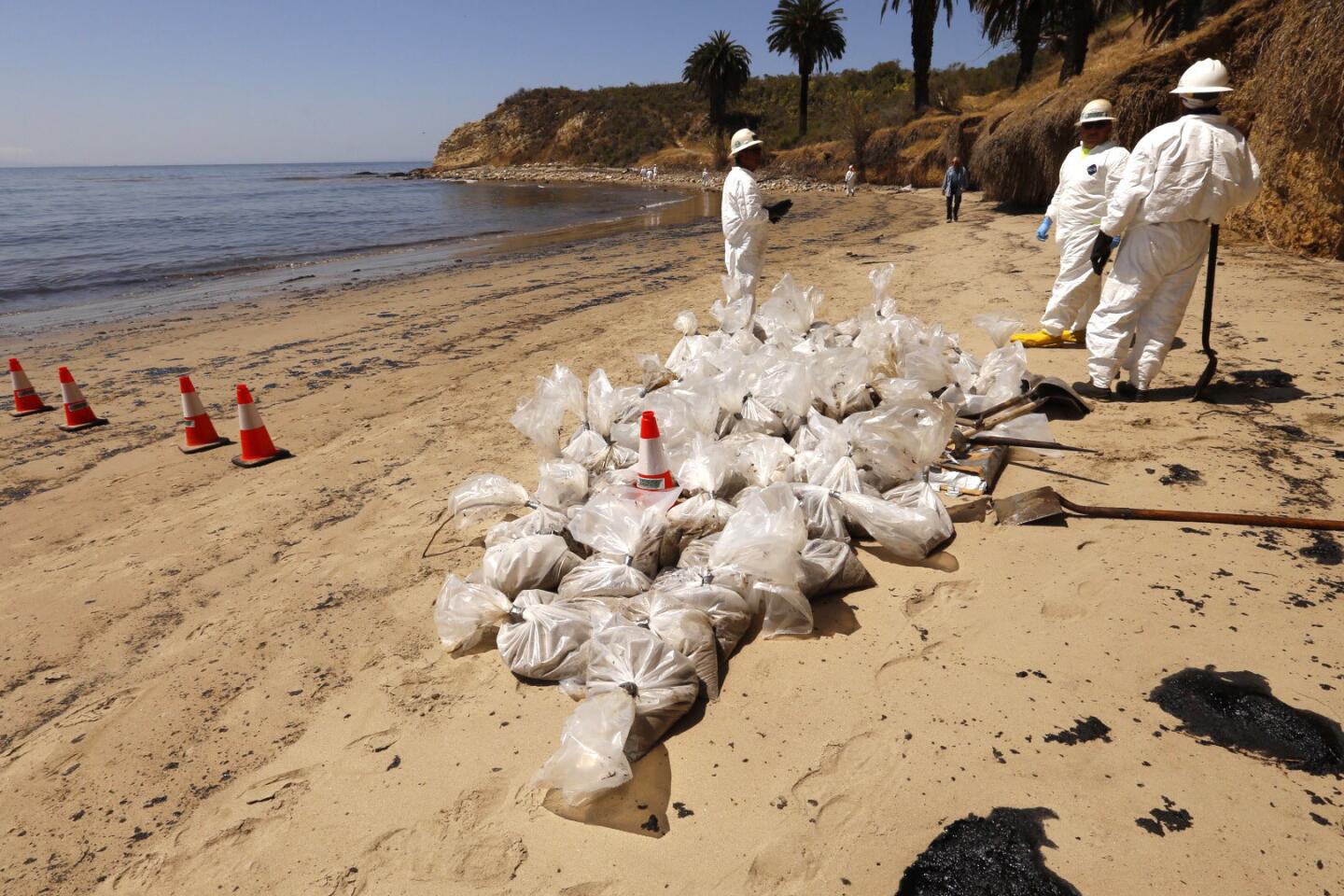
Peuyoko Perez, a Native American monitor from the Chumash southern owl clan, prays as crews bag oiled sand.
(Al Seib / Los Angeles Times)
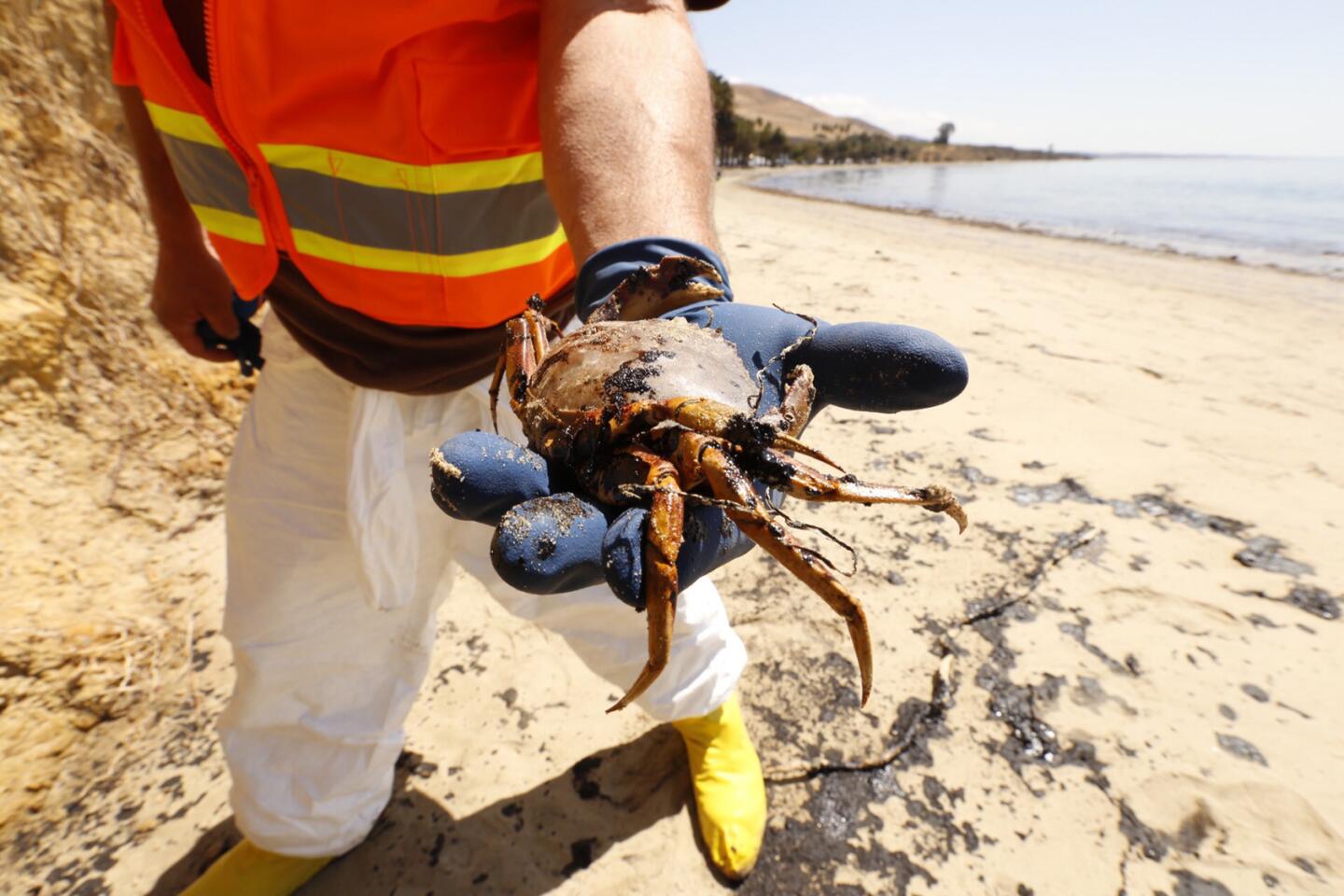
Peuyoko Perez a Native American monitor from the Chumash southern owl clan, prays over a dead crab.
(Al Seib / Los Angeles Times)
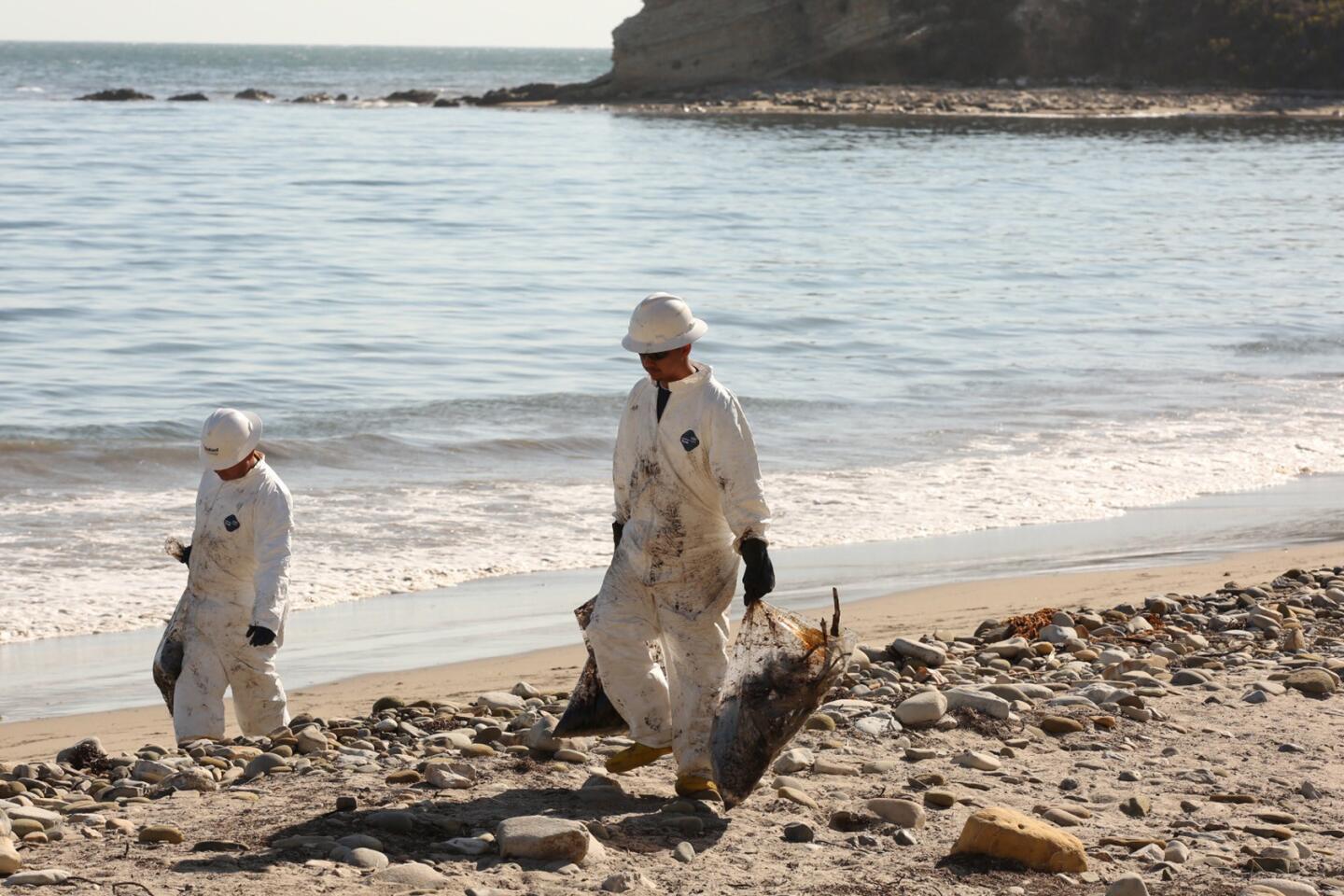
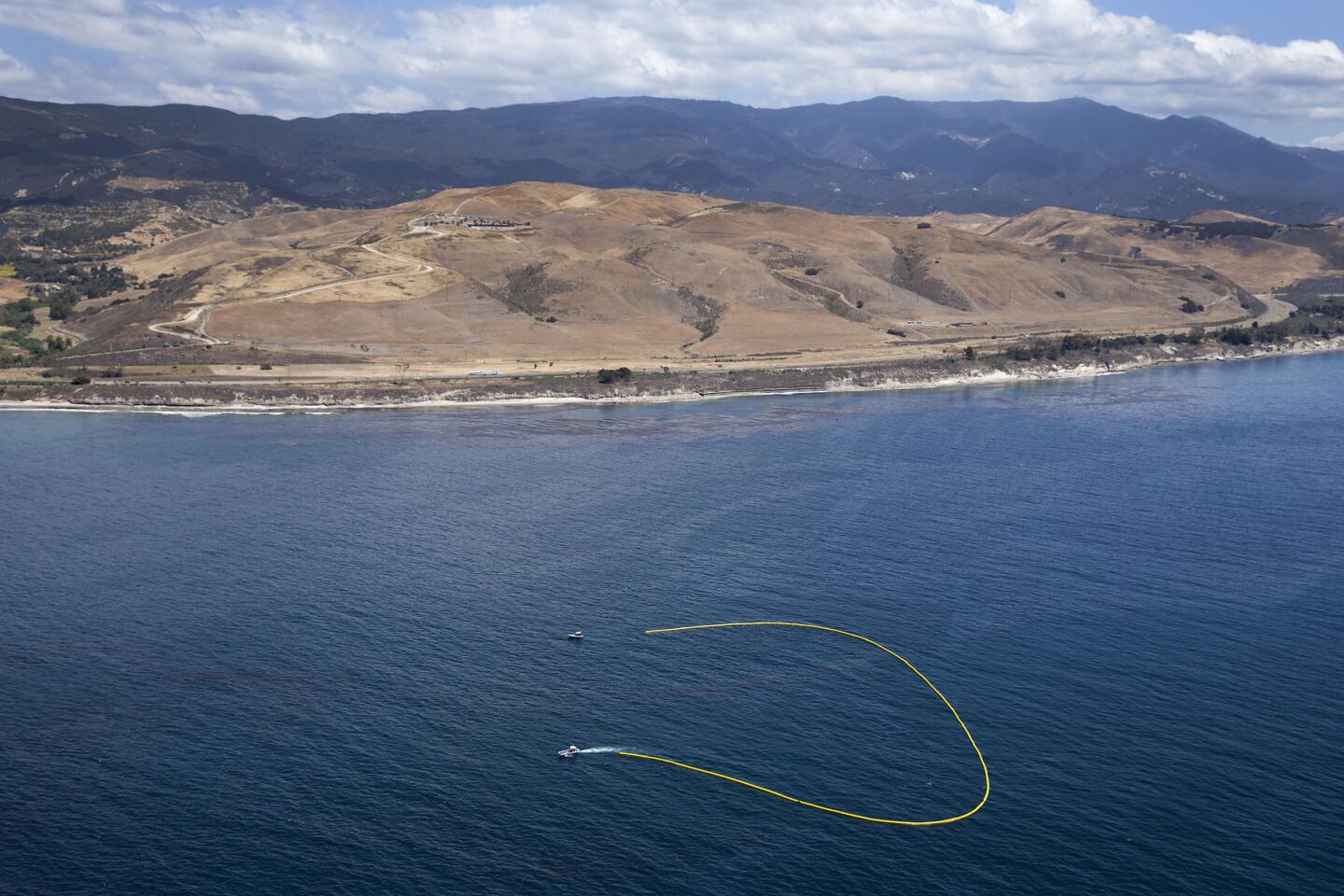
Oil booms are deployed offshore as cleanup and containment efforts continue on the beaches in Santa Barbara County.
(Brian van der Brug / Los Angeles Times)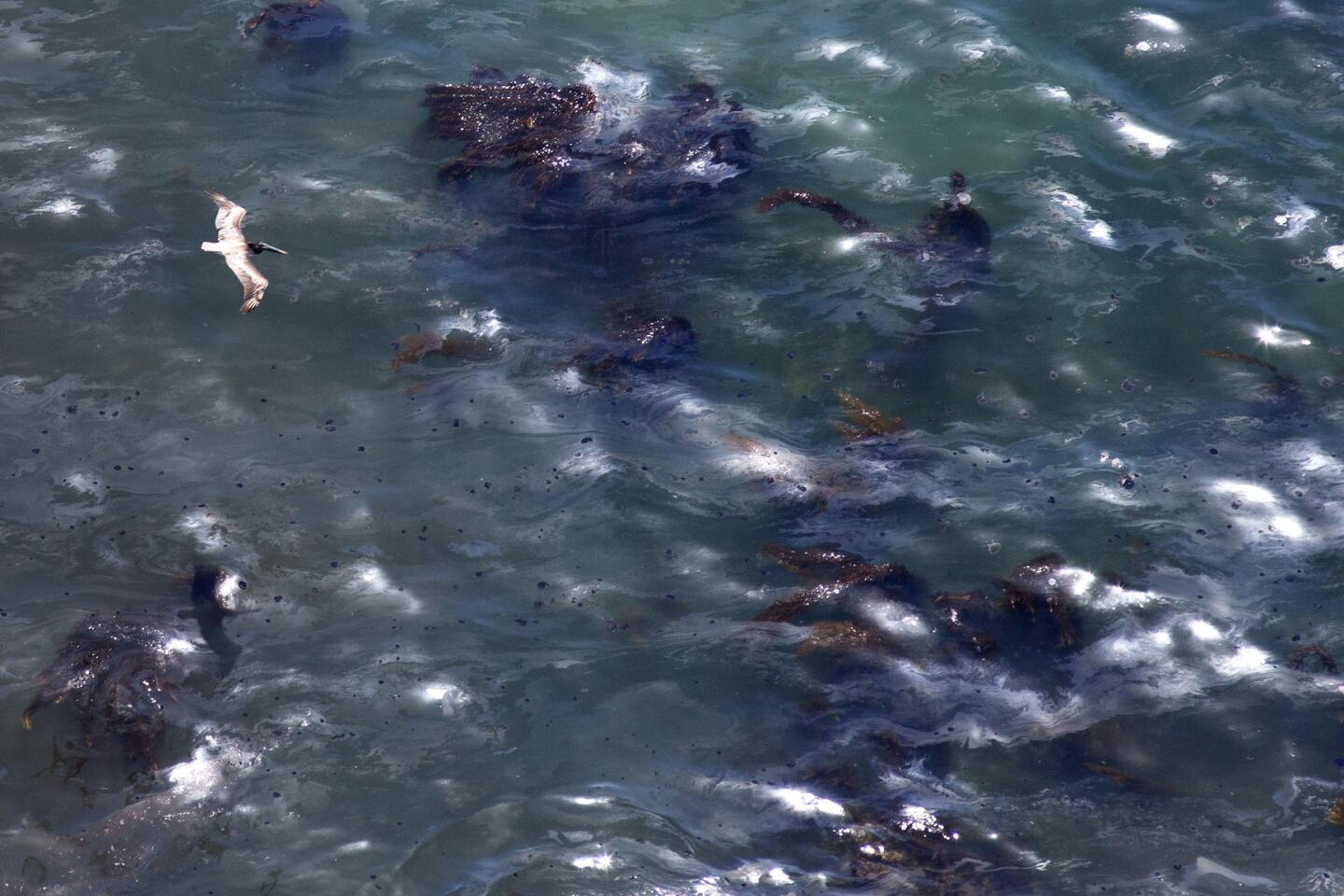
A pelican glides over oil-soaked kelp and oil sheen as a cleanup effort continues on the beaches in Santa Barbara County.
(Brian van der Brug / Los Angeles Times)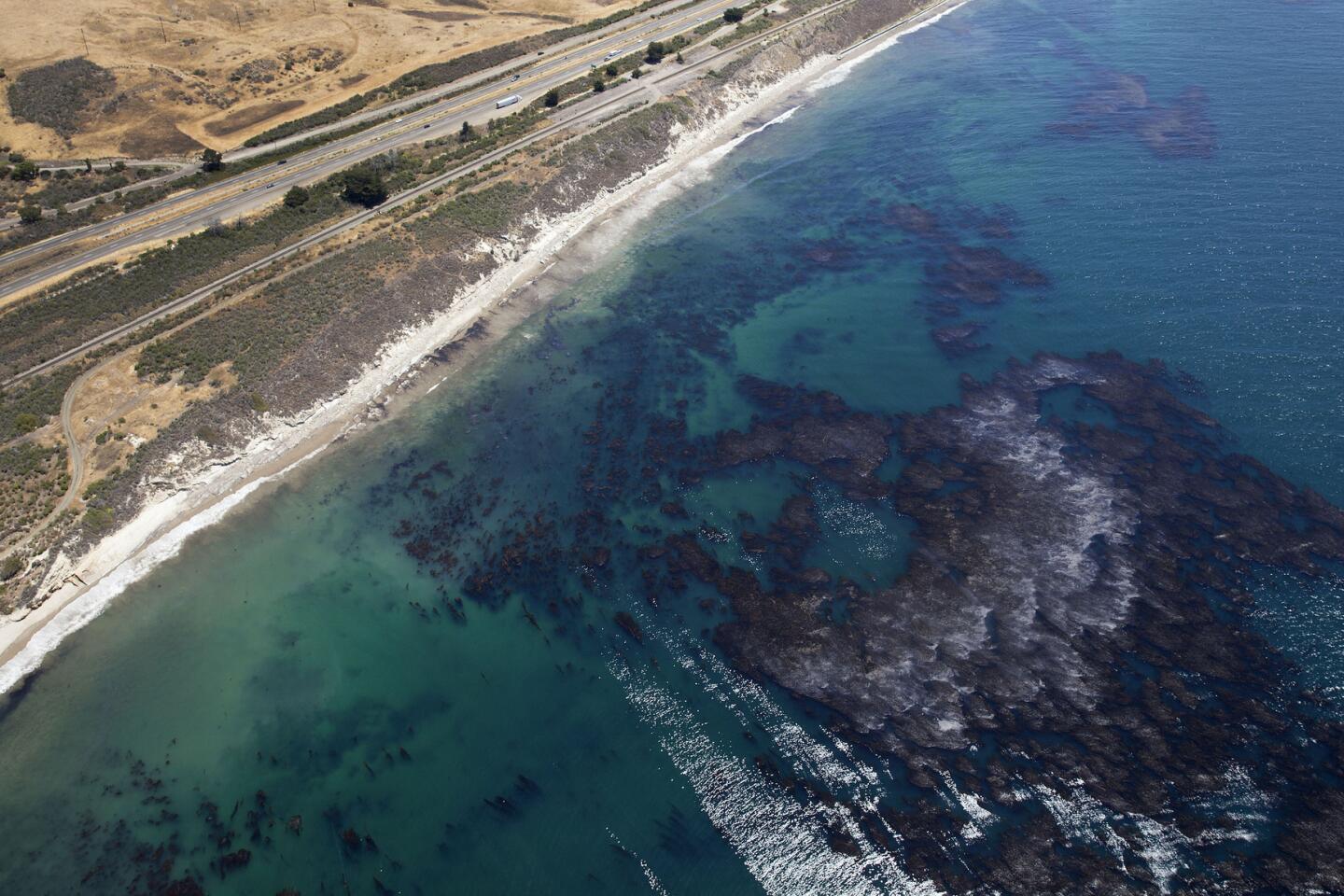
The oil spill fouls the waters and a kelp forest on May 20 as a cleanup effort continued along the coast in Santa Barbara County.
(Brian van der Brug / Los Angeles Times)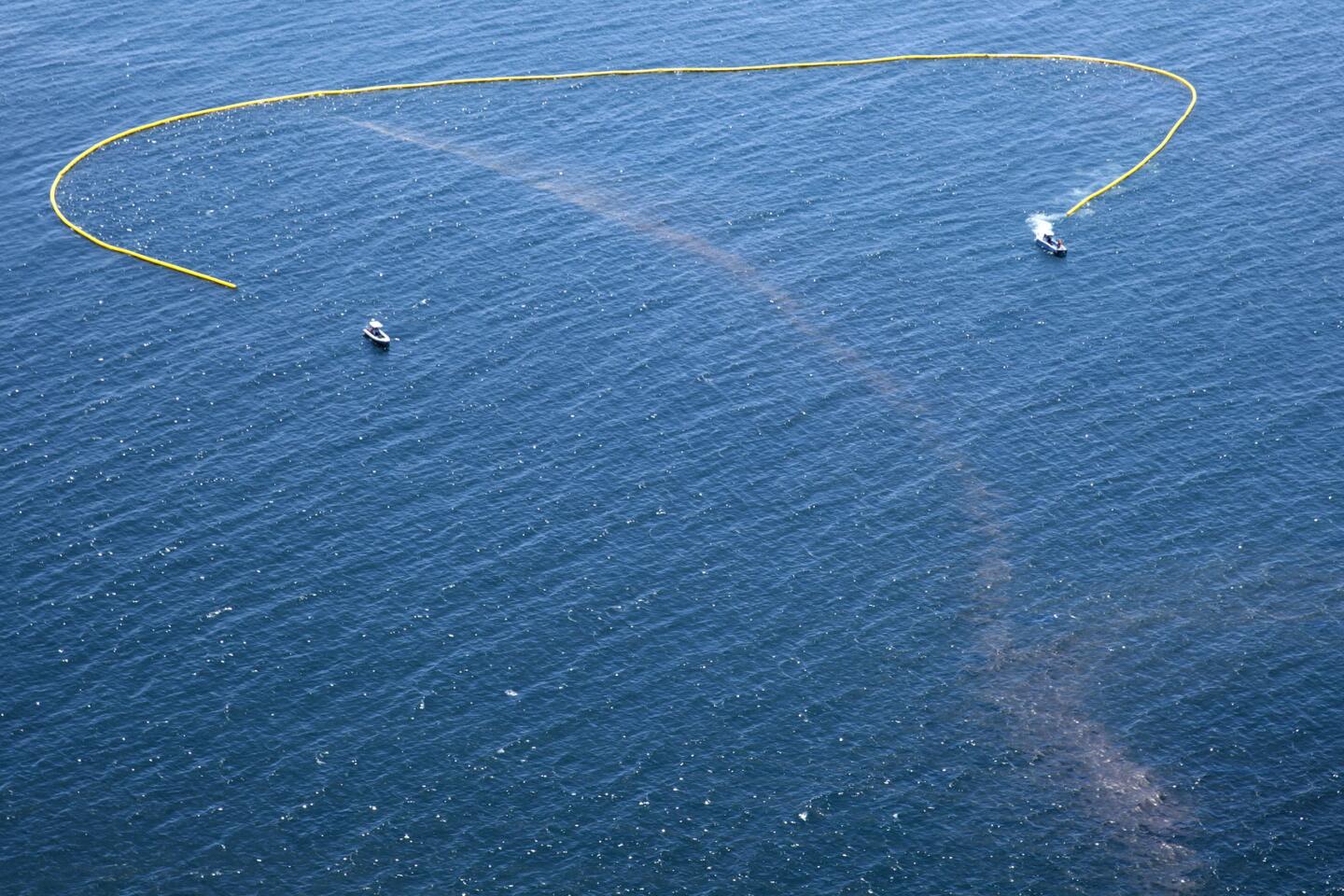
An oil boom is deployed offshore as the cleanup and containment effort continues along in Santa Barbara County.
(Brian van der Brug / Los Angeles Times)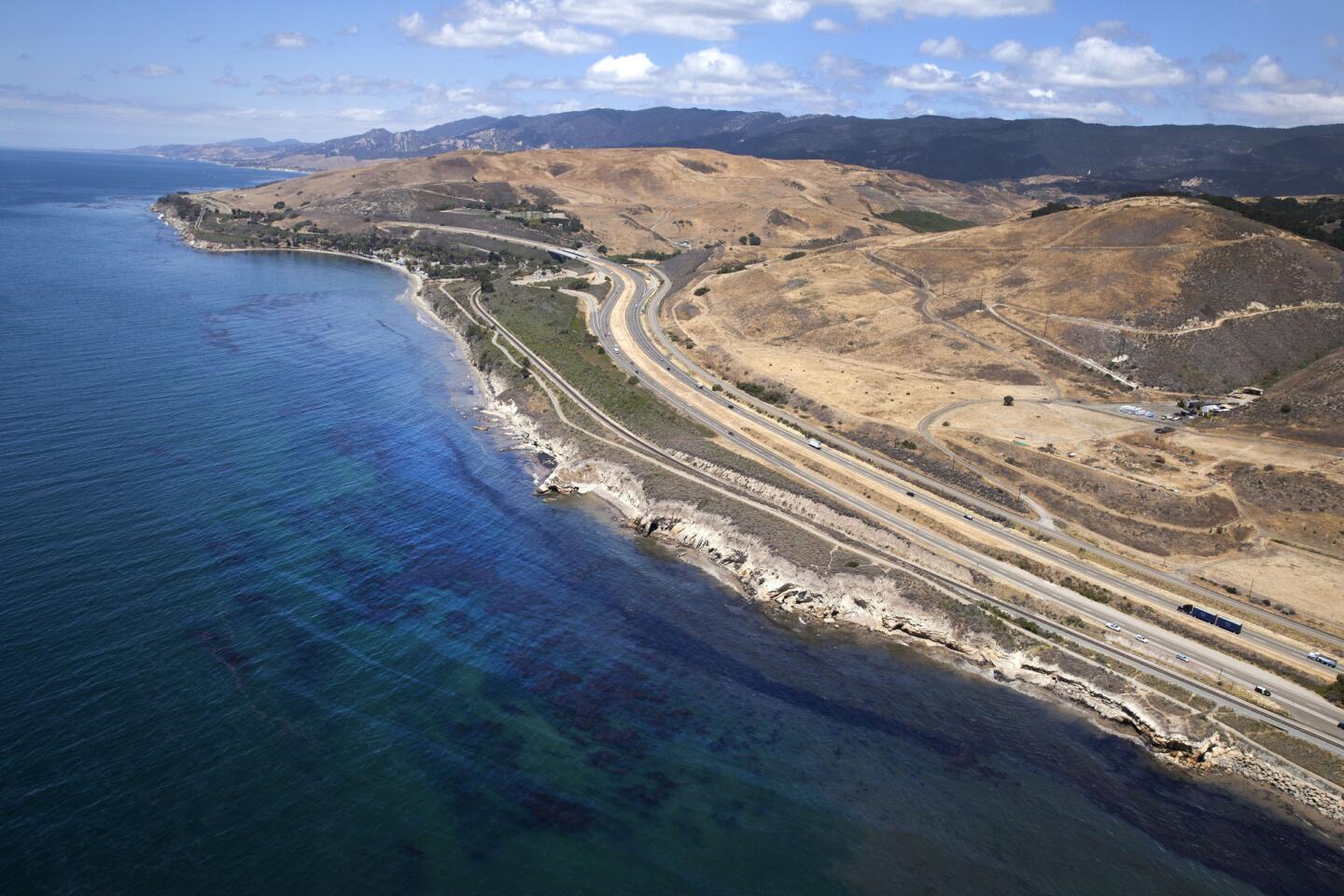
An oil sheen is visible in a kelp forest offshore as the cleanup effort continues along the coast in Santa Barbara County.
(Brian van der Brug / Los Angeles Times)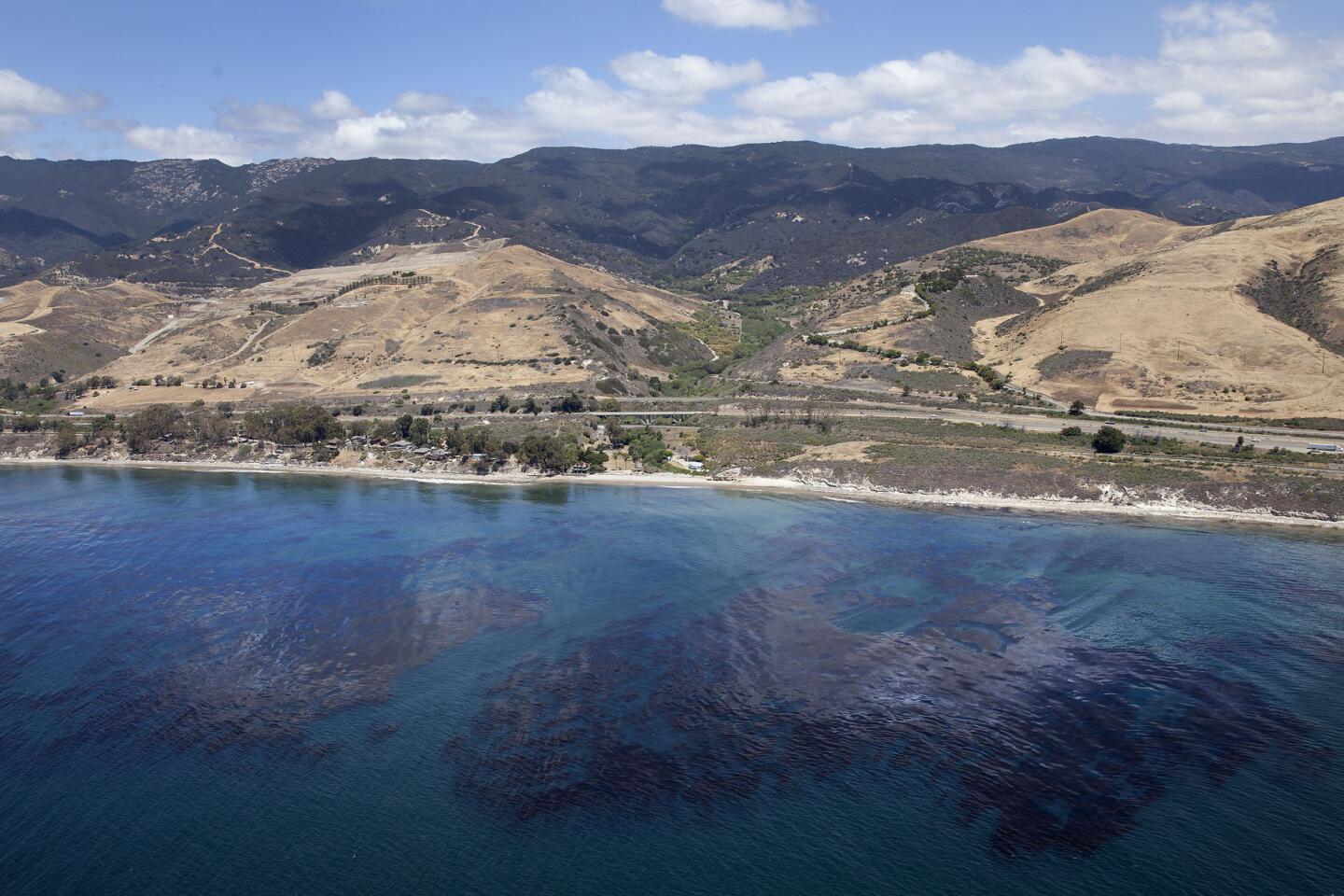
An oil sheen is visible in a kelp forest as cleanup effort continues along the coast in Santa Barbara County.
(Brian van der Brug / Los Angeles Times)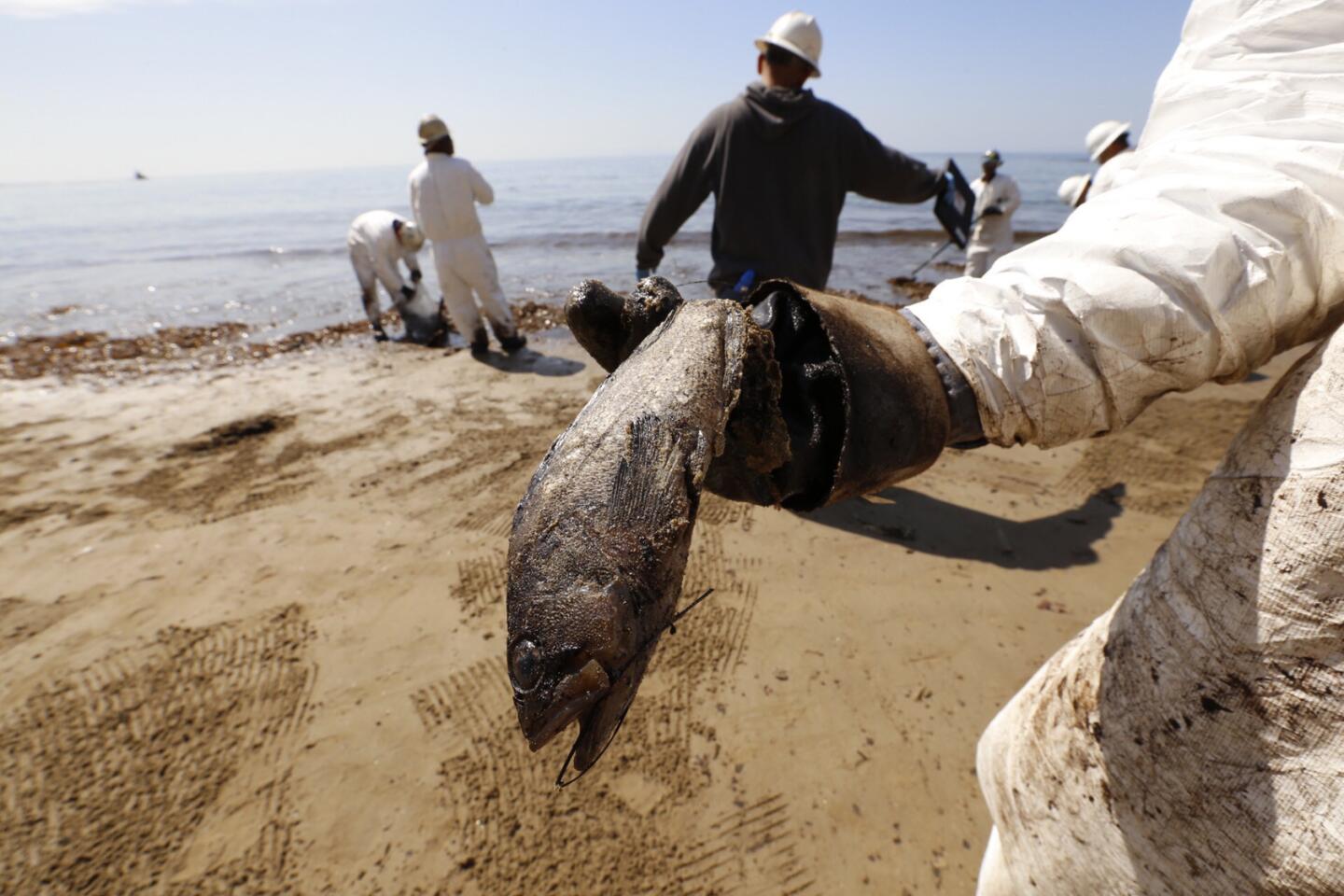
A crew member holds a dead fish as West Coast Environmental crews bag oiled sand at Refugio State Beach.
(Al Seib / Los Angeles Times)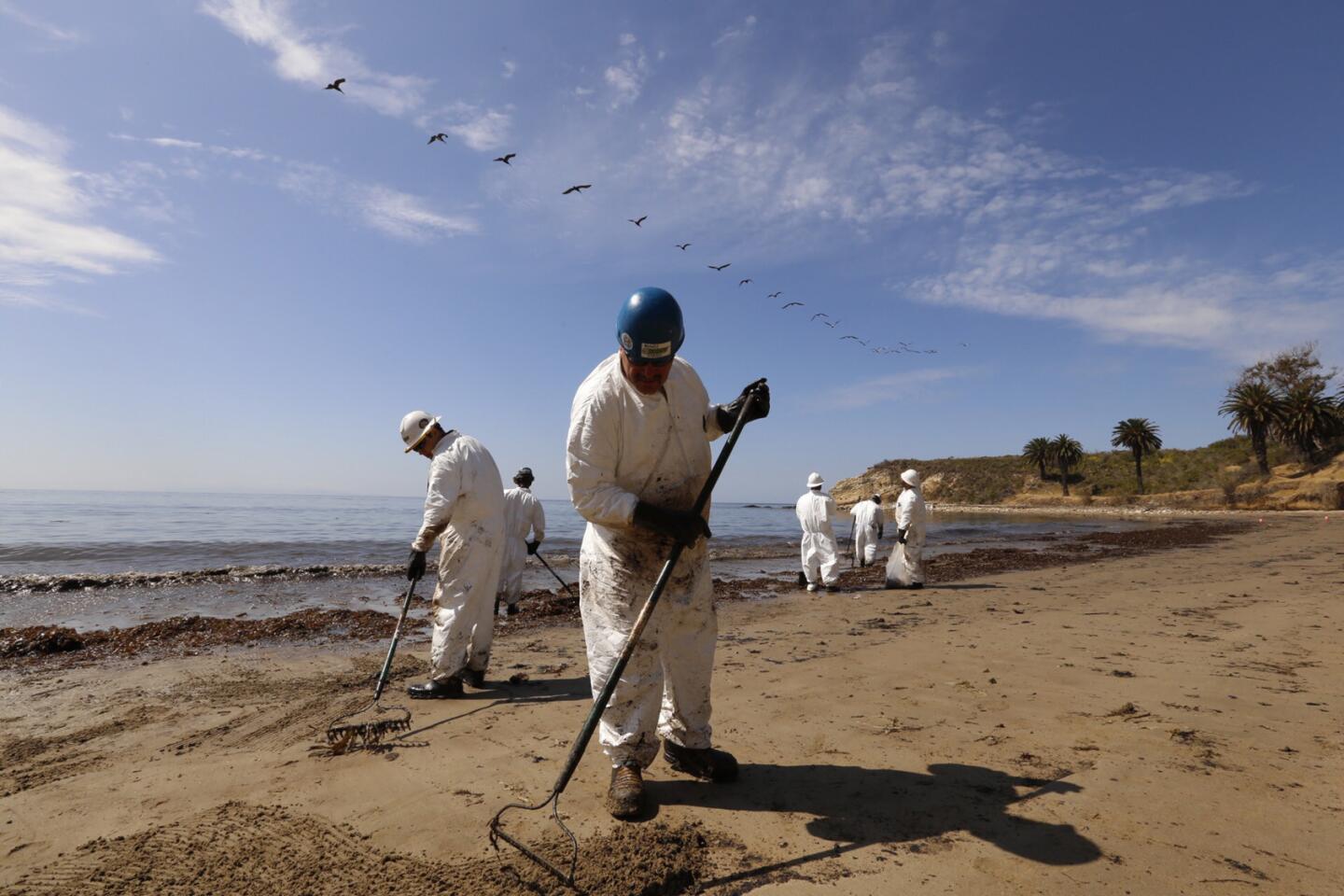
Pelicans fly ovehead as cleanup crews work at Refugio State Beach on Wednesday morning.
(Al Seib / Los Angeles Times)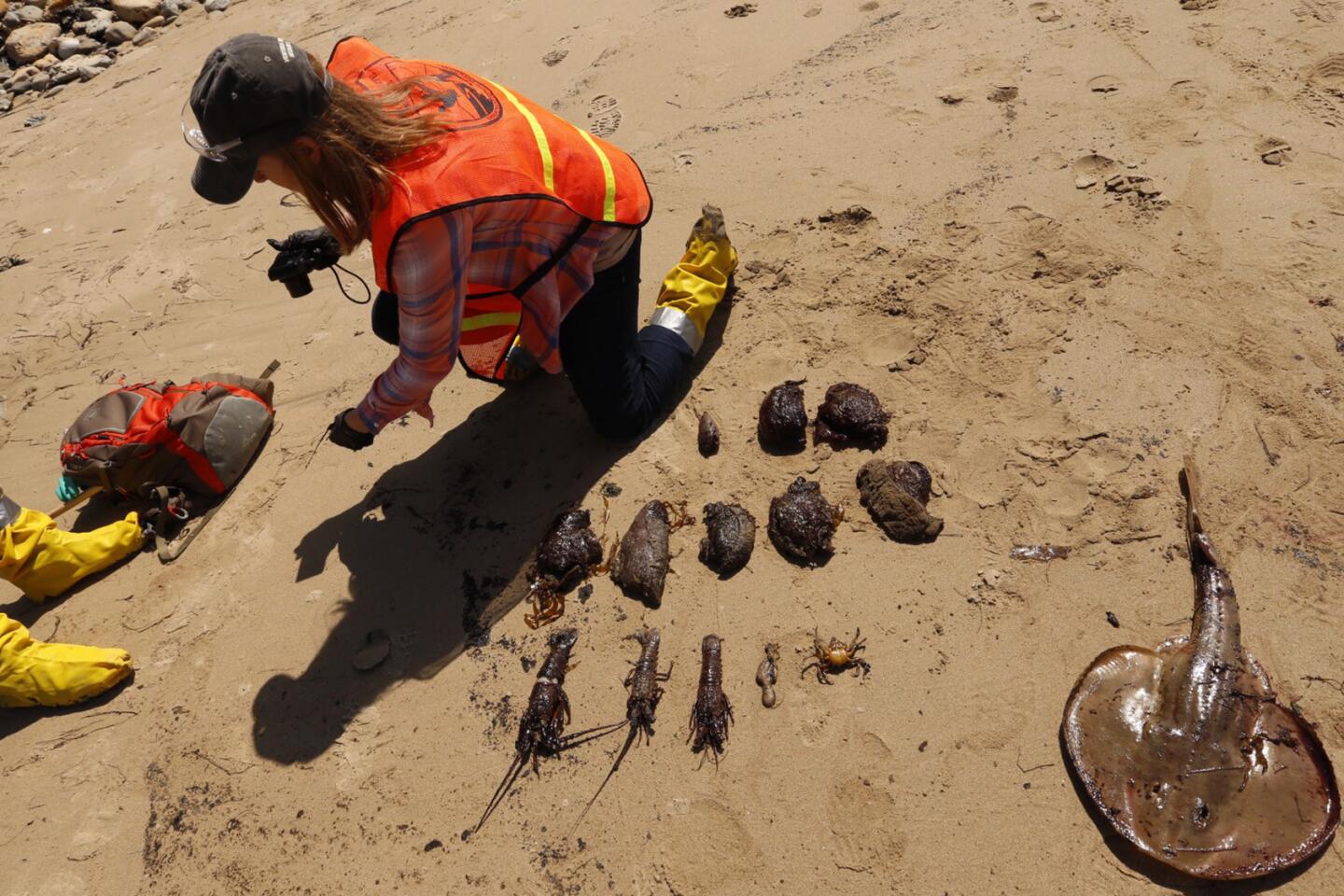
Jenny Marek and Bill Standley, wildlife biologists with the U.S. Fish and Wildlife National Resource Damage Asessment team, photograph and collect samples of dead wildlife on the beach.
(Al Seib / Los Angeles Times)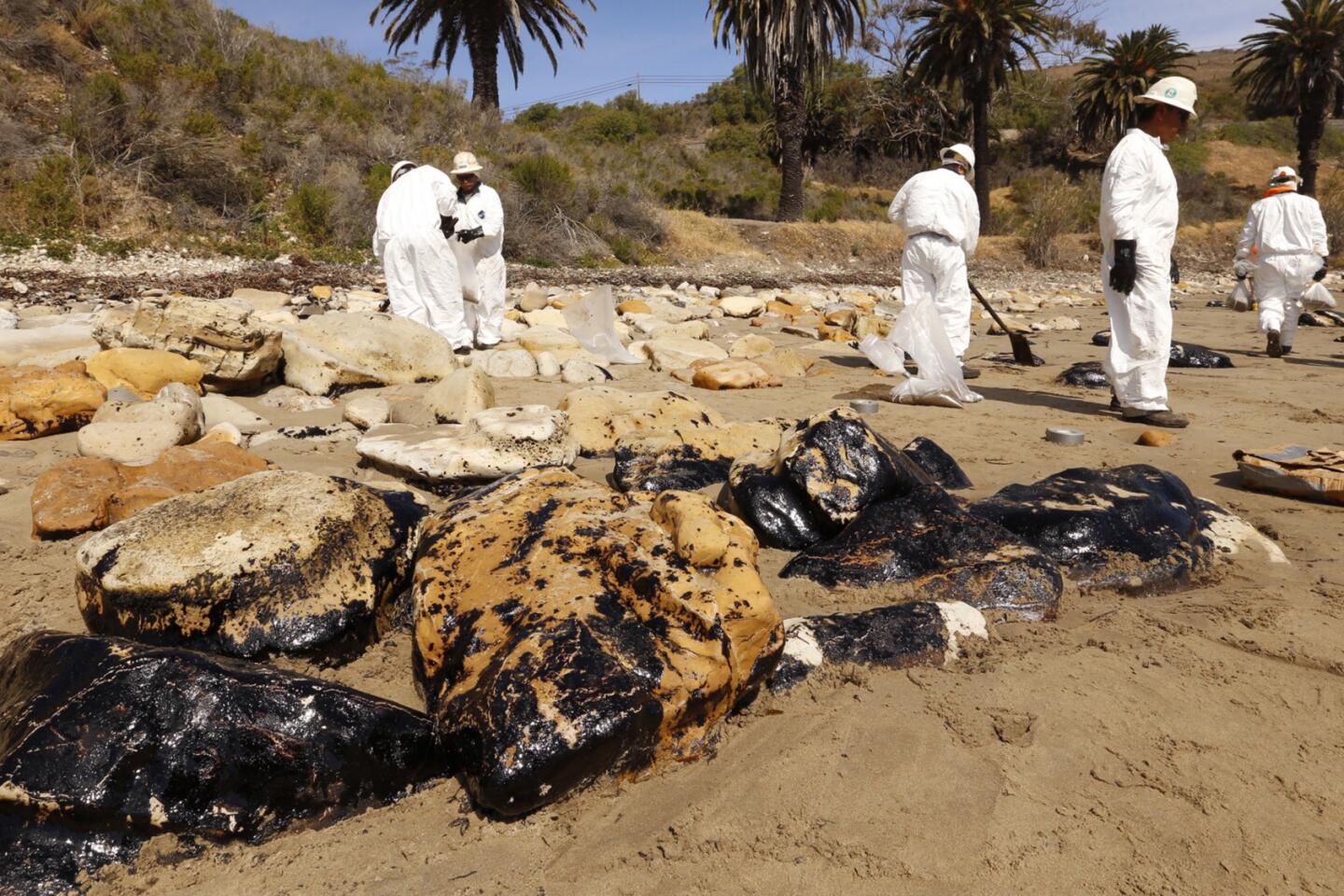
Oil covers rocks at Refugio State Beach on Wednesday.
(Al Seib / Los Angeles Times)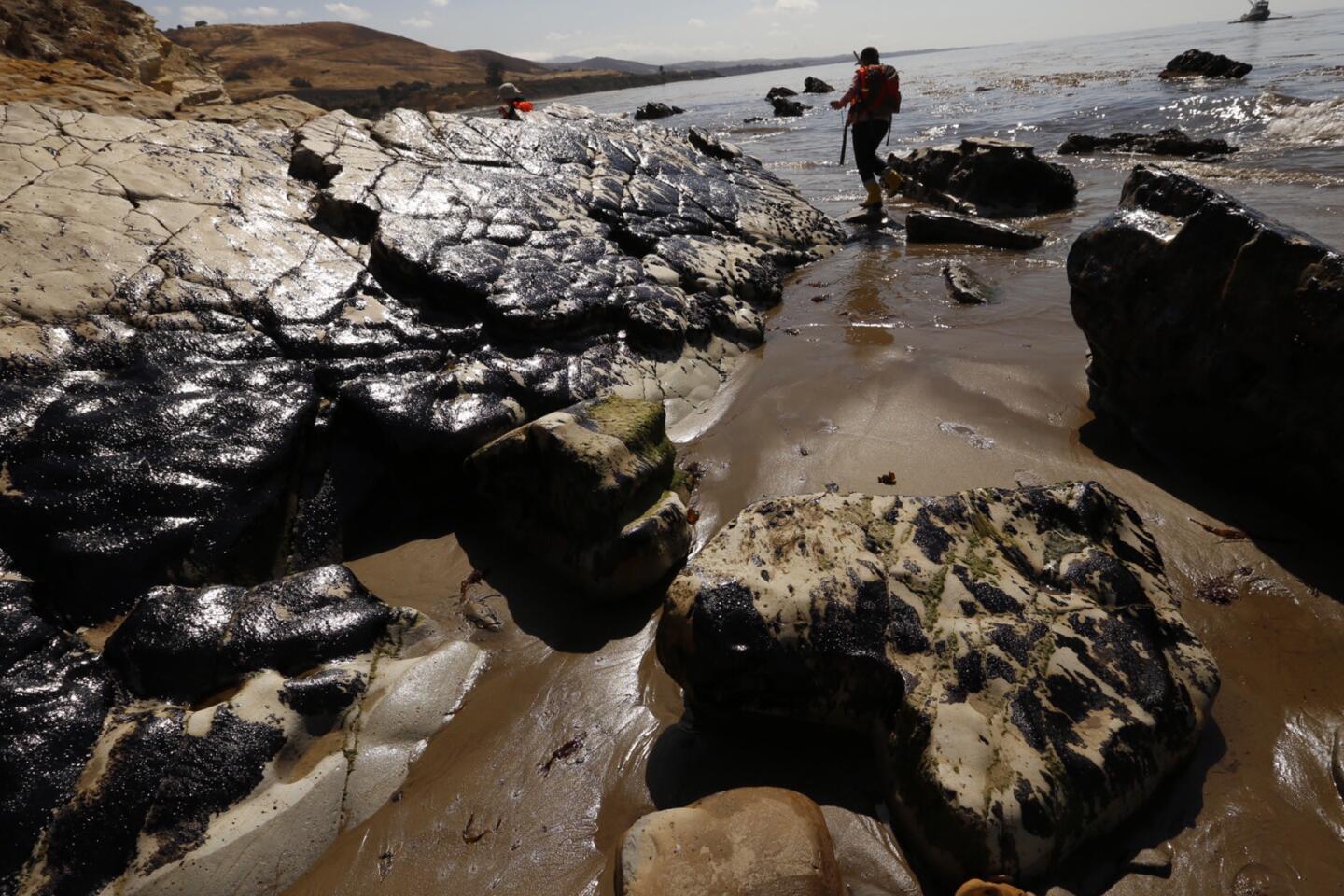
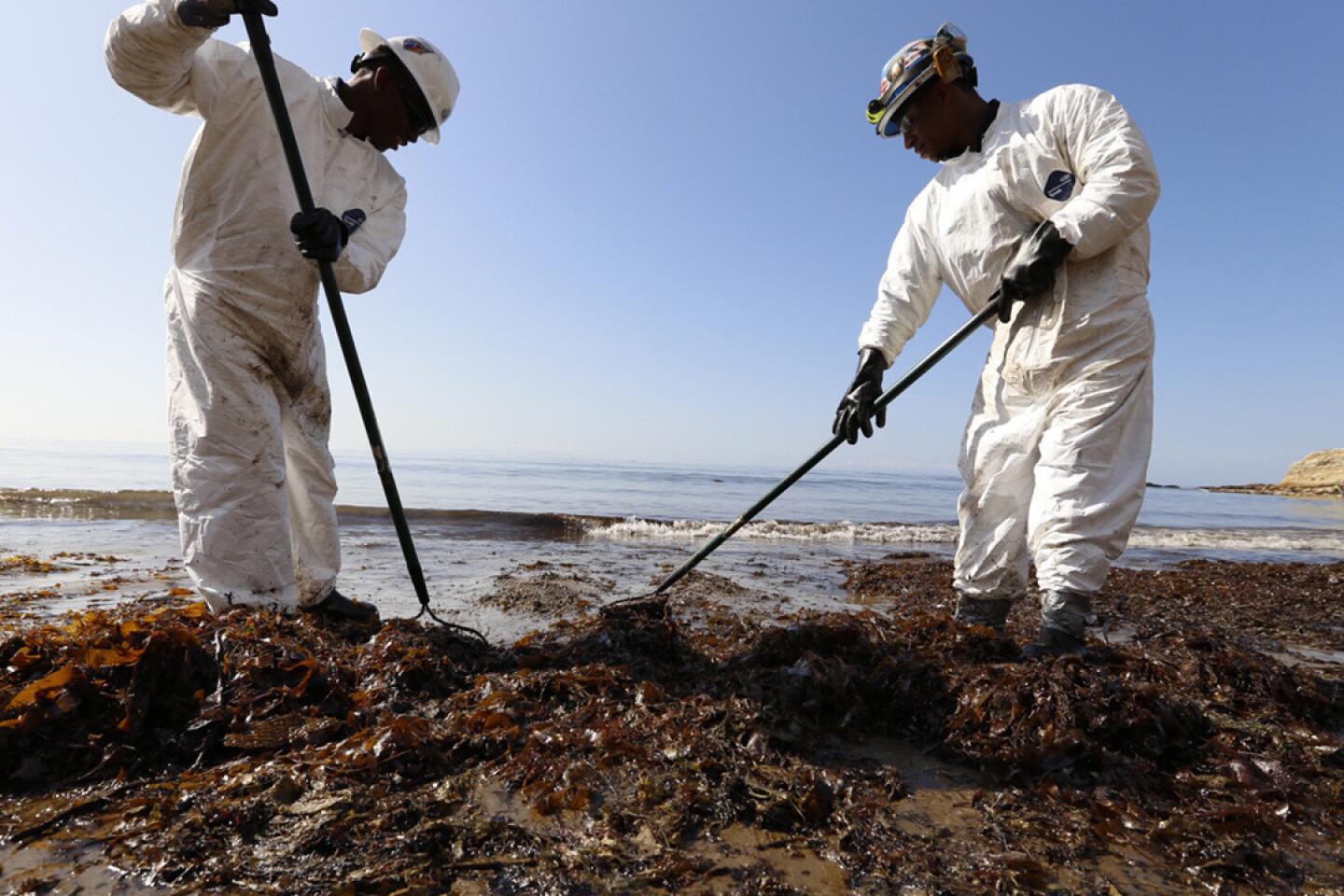
Patriot Cleanup workers bag oiled sand and kelp at Refugio State Beach on Wednesday morning.
(Al Seib / Los Angeles Times)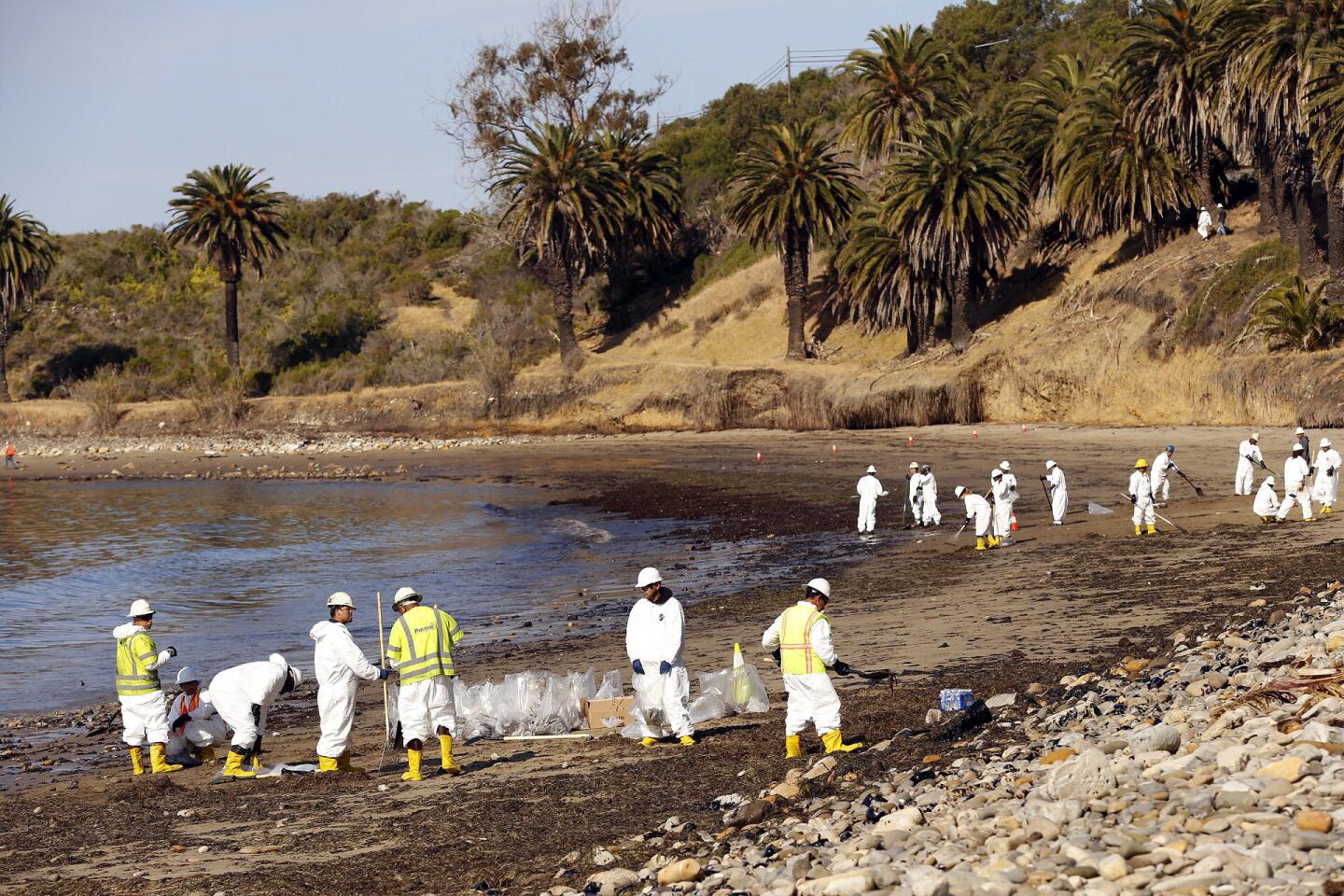
A cleanup operation is underway at Refugio State Beach after a ruptured pipeline near Santa Barbara leaked an estimated 21,000 gallons of crude oil.
(Al Seib / Los Angeles Times)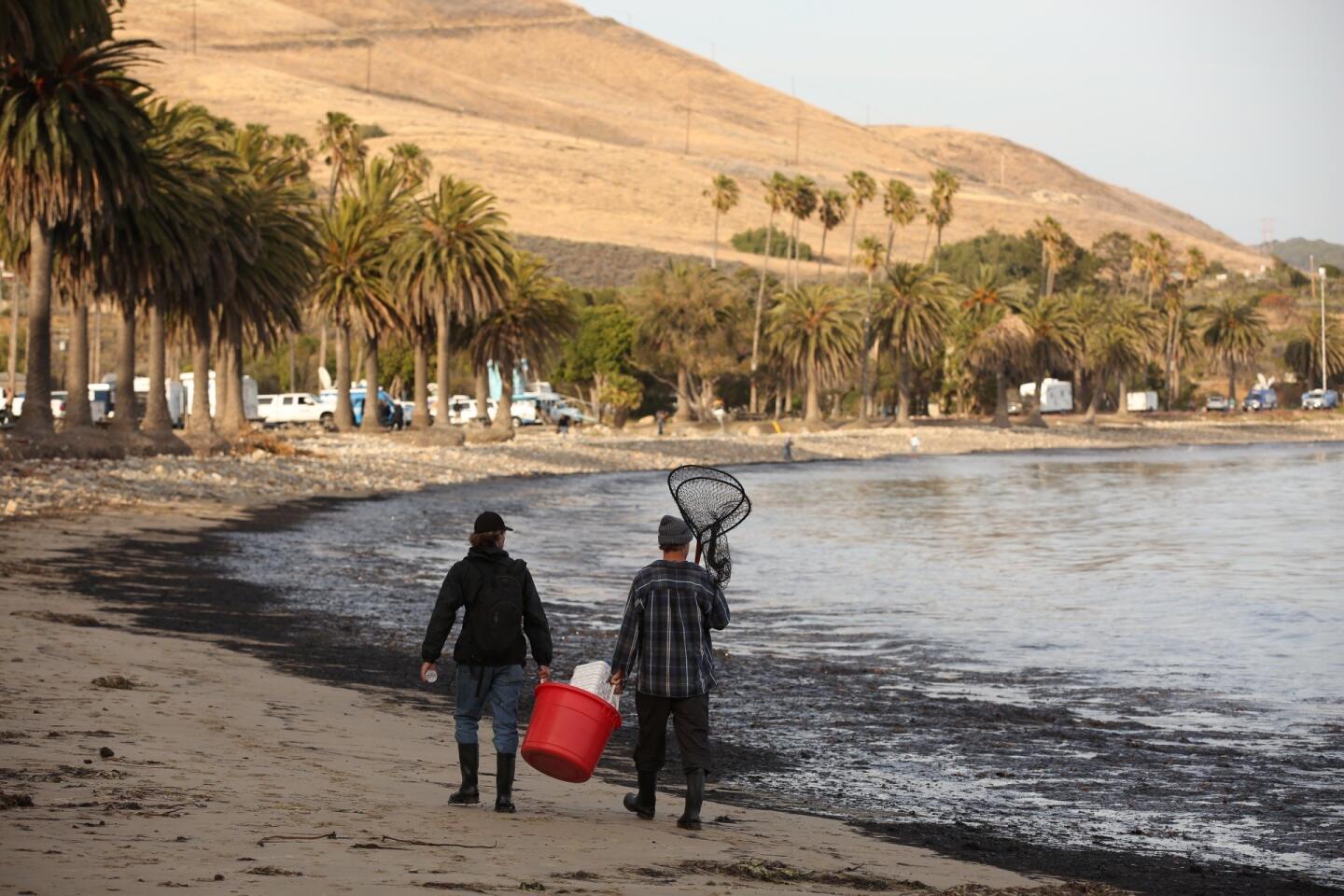
Morgan Miller, left, and Josh Marsh look for wildlife to rescue along the coast at Refugio State Beach.
(Al Seib / Los Angeles Times)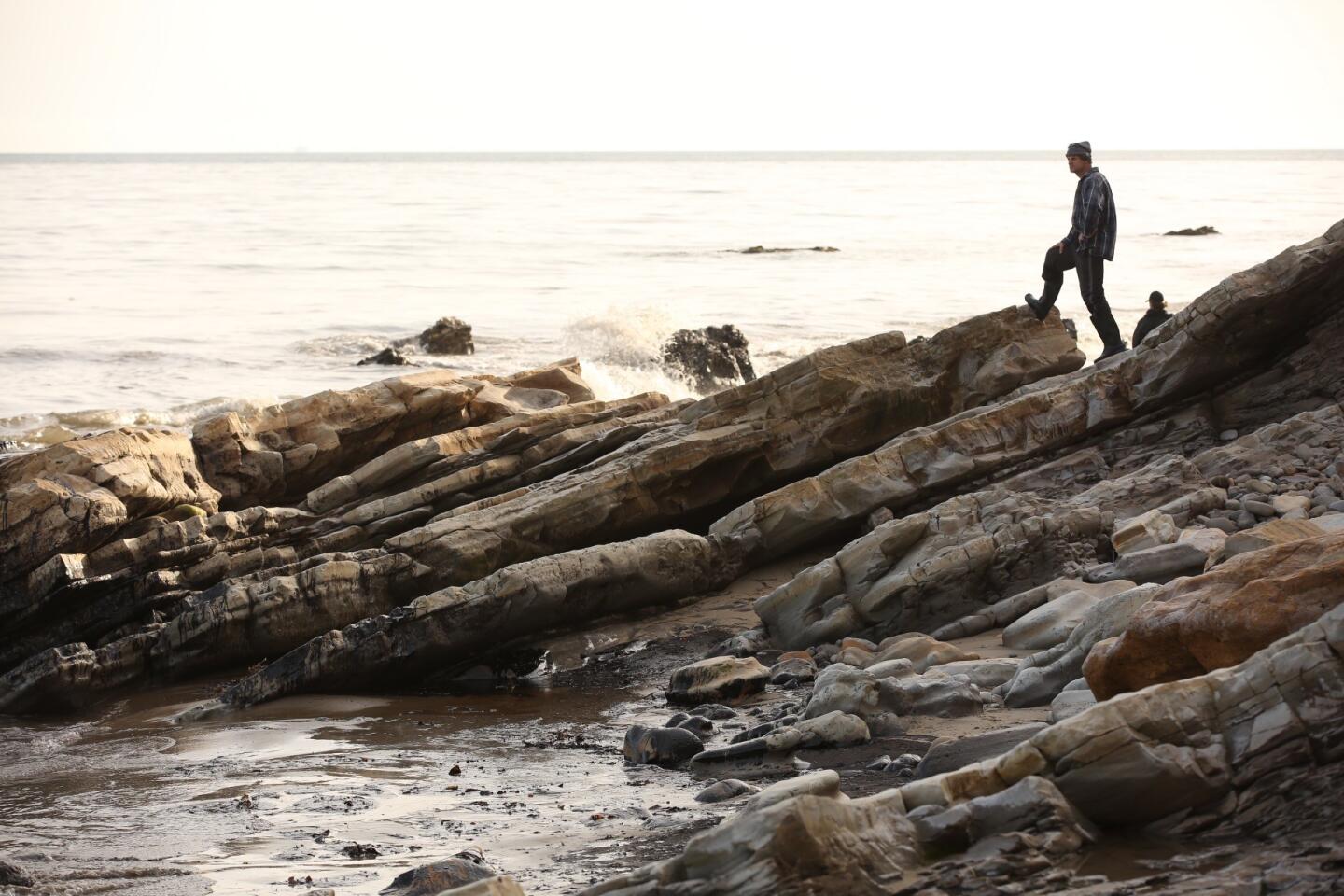
Josh Marsh, a longtime Santa Barbara resident, surveys the oil-coated Refugio State Beach, looking for wildlife to rescue.
(Al Seib / Los Angeles Times)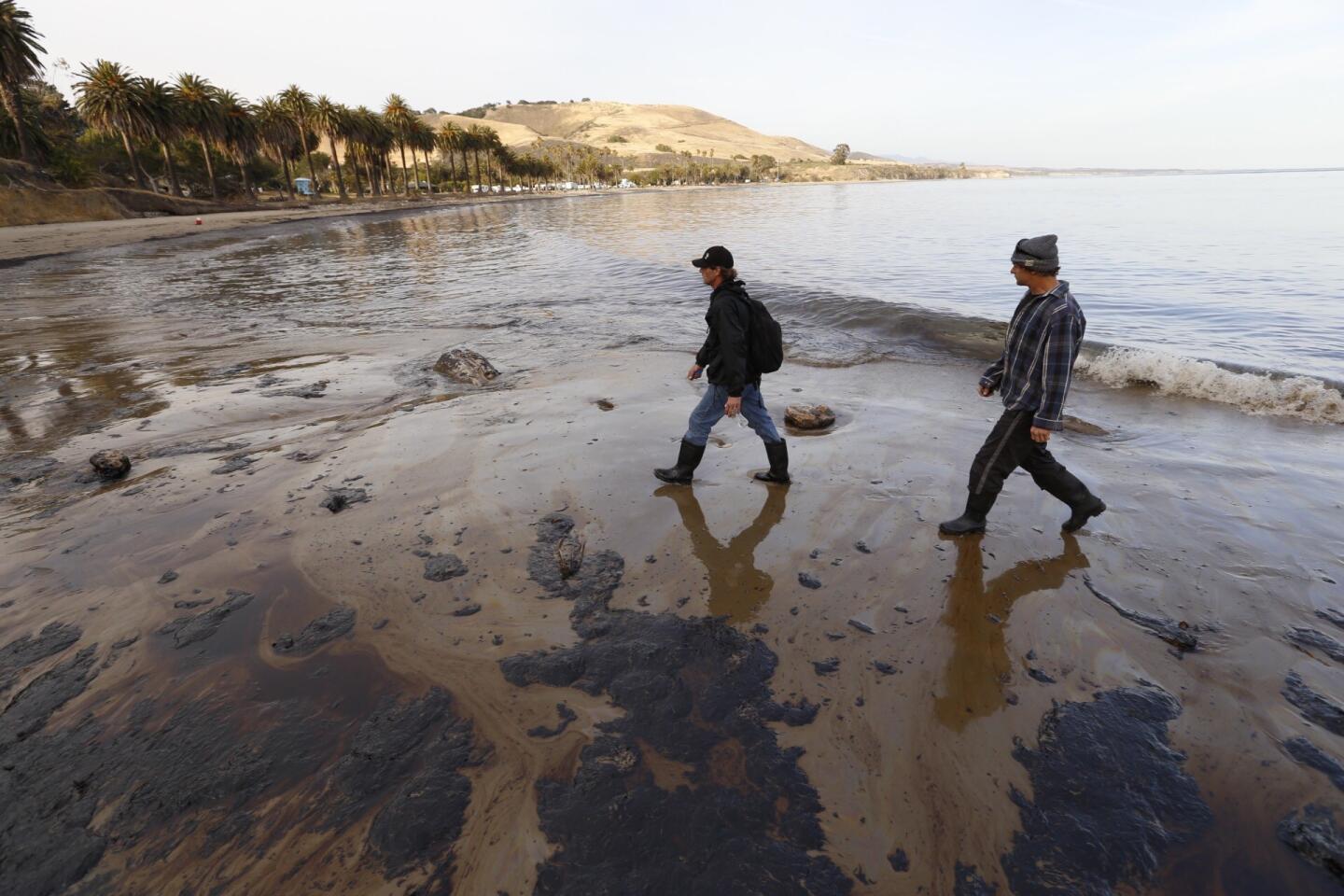
Morgan Miller, left, and Josh Marsh walk the oil-coated shore at Refugio State Beach.
(Al Seib / Los Angeles Times)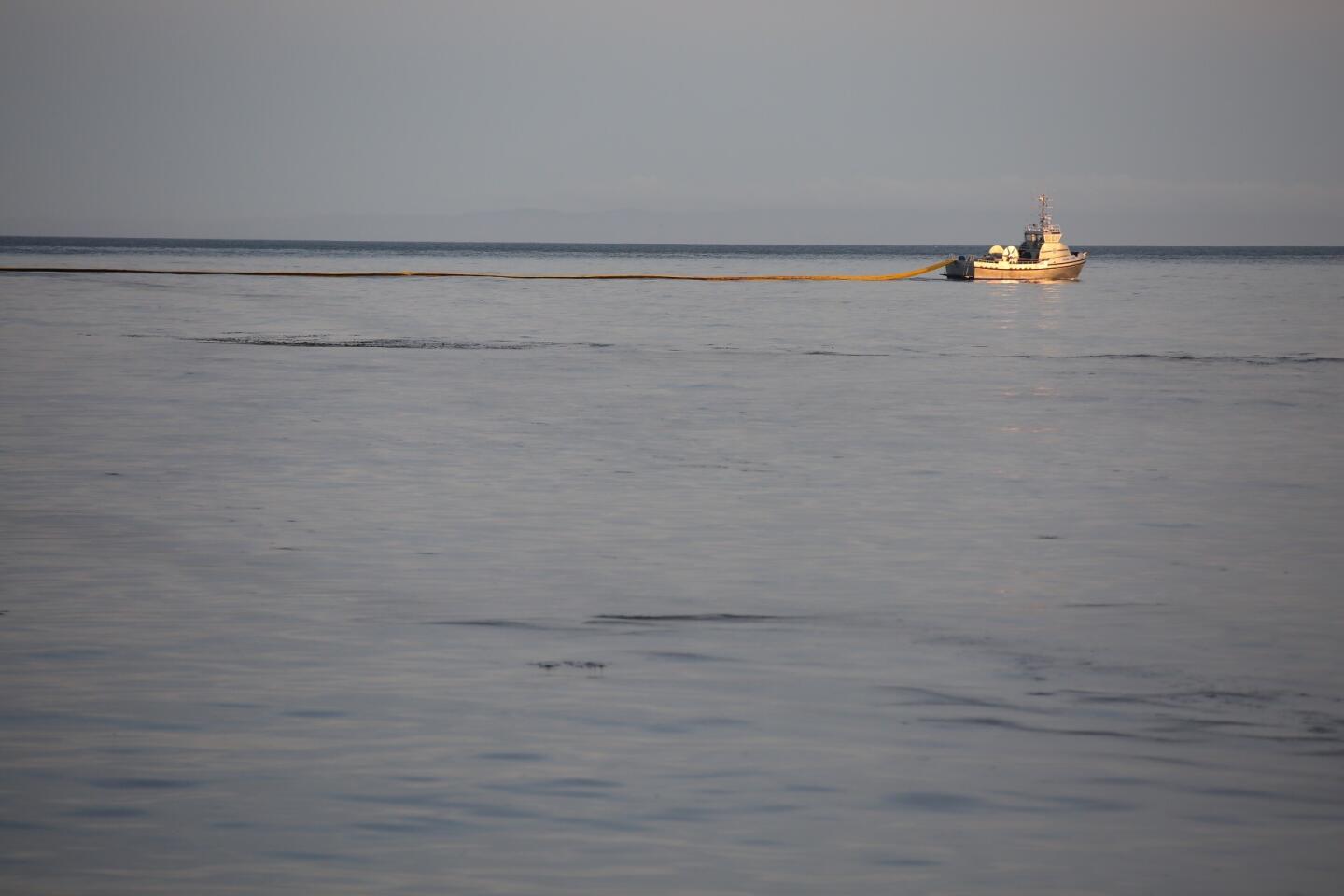
Boom ships work to contain oil offshore at Refugio State Beach just north of Santa Barbara.
(Al Seib / Los Angeles Times)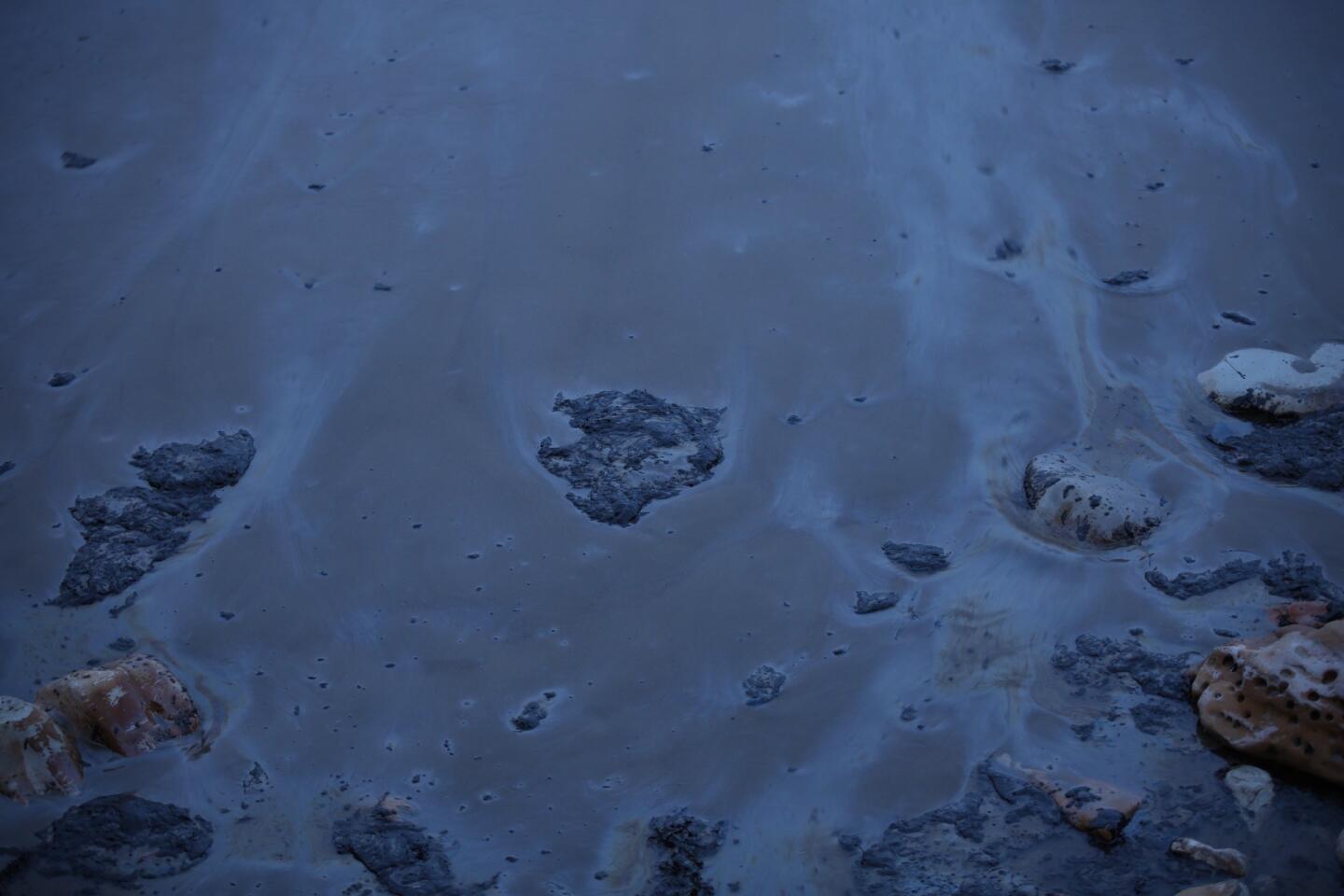
Oil-coated rocks glisten on the shoreline at Refugio State Beach after 21,000 gallons of crude oil spilled.
(Al Seib / Los Angeles Times)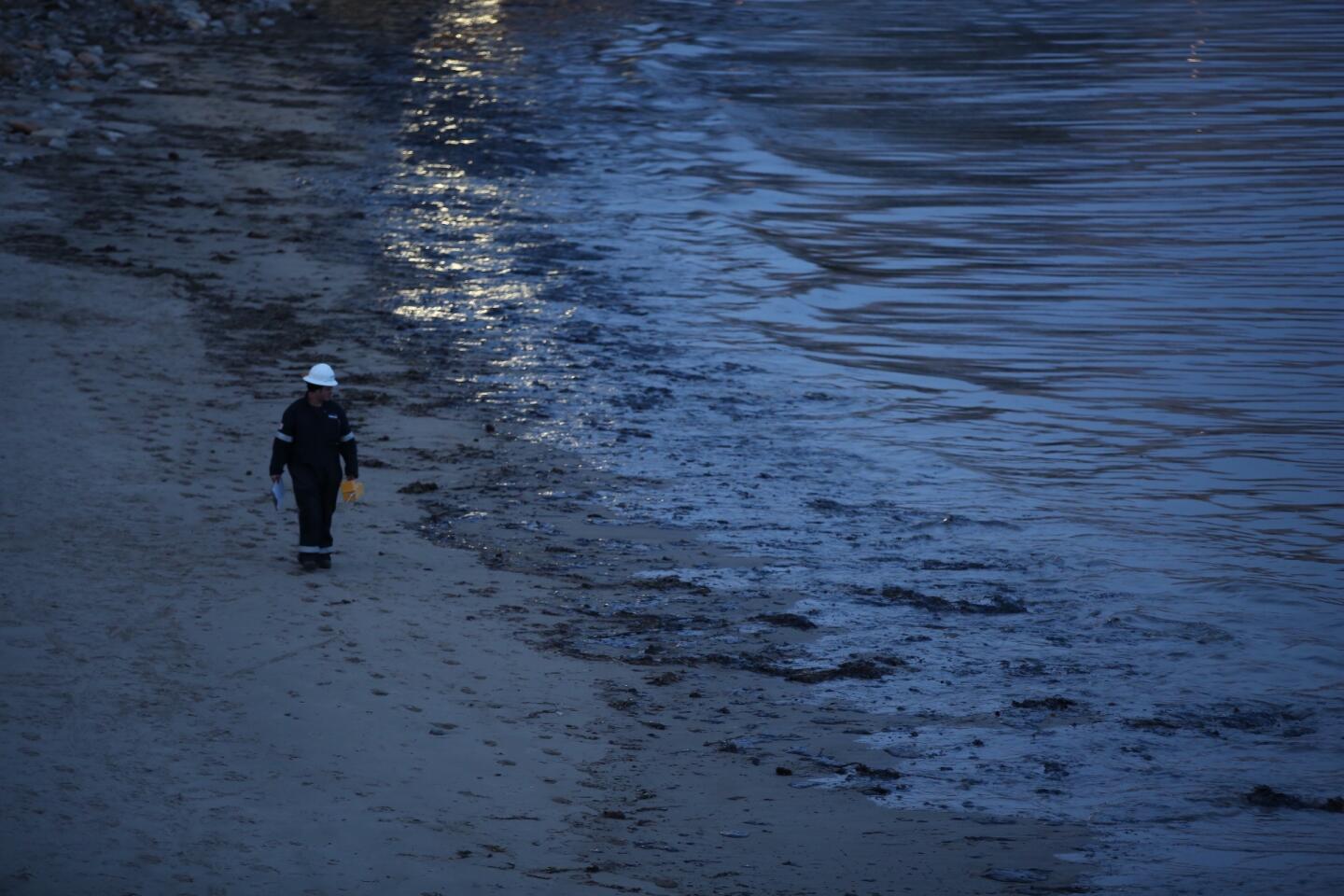
Authorities inspect the oily shoreline at Refugio State Beach.
(Al Seib / Los Angeles Times)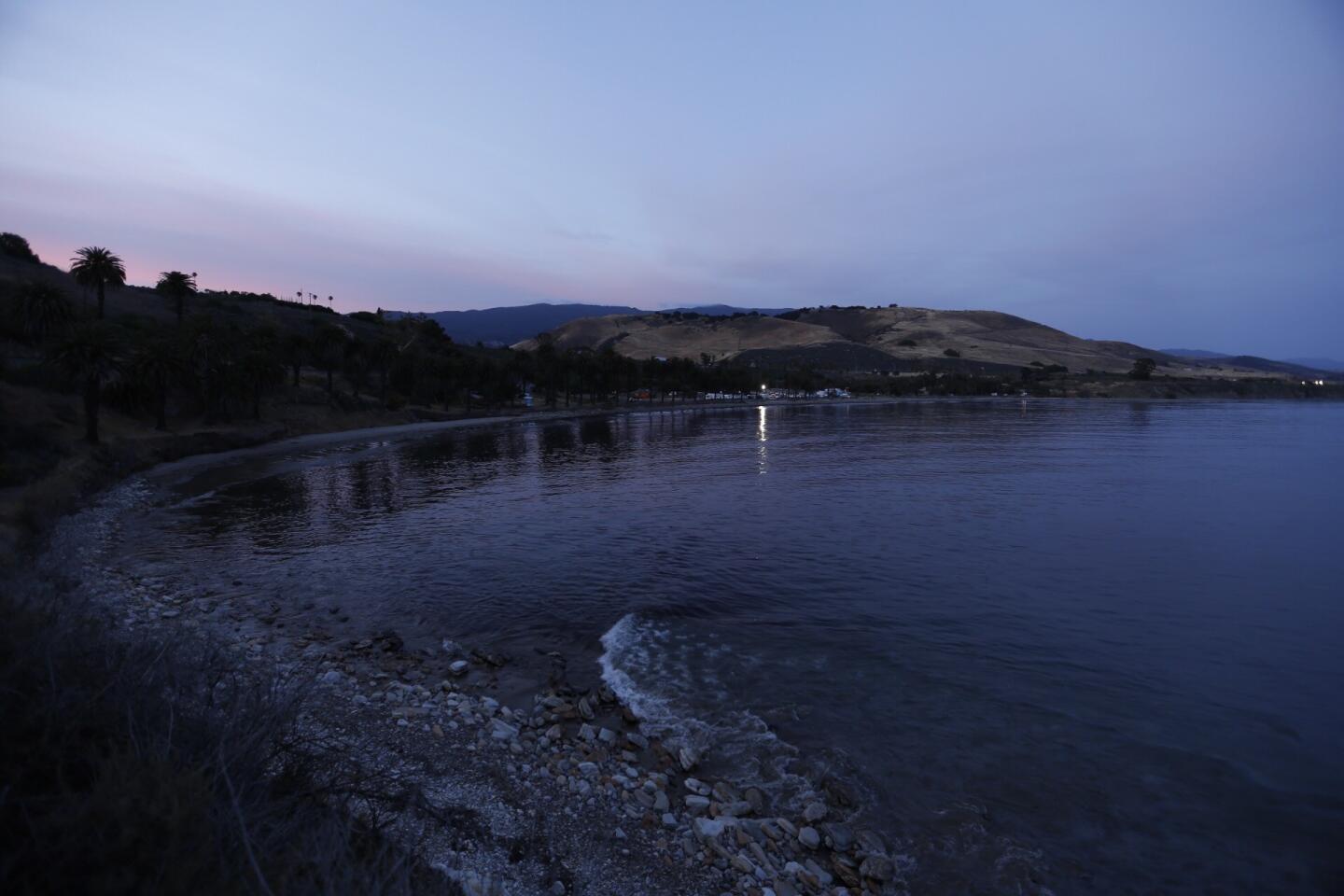
A cleanup operation is underway after a ruptured pipeline near Santa Barbara leaked an estimated 21,000 gallons of crude oil Tuesday.
(Al Seib / Los Angeles Times)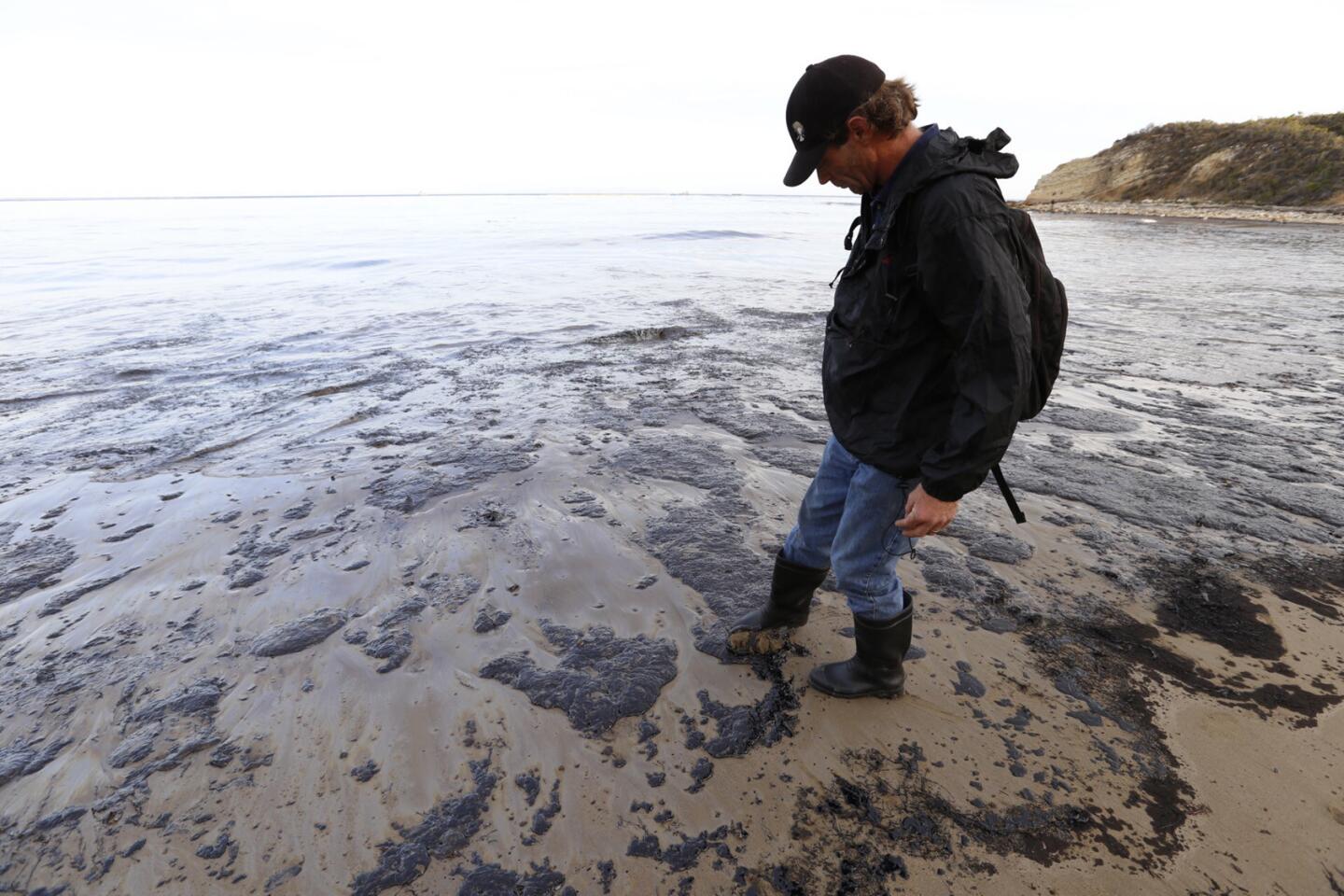
Longtime Santa Barbara resident Morgan Miller on May 19 walks on oil-coated sand at Refugio State Beach looking for wildlife to rescue. Emergency officials and Exxon Mobil were responding to a ruptured pipeline that was leaking crude oil into the ocean, authorities said.
(Al Seib / Los Angeles Times)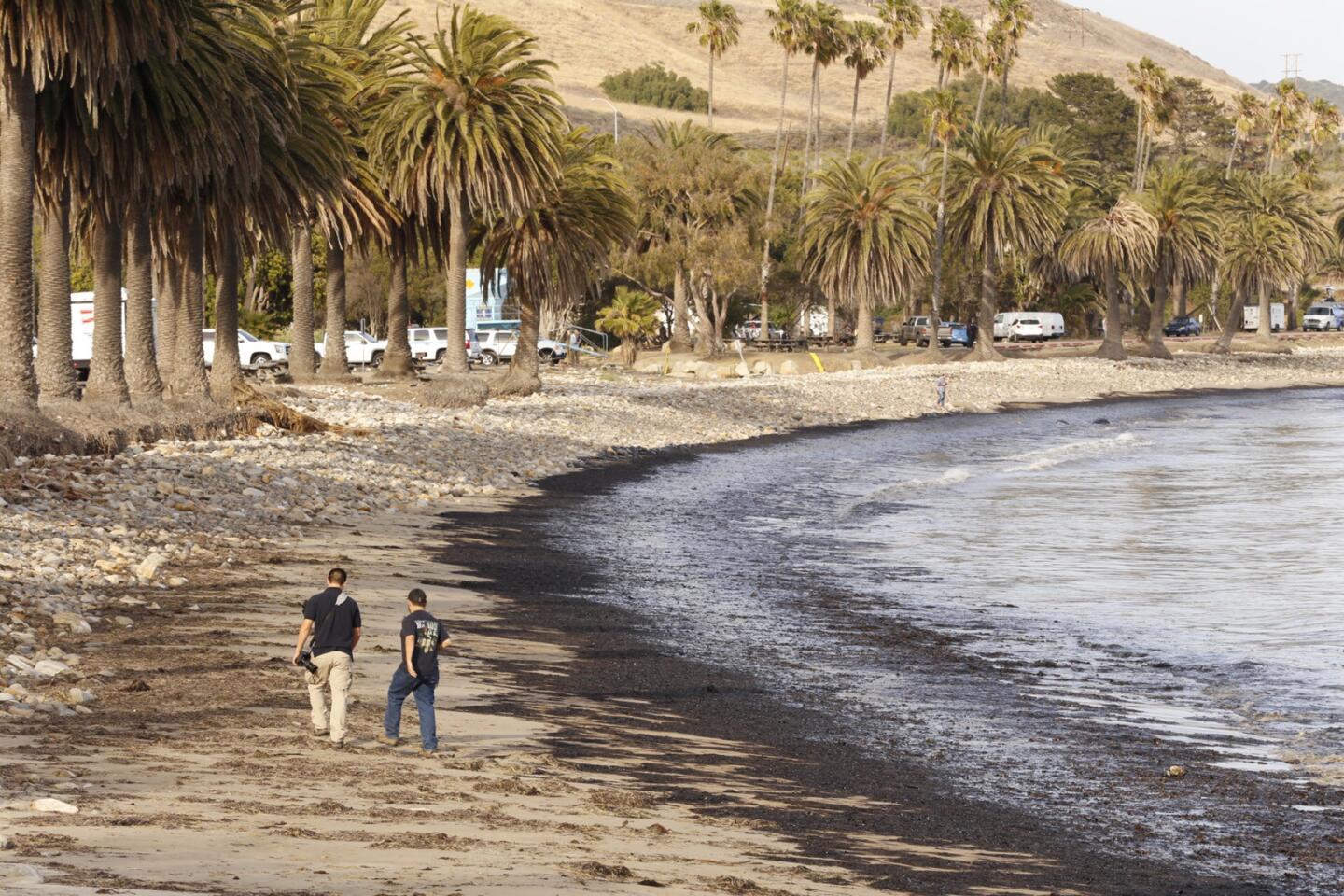
Diego Topete, left, and Ryan Cullom at Refugio State Beach. The oil spill left a 4-mile-long sheen extending about 50 yards into the water.
(Al Seib / Los Angeles Times)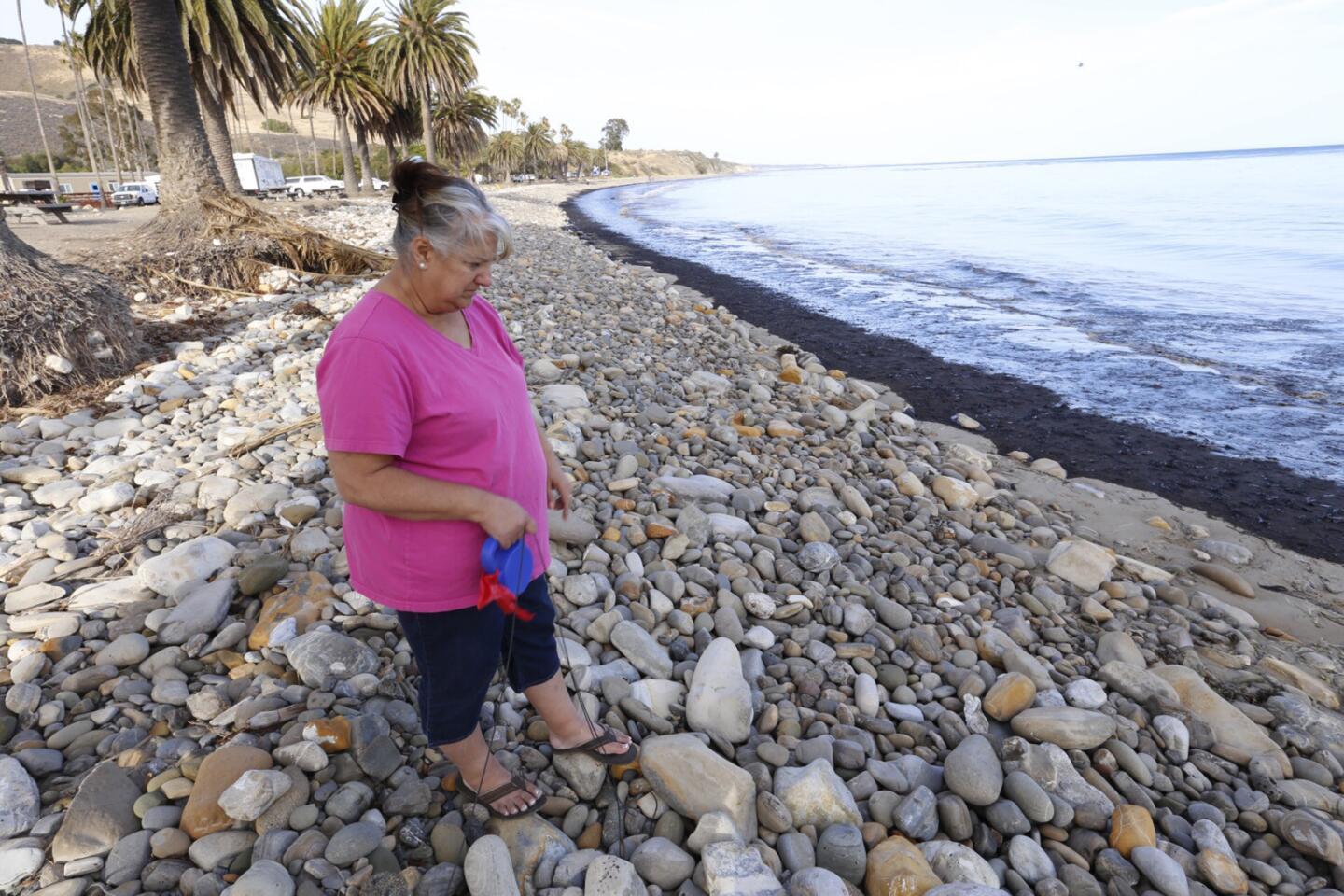
Alice Phillips, who lives near San Diego, looks at the oil-coated beach. Coast Guard crews stopped the leak by 3 p.m., an official said.
(Al Seib / Los Angeles Times)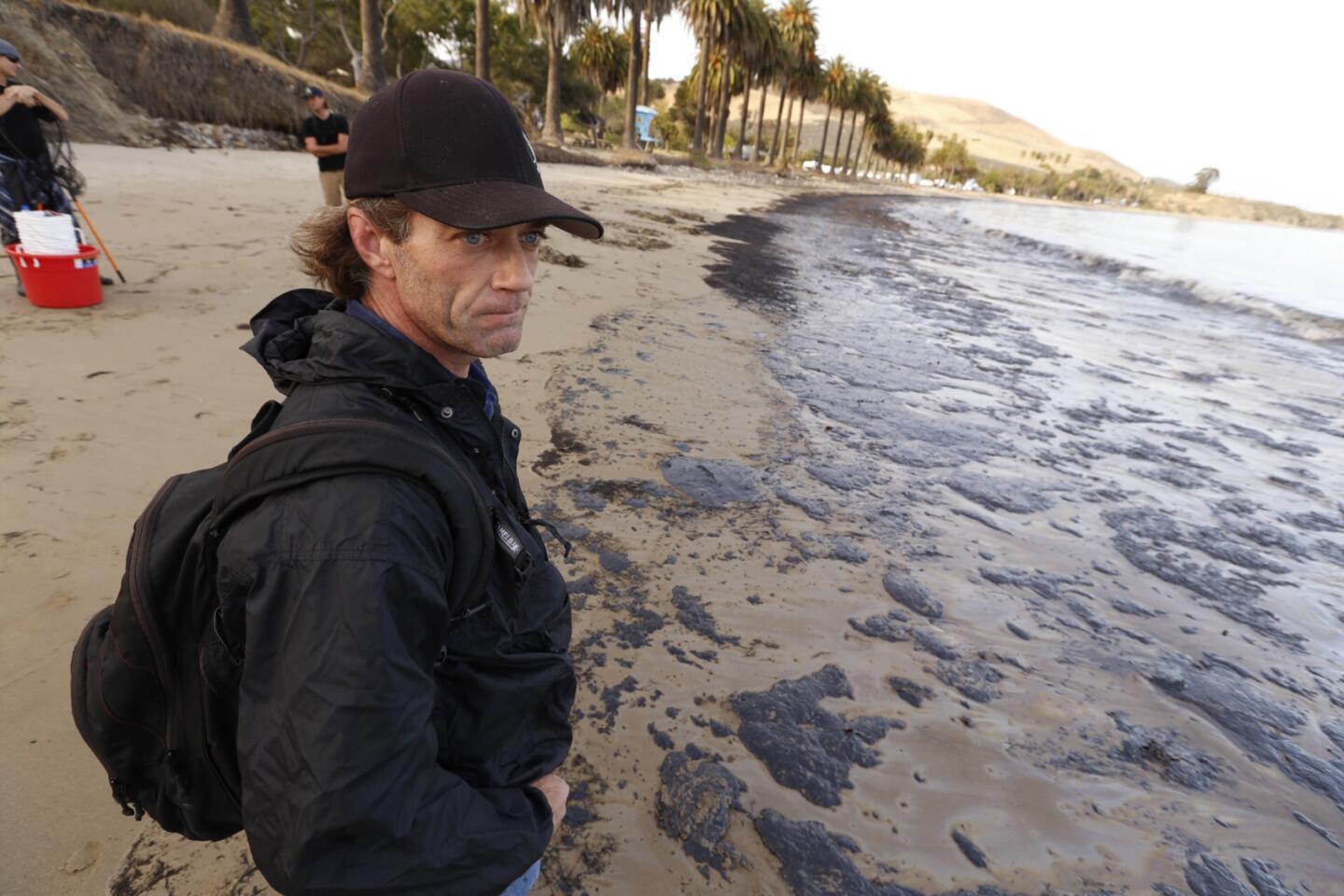
Morgan Miller looks at the devastation. The pipeline rupture leaked an estimated 21,000 gallons of crude oil.
(Al Seib / Los Angeles Times)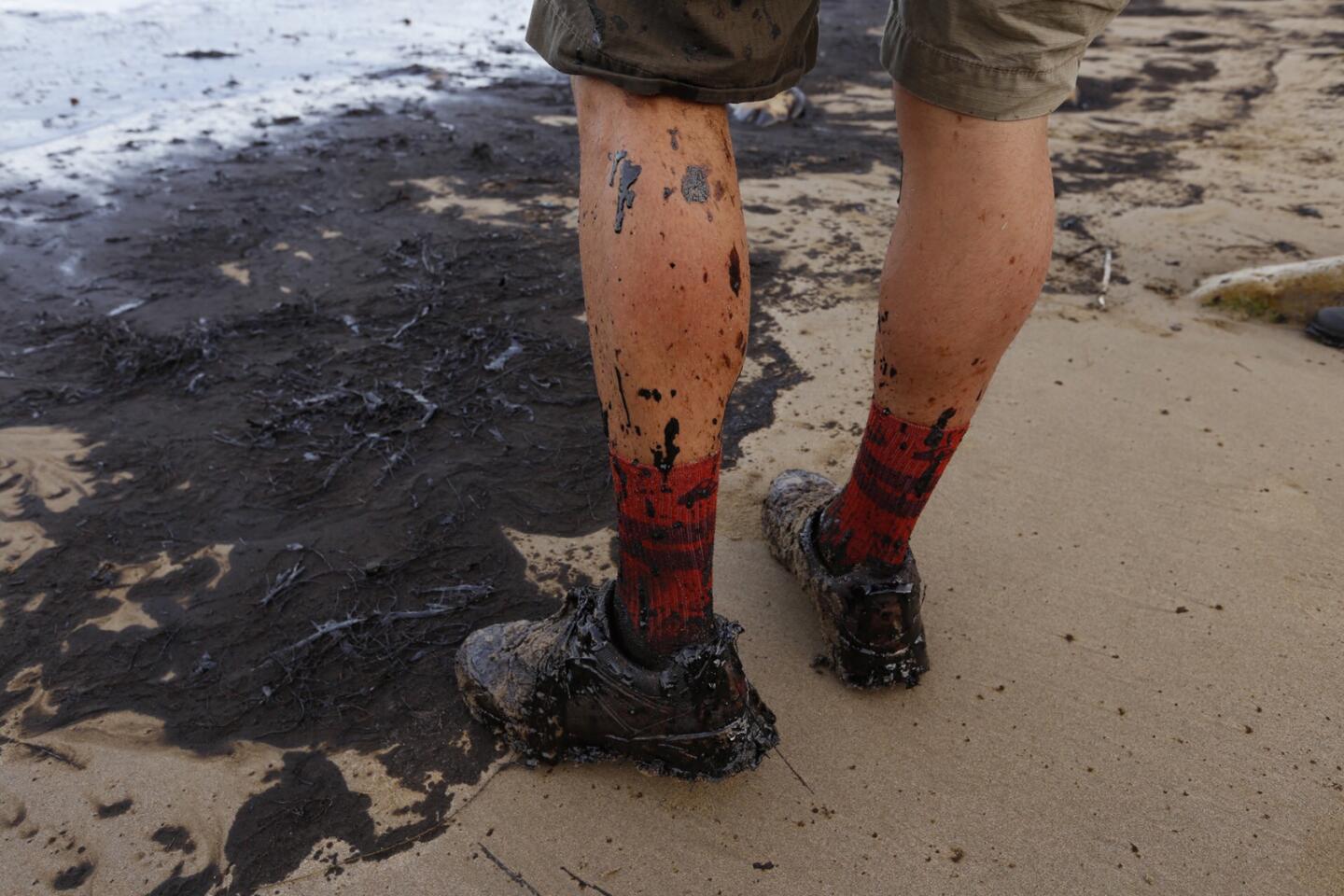
Jake Lee of Santa Barbara looks for wildlife to rescue.
(Al Seib / Los Angeles Times)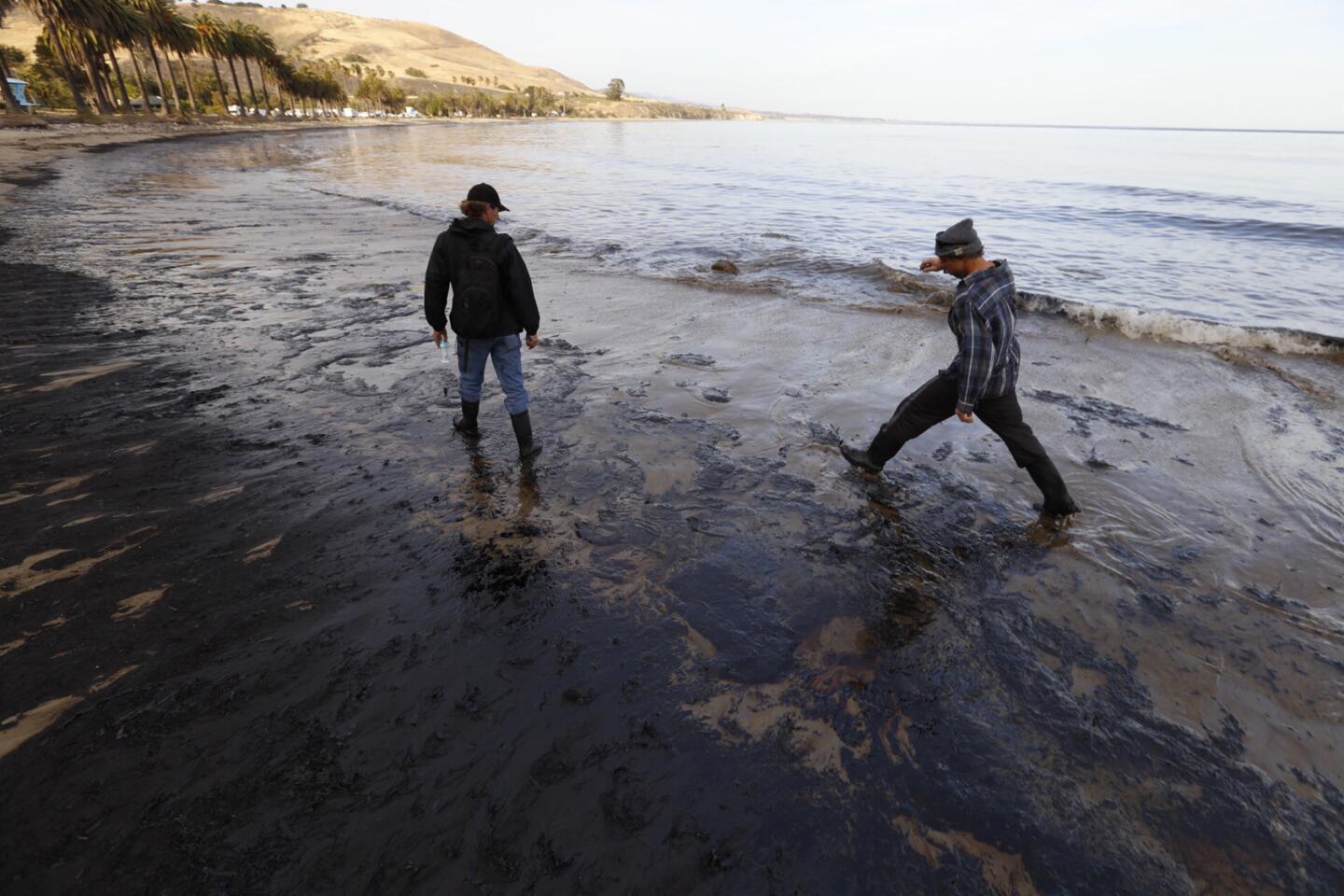
Miller, left, and Josh Marsh, also of Santa Barbara, search of wildlife to aid.
(Al Seib / Los Angeles Times)A Plains All American Pipeline oil spill off the Santa Barbara County coast this year may have been bigger and costlier than originally expected, the company said in its quarterly earnings update Wednesday.
The May 19 spill could cost the Texas company as much as $257 million in response and cleanup costs, assessments and fines, and legal settlements, the company stated. Also, as many as 143,000 gallons of crude may have been spilled when the line ruptured, not 101,000 gallons, as Plains originally estimated.
The company did not provide a new estimate on how much of that oil ended up in the Pacific; the original estimate was 21,000 gallons.
The spill occurred when a corroded section of a 10.6-mile pipeline that runs parallel to U.S. 101 ruptured, sending crude flowing down a culvert to the ocean.
Oil heavily coated a stretch of the Gaviota coast and forced the closure of Refugio and El Capitan state beaches. El Capitan reopened in June.
Small tar balls from the spill made their way as far south as Redondo Beach in Los Angeles County.
Hundreds of sea birds and mammals, many coated in crude, washed up in the spill area in the weeks following the spill.
The company refined its estimate after flushing 26,500 barrels of oil (or 1.1 million gallons) from the pipeline and realized its initial calculation may have been too low.
Plains has tapped an outside party to analyze the company’s data to get a more precise estimate of the spill’s total, according to Tuesday’s update.
Time staff writer Javier Panzar contributed to this report.
For breaking California news, follow @JosephSerna.
More to Read
Sign up for Essential California
The most important California stories and recommendations in your inbox every morning.
You may occasionally receive promotional content from the Los Angeles Times.
Joseph Serna is a deputy editor on the Fast Break team at the Los Angeles Times and helps oversee daily breaking news coverage.
